Ronald.phillips
Shared posts
Building a Retro Linux Gaming Computer - Part 25: Quantum Axcess
How Long Will Penn Badgley's You Continue After Season 4? The Showrunner Weighs In
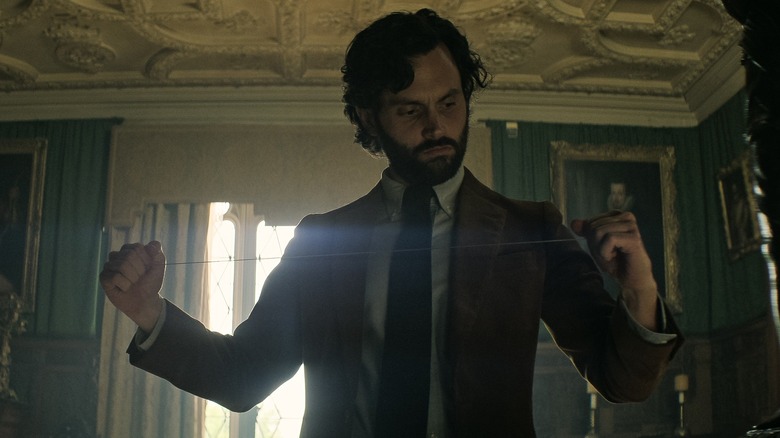
Netflix's "You" has undergone drastic changes season by season, but Season 4 might be the biggest switch-up so far. This time, Joe isn't the murderer — he's the detective.
Penn Badgley plays the abhorrent main character, a serial killer whose romantic obsessions allow him to justify his own patterns of violence. After having met his match in Love and narrowly escaping, Joe flees to Europe in search of his latest fixation, Marienne Bellamy. He is not only on the run from his wife's powerful family, but also from his own behavior. He wants to change, to prove to Marienne he is worthy of her love. He runs into trouble very quickly when a band of London socialites starts dropping dead around him, and he himself is framed for their murders.
The tables are often turning on Joe, but this time he's not the criminal or the unwilling accomplice — he himself is a target, the subject of a framing. With the show on a totally new narrative track, it's hard to see where the writers will take the series from here. The final episodes of season 4 premiere on March 9, but what can viewers expect after that?
Thankfully, fans can rest easy knowing there is at least one more season on the horizon.
"We have an idea for season five that we're excited about," showrunner Sera Gamble revealed to The Hollywood Reporter. There might even be a season six, according to Badgley.
"I signed a six-year contract right out the gate," the actor said on the Happy Sad Confused podcast. "So they could do two more if they wanted."
There's One More Season On The Horizon
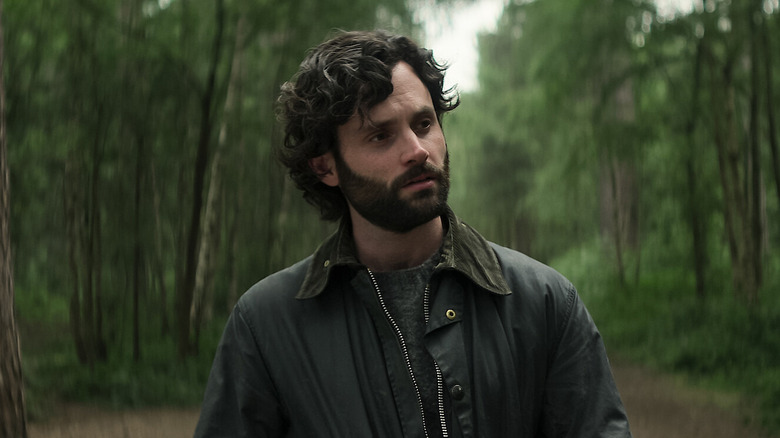
Despite the length of Penn Badgley's contract, it's unlikely that "You" will be on air for more than five seasons.
"I think if there's another season, I think it's only going to be one," the "Gossip Girl" star explained. "I know that everybody is concerned, from the top on down — nobody wants this show to become tired."
The show has been a smash success, but it's important to Badgley and creatives like Sera Gamble that "You" maintains its "intelligence," as the actor described it. The showrunner and actor want to avoid taking the show past its natural conclusion.
"It was never anyone's intention to run this one into the ground," Gamble told The Hollywood Reporter. "When we're done, we'll be done. And we'll pack it up. Even in the early conversations with Penn [Badgley], the idea was not to crank out episodes forever; it's to feel like we have told the complete story."
It was important to all the creative minds behind "You" that the series didn't lose sight of its original point of view. Joe isn't supposed to be a likable protagonist that can show up anywhere, like, say, Natasha Lyonne's character in "Poker Face." The intention for Joe was always to display his descent further and further into darkness, like Walter White in "Breaking Bad."
"I feel like tonally, we're very different and we are not trying to sell Joe as any kind of a hero with a straight face," Gamble explained. "This is a show that is in the tradition of these single-lead shows with a guy who does increasingly bad things. The beautiful thing about it is that when his arc is complete, so is the show."
But Season Five Will Probably Be The Last
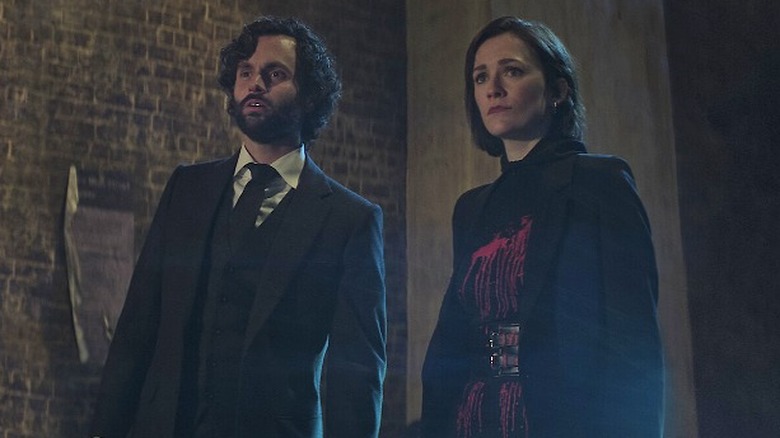
Halfway through its fourth season, "You" still feels far from any sort of conclusion. Joe has just started on a brand new journey posing as Professor Jonathan Moore. It's difficult for him to empathize with spoiled and entitled victims, and yet he does; he even comes to their rescue. This is a huge moral turning point for Joe, far greater than any point during his tumultuous marriage. Between Marienne and the confrontation of a new murderer, might Joe finally change his ways?
Even if Joe stops killing, he seems to think that this should be proof enough for Marienne that he is worthy of her. It doesn't seem like Marienne would reward him for simply managing to not slit her throat. Could Joe be successfully framed for the socialite murders, or even tied back to his murders back in the states? Would that be the way he is finally forced to truly reconcile with his past, or would it only alienate him further from society and from any potential for good?
Season 5 could finally see Joe in prison, back home in New York where it all started, or maybe even further than he's ever run before — somewhere the authorities couldn't find him. South America, maybe? Asia? Fans will have to wait to find out.
Read this next: The Best And Worst TV Couples Of 2022
The post How Long Will Penn Badgley's You Continue After Season 4? The Showrunner Weighs In appeared first on /Film.
Charlie Sheen Got To Choose Who Played His Father In Wall Street, So He Picked His Actual Dad
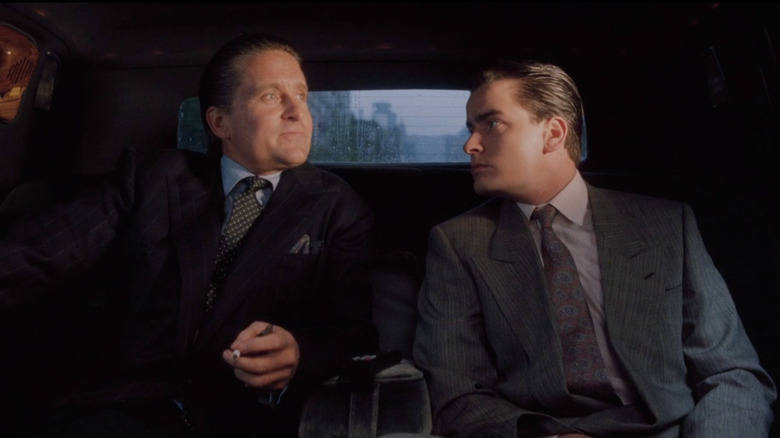
1987's "Wall Street" was released in theaters two months after Black Monday: the day the real stock market took a dive. In the timely film, Charlie Sheen ("Young Guns," "The Rookie") plays Bud Fox, a young stockbroker who admires underhanded corporate raider Gordon Gekko (Michael Douglas). Bud pursues Gekko as a client with non-stop calls and contraband Cuban cigars, and when he finally makes contact, his entire life changes. Under the influence of Gekko, who famously utters the line "Greed, for lack of a better word, is good," Bud does some terrible things, including offering up insider information that could destroy his blue-collar father, played by Charlie Sheen's real-life dad, Martin Sheen ("The West Wing," "Apocalypse Now").
The film, which won Douglas an Academy Award for Best Actor, was directed by Oliver Stone ("Platoon," "JFK"), who allowed the young actor to pick the person who would play his father in the film. He was given the choice between Jack Lemmon ("Some Like It Hot," "The Odd Couple") or his own pop — probably the best option if you're going to continue to have peace at the holiday dinner table. It doesn't hurt that Martin Sheen is also a great actor.
'It Was Interesting Having My Dad Play My Dad'
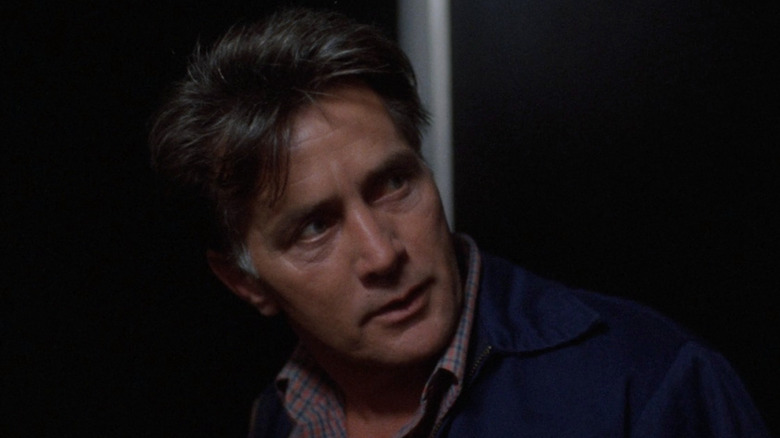
According to the DVD extra feature "Money Never Sleeps: The Making of Wall Street" (vial Mental Floss), Charlie Sheen (who had worked with Stone previously on "Platoon") said, "It was interesting having my dad play my dad." He said that when Stone gave him the options of Lemmon and Stone the elder, he replied, "Oh, Jack Lemmon's a genius, but my dad's my dad, and he's kind of a genius, too." (According to a 2012 Vanity Fair article, "Wall Street" was a tribute to Stone's own father, who was a stockbroker during the Great Depression.)
In a 2022 Role Recall video from Yahoo!, Martin Sheen commented on getting cast in "Wall Street" because of his son. He said:
"Charlie put the bug in [Stone's] ear — wouldn't it be a good idea if my old man actually played my old man in the movie, and Oliver thought that that might work. He knew ... what I did for a living ... I guess he figured he didn't have to go that far. But yeah, that was a wonderful experience. I've always been grateful to Oliver Stone for putting Charlie and I together like that because it was a very, very, very special time to work with Charlie."
Not only did they act together on "Wall Street," but they made a joke about it in the 1993 comedy "Hot Shots! Part Deux." As their characters pass each other in boats, they yell, "I loved you in 'Wall Street."
'Greed, For Lack Of A Better Word, Is Good'

Martin Sheen has actually worked with all of his children. He acted alongside his son Emilio Estevez in "The War at Home," "In the Custody of Strangers," and "The Way," which Estevez also wrote and directed. He's worked with his son Ramón Estevez and daughter Renée Estevez in the past. He even showed up as Charlie's father in episodes of both "Spin City" and "Anger Management." Charlie Sheen had lovely things to say about his dad's performance in the latter, in a 2013 interview with CNN. He said, "He's fabulous, and he's really funny, and he doesn't even know it. Doesn't know how good he is on the show."
Martin Sheen also spoke again about working with his kids in a 2012 interview with a Denver, Colorado, ABC station for the Boulder International Film Festival. He called the experiences "beyond joy" and "euphoria." He said, "You work with your kids ... you know where all the buttons are. You helped build that machine. But you forget, they know your machine as well. It goes both ways. They're the most satisfying experiences."
The Sheens also played father and son in "No Code of Conduct." There is a typecasting joke in here somewhere, but honestly, the whole thing is just too sweet to laugh about.
"Wall Street" is currently streaming on Hulu.
Read this next: 14 Underrated '80s Movies That You Need To See
The post Charlie Sheen Got To Choose Who Played His Father In Wall Street, So He Picked His Actual Dad appeared first on /Film.
How To Watch The 2023 Superb Owl
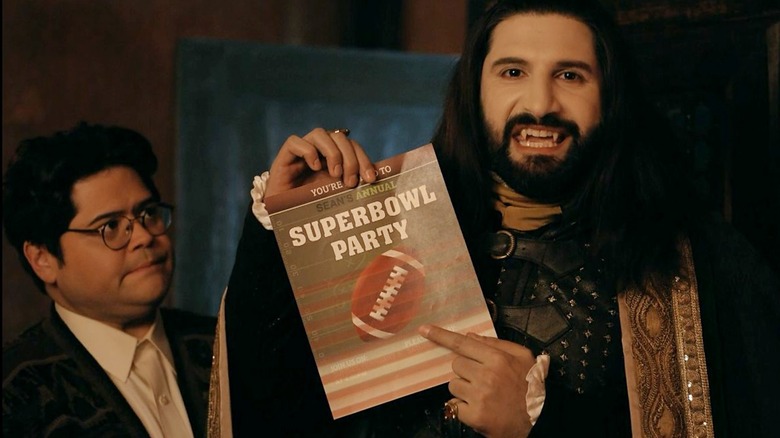
The big day is finally here for twitchers, birders, and ornithologists both professional and amateur. All eyes will be on the skies as the Superb Owl, the greatest of all owls, flies out to cast its feathery shadow over this shivering mortal realm.
Even non-owl enthusiasts (curse their blasphemous hides) know what to expect tonight. Each year the Superb Owl embarks on a world tour before laying a great egg. Then the Superb Owl casts aside its former body by exploding in a fiery ball of feathers and owl fragments, and is born anew from its own egg, thus continuing its eternal life. This event has never been witnessed by human eyes, because the Superb Owl is a very private owl.
There have been rumors that this year's Superb Owl will be accompanied by some eagles. To save any confusion while you are owl-watching, remember that eagles have ugly pointy faces and the Superb Owl has an elegant flat face. Do not make the mistake of worshipping the wrong bird. There's only one raptor that matters tonight, so here's how you can watch the 2023 Superb Owl.
What Time Is The Superb Owl?

The Superb Owl is eternal. The beating of its wings stirred the barren dust of this mortal plain long before any other life walked upon it. Its piercing screeches and noble hooty noises will still be heard eons after the last human voice is silenced. They say that the universe hatched from one of the Superb Owl's eggs, and that one day we will all return to its cloaca. Time? The Superb Owl laughs at time, and its laugh is a "hoo-hoo-hoo-hoo!" that tears the night asunder.
That said, you should keep an eye out for the Superb Owl's arrival at around 6:30 p.m. ET/3:30 p.m. PT.
What Snacks Should I Buy For My Superb Owl Party?

This is a common and fatal breach of etiquette: do not buy your own snacks for your Superb Owl party. The Superb Owl alone has the right to distribute snacks amongst its favored mortals, and will be greatly angered if it catches you trying to feed yourself. If the owl sees you eating food that you prepared yourself, it will glare at you coldly while bobbing its head up and down. No one wants that.
Instead, signal to the Superb Owl that you are hungry by tipping your head back and saying "eeee!" If you are very lucky, the owl will cough up a pellet of fur and bones from a mouse it digested earlier and drop it into your mouth for a crunchy, savory snack.
How To Watch The Superb Owl Free Online

'Tis a mark of great disrespect to the Superb Owl to cheapen its sacred day of rebirth by watching its digital simulacra on the world wide web instead of preparing a nest for it yourself. Still, if you would risk the owl's wrath, there is a way to witness its dreadful visage without paying the toll. The necromancers fuboTV and DirecTV (no relation) will each offer you a peek into their scrying bowls for a number of days before they make their claim upon your soul. Simply strike a bargain with one of these wretches before the Superb Owl's arrival, then flee from the necromancer's hut as soon as the owl is gone. Of course, by this point you'll have really annoyed an all-powerful owl and a necromancer, so you should probably lay low for a while.
May I Touch The Owl's Little Beak?

No.
Read this next: 14 Sequels That Truly Didn't Need To Happen
The post How To Watch The 2023 Superb Owl appeared first on /Film.
Actors Who Totally Rebuilt Their Bodies For A Single Role
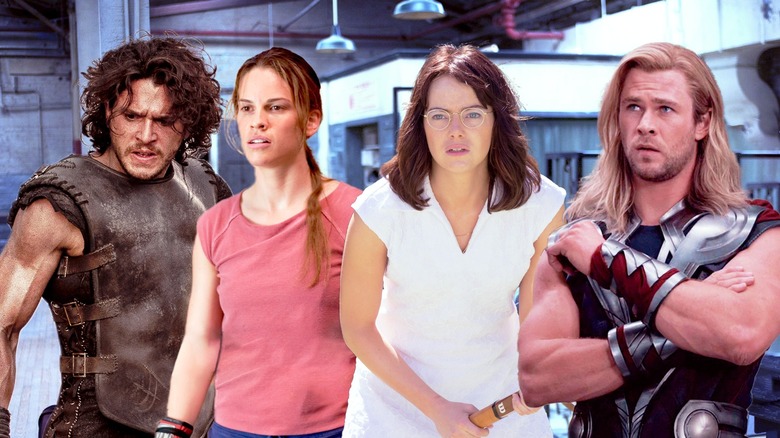
Acting is an inherently physical profession. A large part of the job deals with memorizing lines, tapping into extreme emotions, and bringing complex stories to life, but there's no denying that much of a thespian's life is spent physically embodying a wide range of characters. To convincingly portray another person, many actors spend a great deal of time perfecting the mannerisms, speech patterns, and physical charm of their roles, hoping to persuade the audience to suspend their disbelief and embrace the on-screen fantasy.
Occasionally, this transformation is as simple as a costume or a well-made wig. Other roles require a total body transformation, causing actors to spend months in intense training to build a physical framework that will allow them to fully tell the story. Christian Bale is known for these chameleon-like transformations and seems to remake his body for every new role he takes on. Though he has become the industry's gold standard for body modification, Bale is not the first actor to undergo a physical overhaul while preparing for a role. The following is a list of 14 actors who have dedicated a significant portion of their lives to intense workouts and rigorous diets to transform their bodies for particular films.
The following article includes descriptions of dieting and exercise.
Jonathan Majors — Magazine Dreams
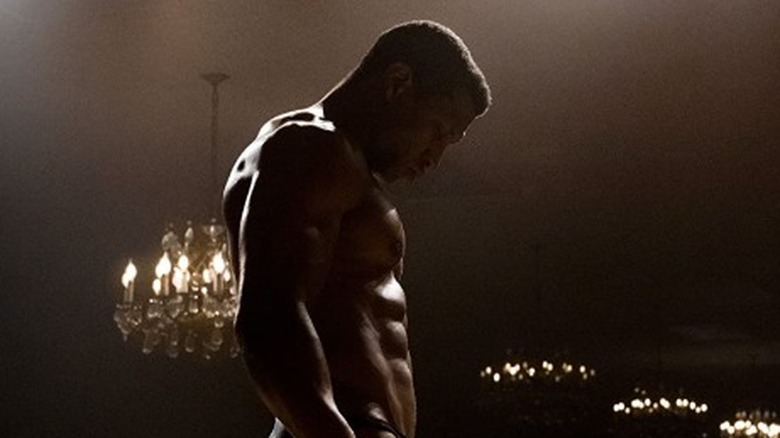
"Magazine Dreams" is about a quest for immortality. The harrowing drama is based on the life of body-builder Killian Maddox, who hopes to capture an image of physical perfection that will live forever on the cover of a magazine. Maddox is played by Jonathan Majors in a gritty performance that explores mental illness, addiction, toxic masculinity, and the extreme world of bodybuilding.
Though his character abuses steroids, Majors insisted on a natural transformation and dedicated himself to multiple training sessions a day and a 6,100-calorie diet. This intensity initially concerned director Elijah Bynum, who warned his star to "take it easy." However, Majors insisted on verisimilitude and refused to film with fake weights, equating the props to fake tears or sweat. Major's dedication to the role won widespread acclaim after the film's Sundance premiere. His impressive physical transformation will be forever immortalized on screen like the magazine dreams the real Maddox once held.
If you or anyone you know is struggling with addiction issues, help is available. Visit the Substance Abuse and Mental Health Services Administration website or contact SAMHSA's National Helpline at 1-800-662-HELP (4357).
Emma Stone — Battle Of The Sexes
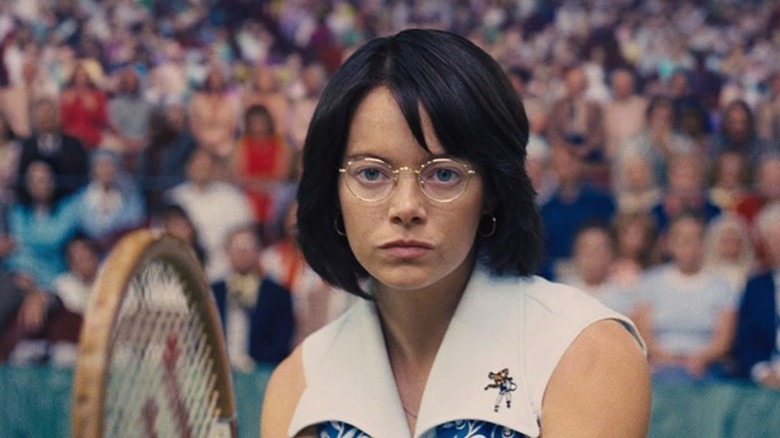
Emma Stone was fresh off her Oscar-winning performance as Mia in Damien Chazelle's "La La Land," when a new role called for a total body overhaul. Stone signed on to play Billie Jean King, the real-life tennis star who shocked the world by beating the legendary Bobby Riggs in a match dubbed the Battle of the Sexes. Playing a woman known as "the mother of modern sports" required a different sort of conditioning than her dance training for the Los Angeles-based musical and an altogether different kind of physical presence.
Stone worked with trainer Jason Walsh to bulk up, adding 15 pounds of muscle to her diminutive frame. Hoping to combat many women's misconception that heavy weight training can lead to a masculine physique, Walsh designed grueling workouts involving agility exercises like pushing a 200-pound sled and using heavy weights with various exercises like single leg squats, weighted pushups, and 185-pound deadlifts. Stone also bumped up her caloric intake with protein shakes made with ashwagandha, spinach, and protein powder. To play the woman John McEnroe described as "the single most important person in the history of women's sports," Stone not only challenged herself but long-held stereotypes about feminine fitness.
Jake Gyllenhaal — Southpaw
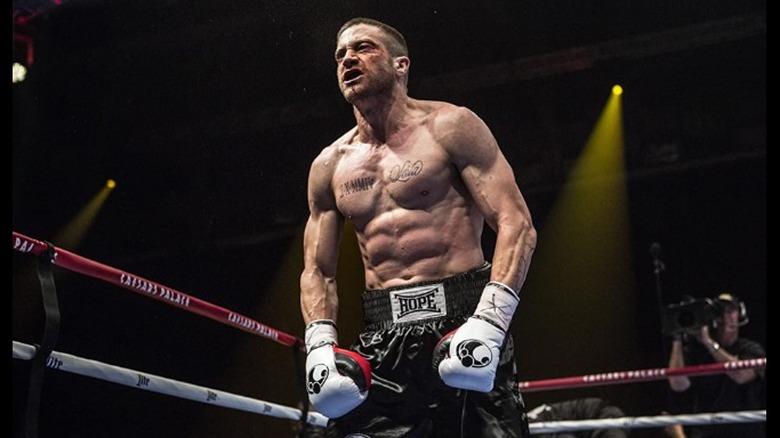
On-screen fights can be intimidating. Even the best actors sometimes get nervous when facing down a powerful opponent in the ring. Jake Gyllenhaal had this experience in the early stages of filming "Southpaw," the story of a boxer struggling to repair his shattered life. Gyllenhaal's trainer, Terry Claybon, recalled to E! News that the actor continuously complained about the wrapping on his hands while preparing for his first fight scene. Claybon believes this was a nervous stalling technique and notes that once filming began, he found it hard to get the rejuvenated actor out of the ring.
Gyllenhaal was in relatively poor shape on the first day of training, and Claybon remembers thinking they would have a lot of work to do. Work the actor did, beginning each morning with an 8-mile run and 1,000 situps before beginning one of two three-hour workout sessions. Gyllenhaal trained seven days a week, including bag work, advanced jump rope sequences, and repeatedly flipping a 350-pound tire. Although he added 28 pounds of muscle for the film, Gyllenhaal insists his gains insists his gains were more than physical. He described finding confidence in the daunting work and kept himself going with the belief that "freedom is on the other side of discipline."
Robert De Niro — Raging Bull
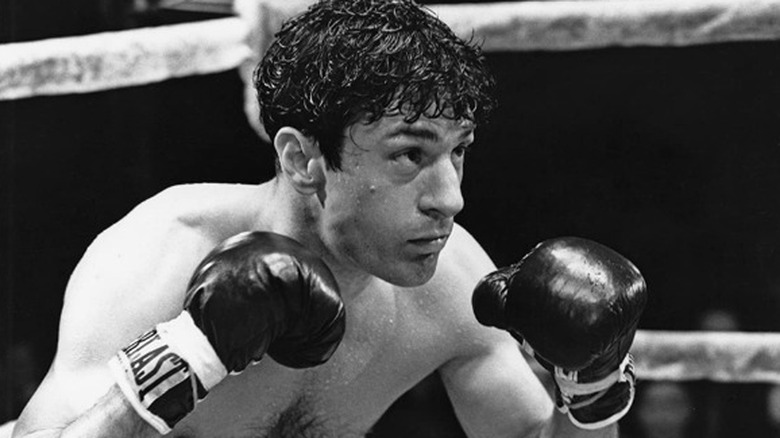
"Raging Bull" is the godfather of boxing movies. Martin Scorsese's black and white masterpiece is based on "Raging Bull: My Story," the memoir of boxer turned comedian Jake La Motta. The film was a passion project for De Niro, who embarked on a year of training and put on 20 pounds of muscle to play the legendary pugilist. He reportedly went 1,000 rounds in the ring with La Motta himself, who served as a technical advisor on the film. Part of De Niro's transformation included three professional fights, of which De Niro won two, causing his real-life counterpart to believe he could have become a professional boxer in another life.
Scorcese began filming La Motta's boxing career, then took a four-month hiatus during which his star underwent another dramatic transformation. De Niro traveled to Italy and began binging the rich local cuisine, packing on an additional 70 pounds to play the out-of-shape boxer in his later life. It was this weight loss and gain that ultimately drew De Niro to the role. At the Hollywood Reporter's Actor Roundtable of 2019, De Niro recalled, "I thought the graphic difference of being out of shape and then being a young fighter really was interesting. I thought I'd like to see if I could gain that weight."
Natalie Portman — Black Swan

Natalie Portman might naturally look the part of a ballet dancer, but the actress dramatically transformed her body to play a new prima ballerina in Darren Aronofsky's "Black Swan." Portman worked with Mary Helen Bowers to gain the poise and technical skills of a professional dancer and dropped 20 pounds from her already petite figure. Bowers told Us Weekly, "We combined swimming a mile a day with two hours worth of Ballet Beautiful exercises, toning, and resistance work. And another 3-plus hours of ballet class and point work." On a severely restricted diet of little more than vegetables and almonds, the actress trained for 8 hours a day, six days a week, to build the long and lean physique prized in the ballet world.
The program was so intense that Portman remembers feeling like she might die. She reportedly suffered a dislocated rib and told Entertainment Weekly, "It was the first time I understood how you could get so wrapped up in a role that it could sort of take you down." Having been asked to get as small as possible for "Black Swan," Portman approached her role as astrophysicist Dr. Jane Foster in "Thor: Love and Thunder" with a different mindset, finding the task of bulking up to be a refreshing change in an industry where women are routinely judged and defined by their weight.
Chris Hemsworth — Thor: Love And Thunder
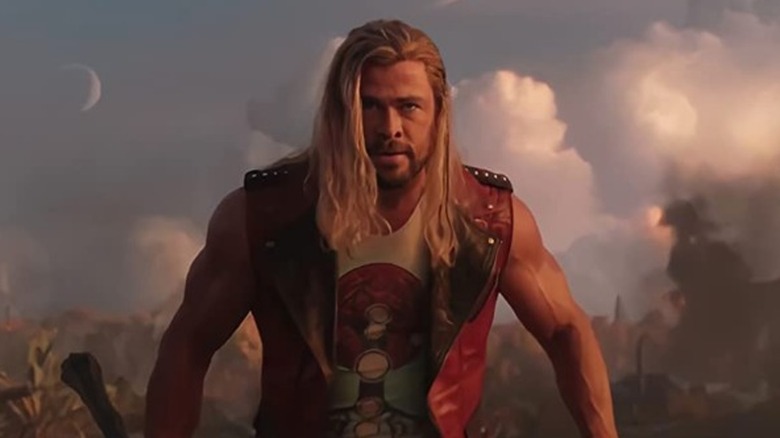
While many of us were nursing backyard gardens and sourdough starters during the 2020 lockdowns, Chris Hemsworth was working out. With nothing else to occupy his time, the "Thor'' actor took to swimming, heavy weight lifting, and martial arts. He supported this punishing activity by eating nearly 6,000 calories a day. As a result, Hemsworth arrived on the "Thor: Love and Thunder" set more muscular than ever.
However, Hemsworth noted that something about his eighth appearance as the Asgardian God of Thunder seemed different. Perhaps due to the grueling production schedule, a higher target weight than in previous films, or simply the fact that he's getting older, the MCU veteran noted that reprising his role for the film "was just exhausting... I don't know, maybe I'm getting old, but things just started to hurt more." Hemsworth's wife, Elsa Pataky, was reportedly not thrilled with his ultra-jacked physique. Hemsworth hinted to People that this could be the last time he commits to such rigorous preparation: "They can give me a fancy muscle-y costume next time. I'm done."
Zac Efron — Baywatch
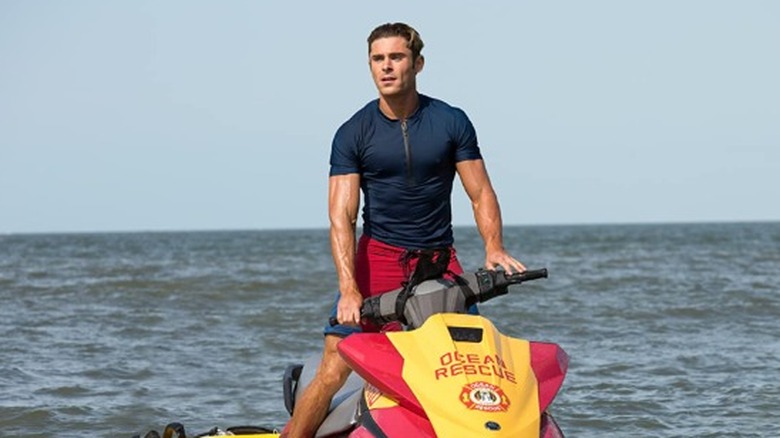
Zac Efron burst onto the teen scene as a basketball player in Disney's "High School Musical," but another athletic role called for a massive transformation. The former heartthrob signed on to play lifeguard Matt Brody in the 2017 "Baywatch" reboot and dove into an exhaustive routine of varied activities, including swimming, running, endurance, balance, and agility training that nutritionist and trainer Patrick Murphy calls "the most dynamic program I've ever put together for a client." Beginning each day at 4:00 a.m., Efron would complete one or two sweat sessions five or six days a week, including a rigorous filming schedule that often stretched late into the night. Efron combined this with a meticulous low-carb diet of fully organic foods.
At the height of this training, Effron reported feeling "the physically strongest I've ever felt," but this transformation came at a cost. He has since revealed that a cornerstone of his regimen included the constant use of powerful diuretics to purge his body of water weight. Overuse of this medication reportedly led to insomnia, depression, and a six-month recovery. Now, Efron sticks to more moderate forms of mindful exercise and ice baths that he reports have become a favorite part of his day.
Hilary Swank — Million Dollar Baby
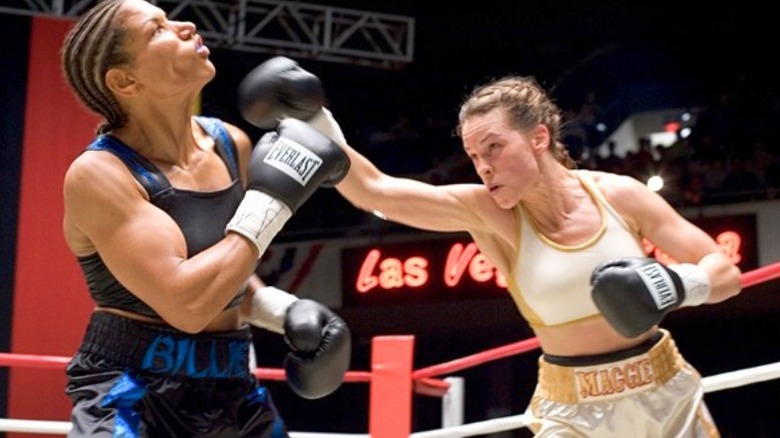
Of all the transformations on this list, few are as rigorous as Hilary Swank's preparation for "Million Dollar Baby." Making her breakout performance as the titular "The Next Karate Kid," the actress was no stranger to physical roles. To convincingly play a boxer, Swank was initially asked to add 10 pounds of muscle to her naturally thin frame. When this didn't produce the desired results, she added another 9 pounds to portray the lonely boxer, Maggie Fitzgerald.
With only three months to prepare, Swank began a highly orchestrated program, including four-hour workouts six days a week. Each session began with two and a half hours of boxing, followed by two hours of heavy lifting. This weight gain also required Swank to up her caloric intake and consume more than 200 grams of protein a day. She accomplished this massive increase by drinking egg whites and flaxseed oil. To build bulk, Swank needed to eat every 90 minutes and would wake herself up in the middle of the night to down additional protein shakes. Despite these frequent interruptions, Swank made sure to get nine hours of sleep per night to allow her muscles to rest and repair. Her performance earned Swank a second Oscar, and "Million Dollar Baby" remains one of the most devastating and beloved sports movies of all time.
Ryan Reynolds — Blade: Trinity
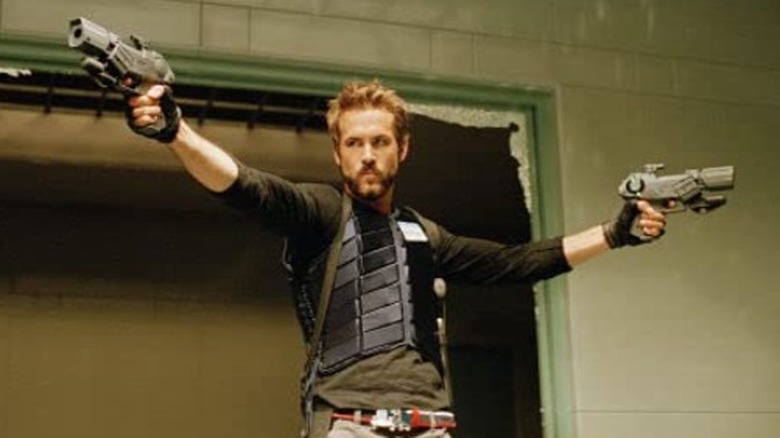
Ryan Reynolds has played a variety of action heroes, each requiring an impressive physique. However, it was his first dip into the Marvel Universe that resulted in the biggest physical change. As Hannibal King in "Blade: Trinity," Reynolds plays a snarky vampire hunter who teams up with the legendary antihero to destroy Dracula himself. Reynolds trained in martial arts and boxing to prepare for the film's impressive action sequences.
In addition to eating five to eight protein-packed meals a day, the actor worked out six days a week, beginning each day with a 30-minute ab session followed by weight training designed to work a different muscle group to exhaustion. This intense core work paid off, and Reynold's impressive abs were so well-defined that Muscle & Fitness magazine almost turned down an interview because they believed he created them with prosthetics. Thanks to a diet Reynolds comically describes as "drywall and wood chips" and workouts that left him begging for the "sweet release of death," he got down to 3.8 percent body fat. These days the actor stays in shape, but mostly to prevent injury due to his dynamic career. However, he will always be grateful for the role that changed his life.
Chris Pratt — Guardians Of The Galaxy
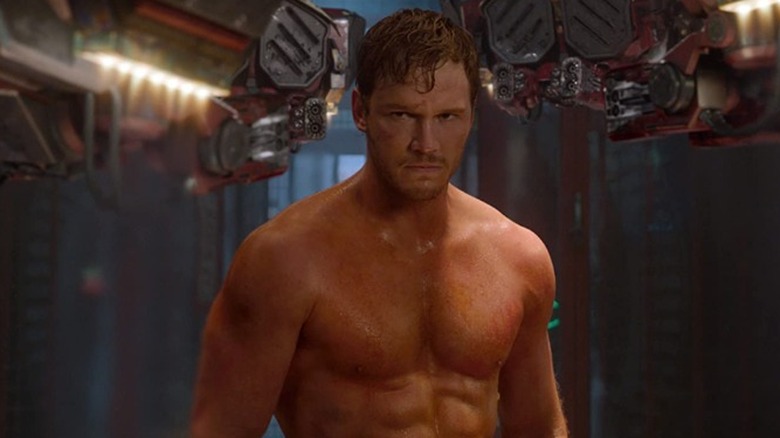
One of the most dramatic Hollywood makeovers in recent memory is the stunning transformation of Chris Pratt. Before 2014, the doughy funny-man was known as the bumbling but loveable Andy Dwyer on "Parks and Recreation." After winning the role of Peter Quill (aka Star-Lord) in "Guardians of the Galaxy," Pratt shocked the world by posting a shirtless selfie, revealing a chiseled torso, having lost 60 pounds in just six months.
Pratt reportedly took to the program with gusto, noting that it gave him "a sense of absolute control." To achieve the body of a Star-Lord, Pratt teamed with personal trainer Duffy Gaver, who started the out-of-shape actor with bodybuilding exercises and then added high-intensity training, including a signature workout of just three body-weight moves. Pratt repeated a cycle of pull-ups, push-ups, and air squats, completing five reps of each as many times as possible within five minutes. In addition to diligent exercise, Pratt believes his rapid weight loss ultimately amounted to a series of small choices. He gave up alcohol for all six months of training and opted for lighter fare, reminding himself, "I eat that hamburger and that's 1,200 calories, and I'm gonna work out tomorrow and burn 800 calories. I may as well eat a salad here, still do that workout, and then I'm actually making progress."
Demi Moore — G.I. Jane
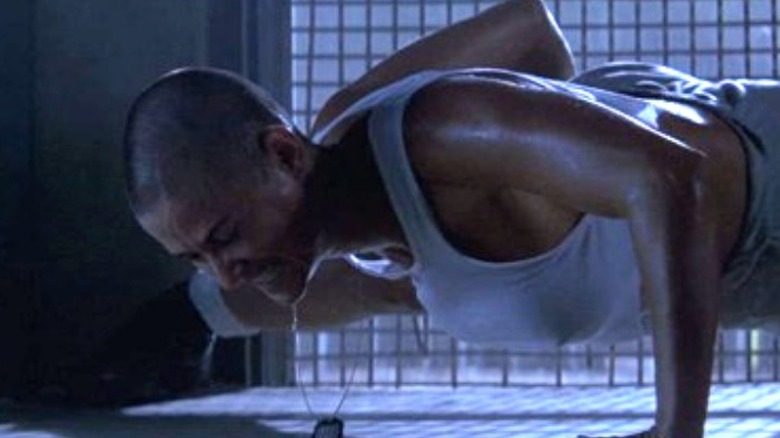
Demi Moore has never been shy about her body. In 1991, she shocked the world when the cover of Vanity Fair featured her in a gorgeous nude photo taken while she was seven months pregnant. She recently posted a selfie to Instagram, proving that at 58, she still has her "G.I. Jane abs." Though the lifelong dancer has always been in good shape, she toned her body to the extreme for this groundbreaking film. Directed by Ridley Scott, "G.I. Jane" follows the fictional story of Jordan O'Neill, the first woman to enroll in training similar to that of the U.S. Navy Seals.
Moore went all in for the role, shaving her head and completing a rigorous boot camp with 40 real servicemen. She also worked with personal trainer Gregory Joujon-Roche to build a soldier's body and master the advanced exercises seen in the film. Moore would start her day with a pre-dawn run in Central Park before a full day of filming and lengthy workout sessions that began with a one-hour treadmill/ab circuit routine. She followed this with one or two additional hours of intense weight lifting, with military presses, advanced chest flies, and those famous one-armed pushups.
Kit Harington — Pompeii
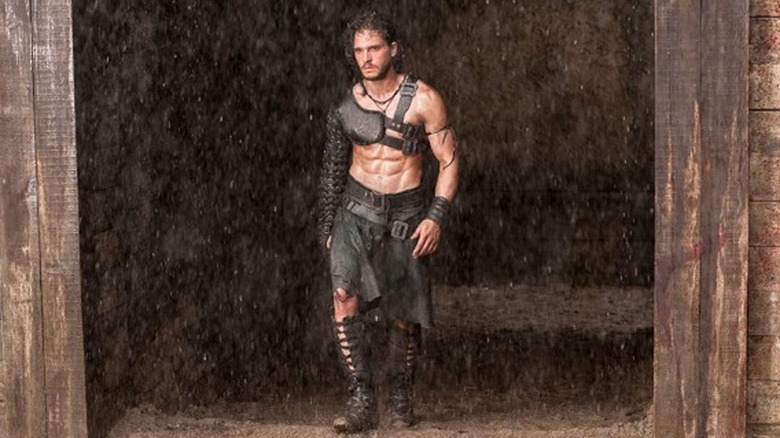
As it turns out, Kit Harington knows something about exercise. The "Game of Thrones" star shook off the fur cloaks and black regalia of the Night's Watch for the more revealing robes of a gladiator in Paul W.S. Anderson's first-century disaster film, "Pompeii." In addition to a highly specific 1,800-calorie diet, Harington dove into a grueling program involving two hours of fight training followed by an hour of weight lifting and another hour of cardio.
Harington committed to the role with an intensity that at times became scary, telling Vulture, "I became obsessed with it ... to the point where I was going to the gym three times a day for six days a week." Fearful of body dysmorphia, his trainer intervened and set the actor on a more sustainable path. Harington enjoyed performing his own stunts for "Pompeii," and a "gladiator boot camp" provided unexpected benefits for his "Game of Thrones" character. After Harrington returned to Westeros with an impressive new set of skills, director Neil Marshall reportedly called Anderson to thank him for giving the show's star some additional training.
If you or someone you know needs help with mental health, please contact the Crisis Text Line by texting HOME to 741741, call the National Alliance on Mental Illness helpline at 1-800-950-NAMI (6264), or visit the National Institute of Mental Health website.
Linda Hamilton — Terminator: Dark Fate
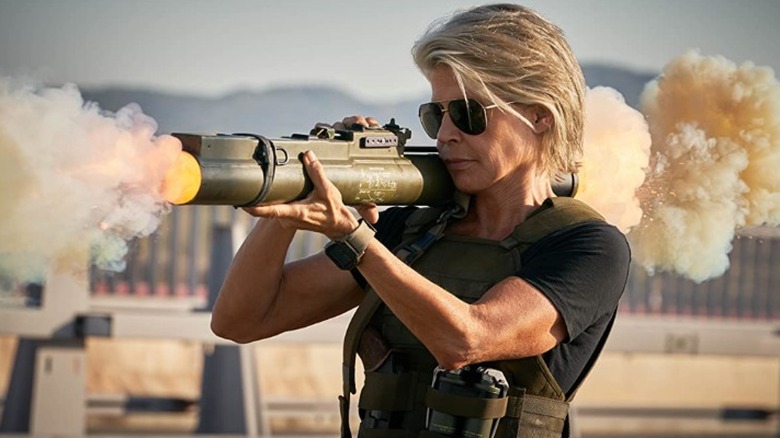
One of Hollywood's most dramatic body transformations is that of Linda Hamilton for "The Terminator" franchise. In the original action classic, Hamilton plays a soft and sweet waitress protected by a time-traveling warrior from a murderous robotic assassin. Hamilton returned for the 1991 sequel with a jaw-dropping version of the character, reintroduced to audiences while attempting to escape from a maximum security prison. Returning to the franchise after 28 years, Hamilton wanted to recapture this muscular physique for her role in "Terminator: Dark Fate," but at 61, this transformation would be no easy feat.
After receiving a clean bill of health, Hamilton embarked on a year-long training program with Mackie Shilstone. Having eliminated carbs from her diet, she began exercising around two hours a day for six days a week to get as close to her "Terminator 2: Judgment Day" body as possible. In a home gym built specifically for this program, she worked on a variety of exercises, including one requiring her to slam a medicine ball into a wall and then catch it on the rebound. This difficult-to-master move led to a smashed wall Hamilton refuses to repair. She claims it remains a symbol of her hard work and commitment.
J.K. Simmons — Justice League
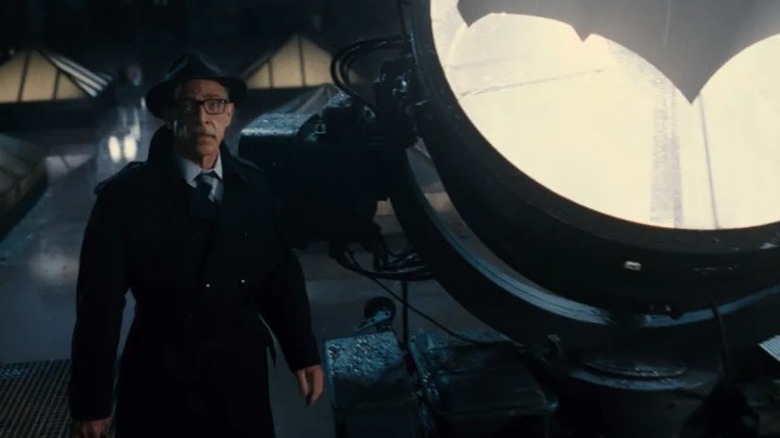
In 2016, 61-year-old J.K. Simmons set the internet on fire by posting gym pictures of himself lifting weights with impossibly ripped and veiny biceps and a bushy gray beard. Initial reports claimed this transformation was sparked by his casting as Commissioner Gordon in the 2021 film "Justice League." However, the Oscar-winning actor insisted that after years of dramatically fluctuating weight and health, he simply decided to live the rest of his life in what he calls "decent shape." It just so happens that director Zack Snyder is a "fitness maniac," and they found common ground in their various routines while filming.
Simmons worked out two to three times a week with his personal trainer Aaron Williamson using a technique called Cumulative Blood Volume Training designed to pump as much blood to targeted muscles as possible. Dual workouts include cardio and strength training, consisting of exercises like hammer curls, pushups, a variety of crunches, and ironically, a move called the Superman in which he lifts his body off the floor in an imitation of the caped hero flying toward danger. Simmons also revamped his diet to include mostly lean protein, fruits, and vegetables.
Read this next: 30 Box Office Bombs That Are Truly Worth A Watch
The post Actors who totally rebuilt their bodies for a single role appeared first on /Film.
Will Ferrell Enters Stranger Things, Squid Game, And Bridgerton In GM's Netflix Super Bowl Commercial
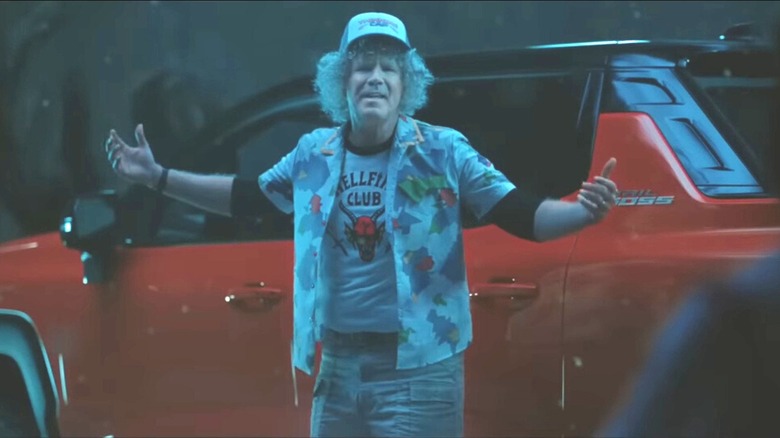
Netflix is making moves to have more environmentally friendly sets, and they're announcing their first steps towards that in a big way. During the 2023 Super Bowl, the streamer revealed it has partnered with General Motors to showcase their lineup of electric cars in future productions. They also recruited Will Ferrell to break the news, having him drive through various Netflix productions as he talks about this latest partnership.
You might be wondering how exactly that'll work with every Netflix property, and thankfully, Ferrell's got the answer for you. As he demonstrates in increasingly bizarre fashion, programs that take place in the current day or the future, such as "Army of the Dead" or "Squid Game," will feature electric GM cars. However, don't expect period pieces like "Bridgerton" or "Stranger Things" to suddenly get a modern upgrade. This partnership will also extend to the streamer's unscripted slate, which includes the addictive "Love is Blind."
Priah Ferguson steals the show in a brief cameo as her "Stranger Things" character, Erica Sinclair, especially opposite the Dustin-impersonating Ferrell. Even outside of the commercial, the actual act is commendable. Electric cars are healthier alternatives to gas-powered cars, so if a partnership like this is what they have to do to normalize these vehicles, then more power to them. It's a small thing in the grand scheme of things, sure, but small steps like these can eventually lead to greater change. Check out the entire advertisement below.
Right Commercial, But Wrong Time?
As you can see above, the commercial is actually pretty amusing, especially as it starts getting more ridiculous. The thing, however, is that it's a bit of a weird time to promote how forward-thinking you are if you're Netflix. As we've covered over the past few months, the streamer has been cracking down on password sharing among its millions of customers, recently introducing a pretty harsh penalty for doing so in a few test markets.
The streamer has also been under fire for the alleged glorification of Jeffrey Dahmer in its series "Dahmer — Monster: The Jeffrey Dahmer Story," widespread allegations of harsh conditions on the set of "Squid Game: The Challenge," and other unsavory controversies. We can't deny that they are doing some good in their business practices, as seen in this GM Super Bowl ad, but we also can't ignore the ones that aren't as good in the public spotlight.
Like many things in life, Netflix is a complex and multi-faceted company with both good and bad aspects. At least this latest ad was pretty fun!
Read this next: The Best Movies Streaming Right Now: Malignant, A Hero, And More
The post Will Ferrell Enters Stranger Things, Squid Game, and Bridgerton in GM's Netflix Super Bowl Commercial appeared first on /Film.
Michael Ironside Has A Sneaky Way Of Testing The Directors He Works With
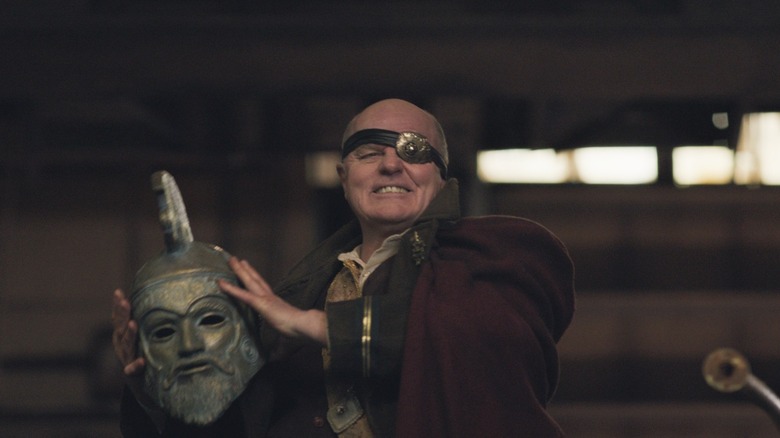
Not to be all, "being a successful actor is hard!," but it certainly can be tricky. Assuming you're well-off enough to have your pick of projects to work on, there are other factors to consider: whether the material itself is any good, whether you can do something with it, and most importantly, who your co-workers will be and whose vision is behind it. After all, this is several weeks (if not months) of your life and craft that we're talking about, here.
Fortunately, seasoned actors have their own sly ways of testing the waters, especially with young, inexperienced, and untested filmmakers whose reputations don't yet precede them. Canadian thespian Michael Ironside, who's been working at a steady clip since the mid-1970s, is as seasoned as they come, having appeared in well over 100 projects ranging from the small to the big screen. It's no surprise, then, that Ironside has his approach to testing out new directors down to a science, one that's as effective as it is sneaky.
Understanding The Function Of A Director
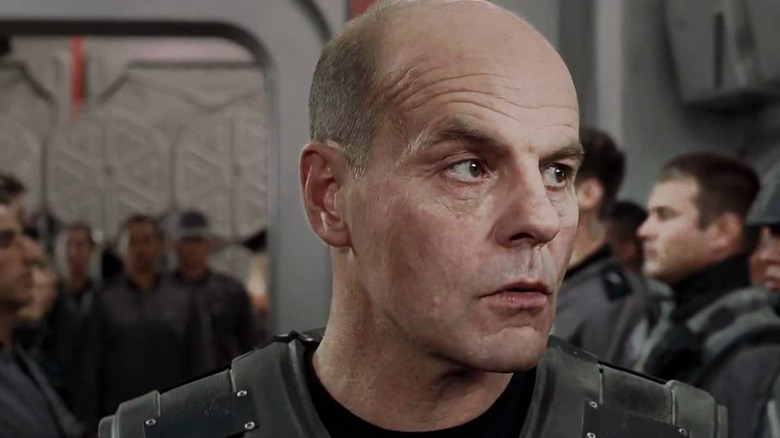
Thanks to his vast amount of experience, Michael Ironside has picked up a sixth sense regarding directors, their abilities, and their function while making a film. During an interview in 2015 on the eve of the release of "Turbo Kid," Ironside explained how he calibrates his working approach to a director:
"I don't make my work dependent upon someone else. Even the director. You usually know right off the bat when you're on something whether somebody's falling down. Then my job's to go to the script to support the story. First thing's always the script. The script's always got to be there. Then, the interpretation goes to the director."
Ironside's practical philosophy on the director's role, in fact, allegedly caused him to be hired on the sly to mind certain directors on a few of his films, claiming that he "had producers and stuff in the States paying me an extra $50k to keep an eye on the director. To go up to them and say, 'Look, how many shots have you got today?'" Obviously, the producers and Ironside shared the same ethos of suffering no fools.
Surprising The 'Turbo Kid' Directors With A Sneaky Test
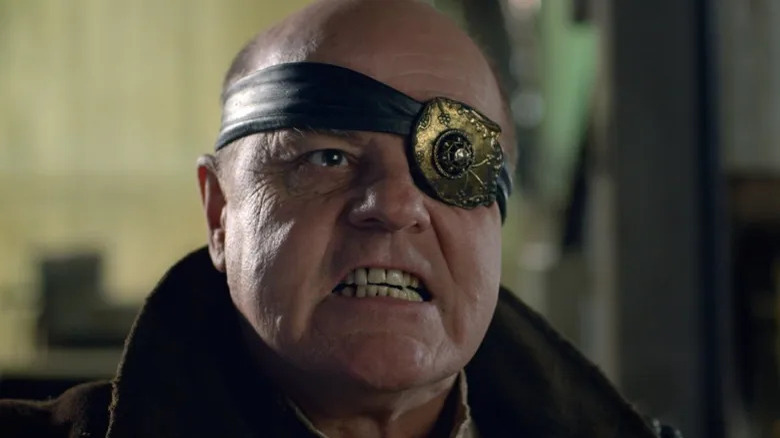
When Ironside was approached by Canadian filmmaking trio RKSS (François Simard, Anouk Whissell, and Yoann-Karl Whissell) about "Turbo Kid," the actor found their enthusiasm for the project "infectious and so over the top" that he offered to see a script. Upon reading and enjoying it, Ironside met with the trio over Skype to discuss the film, the directors and actor essentially interviewing each other. As Ironside recalled:
"I'll ask obvious questions of directors, especially young directors, that are contrary to the good of the film, and I'll ask them, what about changing this? They were right on top of it and said no, we need this and this and this. And they were very comfortable saying no, which is not always true."
Ironside remembered one testing point in particular regarding his character, Zeus, and his first major scene in the movie. He continued:
"I think it was the entrance of Zeus, that whole thing where he comes on with the trike where he's pedaling and the stuff is over there. I asked [is] there any way we could have that motorized so that he's getting, and I knew it was wrong. I said, 'because I know you're doing a whole Road Warrior thing, but is there any way we can get him elevated so that gives him a bigger entrance and [one that's] more powerful?' They said, 'No, no, we want to stay within the genre and within the limitations of our world,' and I went, 'right answer." I started laughing and they said what are you laughing at, and I said, 'I'll tell you one day.' And so I got to tell them."
Establishing A Healthy Working Relationship
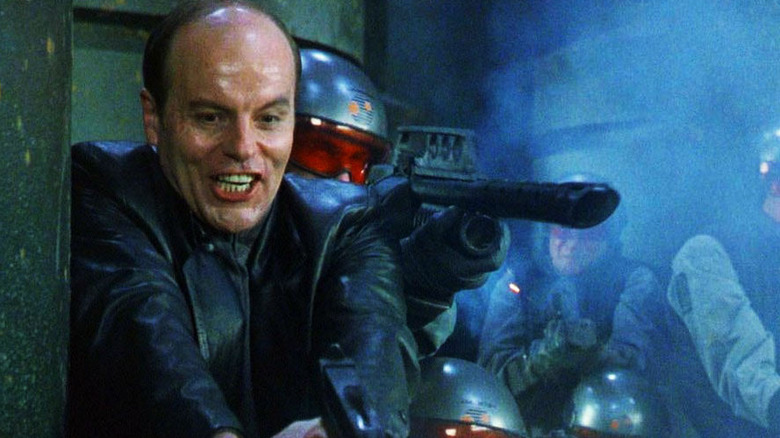
Of course, Ironside isn't just being a playful scamp with such sneaky tactics. His "tests" were a sly, quick way to establish trust in his directors, as well as opening up the lines of communication regarding the creative process. After creating this rapport with RKSS, Ironside then spoke to them about some changes he really did want to make, "and they considered it and they said yes to about 60% of them," he explained.
Ironside wasn't looking to disrupt things with his tactics, but was instead all about creating an environment where boundaries are established early on, then going from there. As he elaborated, "I kind of pride myself on trying to fit into a production. [...] You've got to trust, once you're on board, you're on board. Once the ship sails, you're on board."
As anyone who's seen his performance in "Turbo Kid," "Top Gun," "Scanners," "Total Recall" or any of the dozens of films he's appeared in knows, Ironside is one helluva actor to have on board.
Read this next: The 14 Best Film Acting Debuts Of All Time
The post Michael Ironside Has A Sneaky Way of Testing The Directors He Works With appeared first on /Film.
Moments In Hit TV Shows That Actors Refused To Film
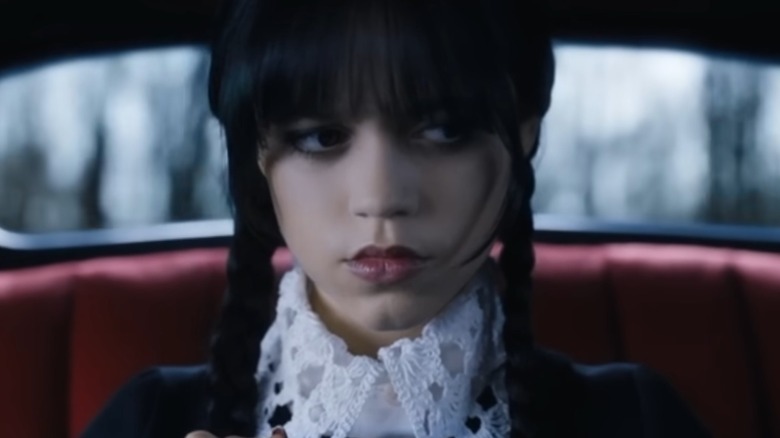
Have you ever refused something you just didn't want to do? Maybe it was a trivial task, or perhaps, it was an important life moment, but something about the situation didn't sit right with you. It compromised your values. It didn't make sense to you. Or you just didn't want to do it, plain and simple, no reasoning required.
The same is true for actors. I know this comes as a shock. They're just like you and me! Gasp! When a television series runs long enough, the actors know their characters well. They have a strong understanding of what their characters would (and wouldn't) do and sometimes have to call the writers out on dialogue or contradictory story points. At other times, an actor morally disagrees with what's on the page to the point of refusing to participate. Even if the writers think the character would do or say a certain thing, the actor respectfully wants no part in it.
Writers of your favorite TV shows penned scenes or stories that never aired because actors refused to film them. Here are a handful of those moments, ranging from the groovy '70s of "The Brady Bunch" to Wednesday Addams herself.
John Krasinski Didn't Let Jim Cheat On Pam In The Office
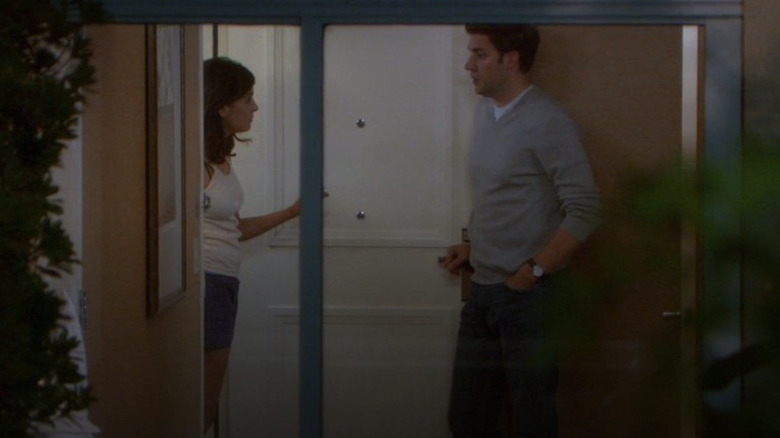
What's the most cringe-worthy moment from "The Office"? Every fan has their pick of which episode makes them squirm the most, from "Dinner Party" to "Scott's Tots." For me, it's Season 8's "After Hours," in which a woman comes on to Jim during a business trip to Florida. Jim declines the woman's advances and nothing explicitly scandalous happens — but only because actor John Krasinki shut down a more aggressive early pitch.
In the first draft of the episode, Jim cheats on Pam with the woman in Florida. The circumstances around the specific storyline may or may not have been the same scenario at the hotel from the finished episode. However, the result would have been way out of line for our good friend Jim Halpert.
Krasinski elaborates in "Welcome to Dunder-Mifflin: The Ultimate Oral History of The Office" (via New York Post). "That's the only time I remember putting my foot down," Krasinski tells authors Brian Baumgartner and Ben Silverman. "My feeling is there is a threshold with which you can push our audience. They are so dedicated. We have shown such great respect to them. But there's a moment where if you push them too far, they'll never come back. And I think that if you show Jim cheating, they'll never come back." When Krasinski read the storyline, he voiced his concerns to Greg Daniels, who developed the series and produced Season 8. Daniels obliged, and Jim remains loyal to Pam. Can you imagine?
Grace And Franke's Jane Fonda Asked To Not Use Jesus' Name As An Expletive
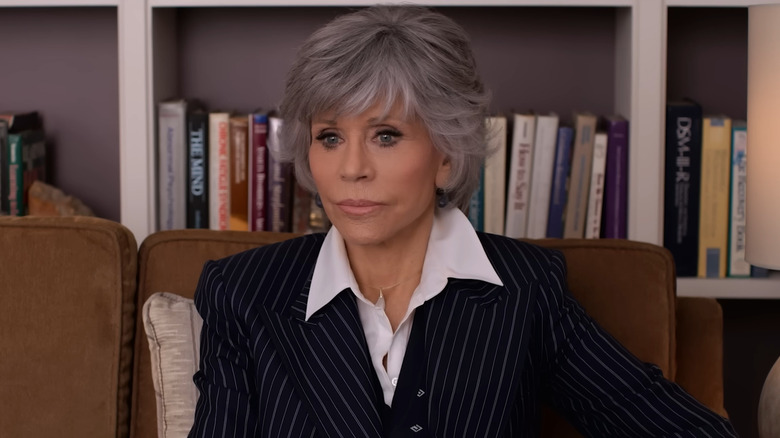
Sometimes an actor's conflict with script material is less a narrative issue and more of a virtuous one. Such was the case when actor Jane Fonda asked that her "Grace and Frankie" character, Grace Henson, not utter the phrase "Jesus Christ" as an exclamation. Writers respected Fonda's request and removed the line from the script.
Marta Kauffman, co-creator of "Grace and Frankie," discussed the moment during a 2018 panel in New York. Kauffman called her cast "the most professional, glorious people I've ever worked with," adding, "I love them. So when they have an issue, it's not that they're being divas. It's not that they're being self-important. They have a real issue." She cited Fonda's request as an example of "little things" that occasionally come up that the actors are uncomfortable with and emphasized her openness to talking through changes in such cases and her approval of revisions.
Too Cold For Cole Sprouse On The Set Of Riverdale
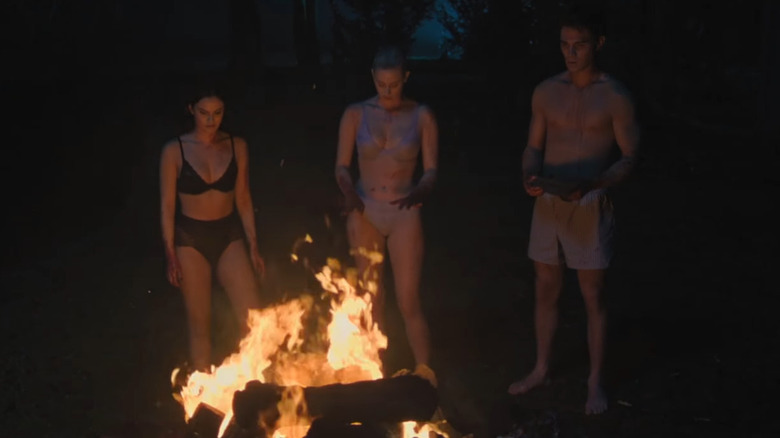
The Season 3 finale of "Riverdale" ends on a cryptic note. Somewhat ambiguously, Archie, Veronica, and Betty gather around a fire in the woods and throw some of their belongings — and Jughead's signature beanie — into the fire. (It's hardly the weirdest thing that's happened on the show.) The episode confused some fans who wondered if the moment implied Jughead's death. The reality was much less dramatic: Cole Sprouse, who portrays Jughead, was cold.
The cast spoke to TVLine (via BuzzFeed) about filming that scene during Comic-Con 2019. The interviewer asked about Jughead's ominous absence, to which AJ Kappa, who plays Archie, bluntly replied, "The only reason why that happened is because Cole was cold that night." Camila Mendes, who plays Veronica, concurred, "He almost shot that scene." Lili Reinhart, who portrays Betty, elaborated, "No, but it literally is. It was scripted all four of us, and he was like, 'I don't wanna do it,' so he didn't. We're not kidding, though." The cast laughed through these statements but also seemed to hold back some angst on the subject. No matter if their feelings are difficult to read, Cole Sprouse, sitting right there with them during the interview, merely added nonchalantly, "I'm cold."
Famous Love's Bella Thorne Thought Paige Took It Too Far
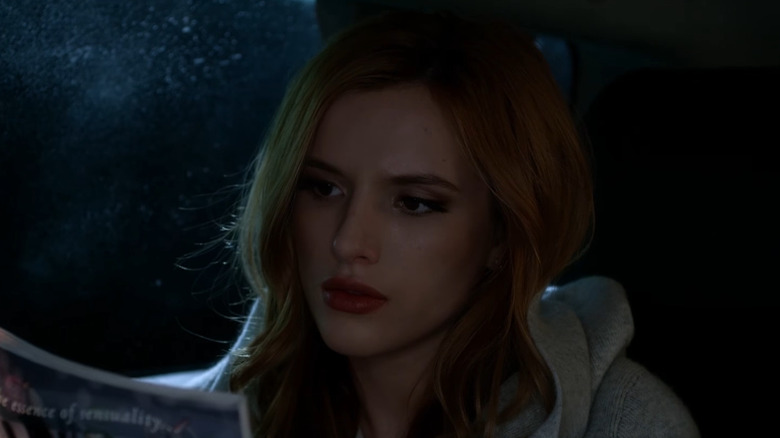
On the Freeform series "Famous In Love," Bella Thorne plays movie star Paige Townsen. In an early draft of one episode, Paige is judgmental toward Cassie (Georgie Flores) upon discovering Cassie is a topless maid. Thorne asked if she could scale back the dialogue.
Thorne spoke to Complex about her pushback in 2017, saying Paige "was just really judgmental ... Originally I felt so bad for the Cassie character, because I was like, my character is being such a c*** right now. That's literally what I said. I was like, 'I don't want to do the scene, I don't want to say these lines. This doesn't sound feminist at all." In this case, Thorne's refusal to perform the original version of the script and her request for a revision was both a question of narrative integrity and moral responsibility. The final version is less intense.
Ian Wright's Ted Lasso Commentary Hit Too Close To Home
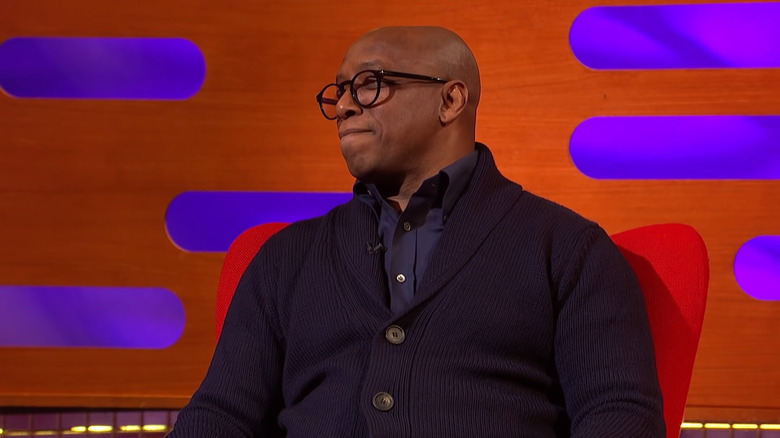
Real-life sports commentator Ian Wright will appear in the upcoming third season of "Ted Lasso." The flagship Apple TV+ series focuses on the fictional Richmond football team but often includes or references real teams. While filming, Wright refused to say a line that complimented the Tottenham team.
Phil Dunster, who plays Jamie Tartt, chatted about the scene on the podcast "Dish" (via Metro). Tartt recalled, "It was in the script that [Ian Wright] says, 'You know, it's gonna be a tough game for Richmond because Tottenham are a great side' and he was like, 'I can't say it. I'm just not going to say it. I'm sorry.'"
In the real world, Tottenham holds a bitter rivalry with Arsenal, Wright's former team. Wright knew what his character would and wouldn't say because the character was himself! Even when pretending to commentate on a semi-fictional version of the league, he had to remain loyal to his team.
That's So Raven's Raven-Symoné Declined To Change Raven Baxter's Sexuality
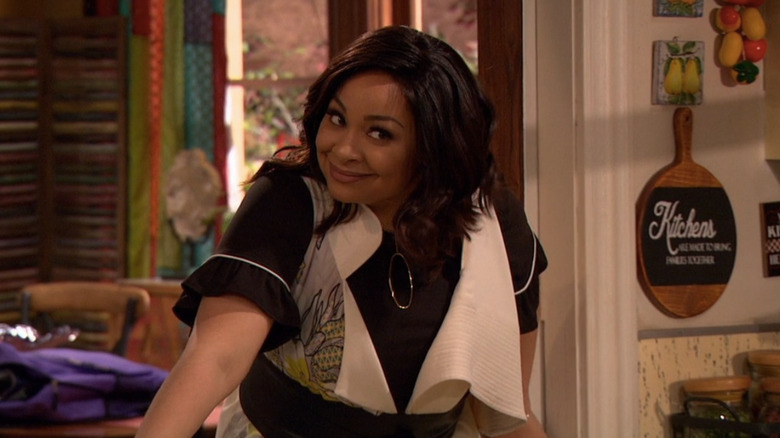
Throughout the Disney Channel sitcom, Raven-Symoné's character, Raven Baxter, is heterosexual. In the years since the series wrapped, its star came out as gay. When Disney developed the sequel series "Raven's Home" nearly a decade later, Raven-Symoné felt the network wanted her character to share the actor's sexual orientation, she told Them on YouTube in 2022.
"I think Disney wanted her to be queer in the beginning [of "Raven's Home"], and I just didn't feel comfortable doing that," she said. "They were like, 'Do you want Raven to be gay?' I said, 'Why?' 'Because you are.' I said, 'Bad reason. That's a bad reason. No.' Raven Baxter never exhibited any type of sexual identity situation in the priors. I'm not being myself on this show. I'm being a character." Laughing, Raven-Symoné acknowledges that even though some viewers may want to read between the lines at how the sequel series shows Raven Baxter and best friend Chelsea (Anneliese van der Pol) raising their kids under the same roof, Raven Baxter is not gay.
Kathy Bates Drew The Line At Praying To Satan On American Horror Story
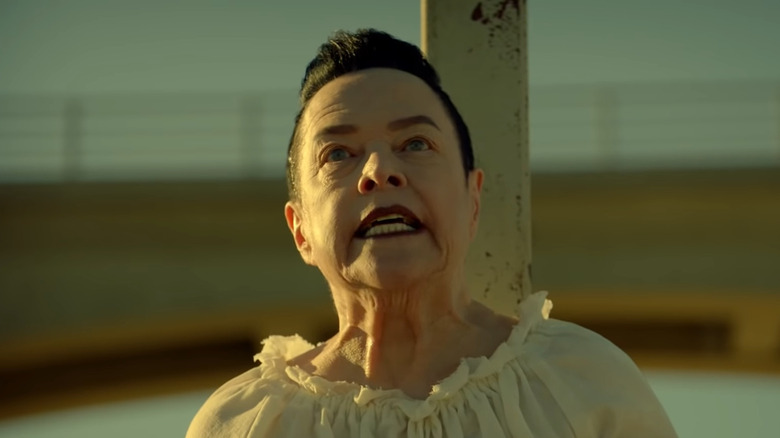
Kathy Bates has starred in five of the 11 seasons thus far of "American Horror Story," Ryan Murphy and Brad Falchuk's horror anthology series. During Season 8, titled "Apocalypse," Bates was surprised to find herself cast as a Satanist. She still played the role but drew the line at reciting any dialogue in which her character explicitly prays to Satan.
Bates told Entertainment Weekly in 2018, "I was quite serious about it because I'm a two-time cancer survivor and I'm not gonna screw around with that!" Laughing, she continued, "It's bad enough I have to say 'hail Satan' a couple of times. I know it's entertainment, but I just didn't want to do it." She explained that in most seasons, the creatives provide the actors with "a rough idea" of where the story will go and where their characters fit into things, but it's not until the actors receive the scripts that they have a full view of what their performance requires. Even in a show known for its affinity for the occult, praying to the devil was more than Bates signed up for.
Matthew Perry Didn't Think Chandler Should Go To A Strip Club On Friends
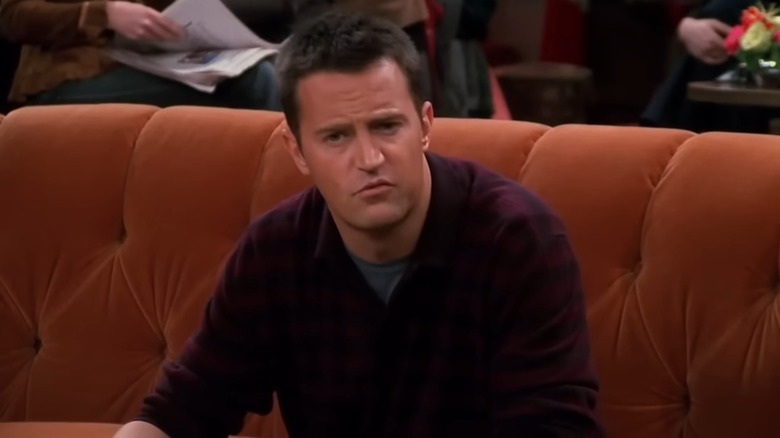
The characters in "Friends" get into some zany situations that stretch the limits of believability from time to time. Scriptwriters pushed their boundaries in one script that actor Matthew Perry refused to film. Perry rejected a pitch in which his character, Chandler Bing, frequently visits a male strip club because he likes their sandwiches.
The actor recalled the moment during his appearance on "Watch What Happens Live with Andy Cohen" in 2017 (via Brit + Co). Perry said with a smile, "I called up, and I said, 'Let's not do this one.'" Perry stopped short of explaining his thought process and whether he approached the decision as a stretch of believability or his discomfort with the subject matter — or perhaps both. In any case, believing that Chandler would be unfazed by going to a strip club solely because of the food may have been a lot to ask of the audience — and may have been a lot to ask of Perry as an actor.
Mr. Brady (Incorrectly) Fact-Checked A Brady Bunch Script
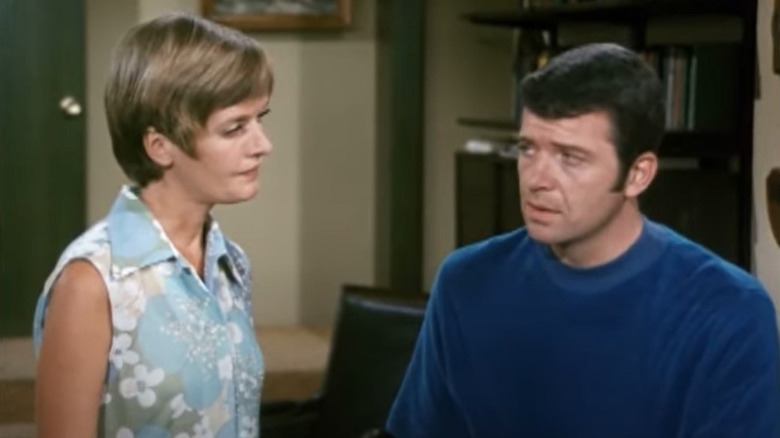
Robert Reed played patriarch Mike Brady on "The Brady Bunch" and its various spin-offs. Reed was reportedly not as friendly as his sitcom counterpart, often bringing an attitude with him to set. He insisted the writers change one line in a 1972 episode because he believed it was factually incorrect. Author Kimberly Potts chronicles the incident as a typical example of Reed's toxic behavior in "The Way We All Became the Brady Bunch" (via the New York Post).
During the episode in question, Mike arrives home as Alice (Ann B. Davis) makes strawberry preserves. The writers initially planned on Mike saying the kitchen smelled "like strawberry heaven." Reed was quick to note that according to the Encyclopedia Britannica, strawberries have no smell when being cooked. Reed refused to say the line, despite series creator Sherwood Schwartz showing Reed the strawberries being prepared for the scene, which he could smell. Reed wouldn't budge, and in the finished episode, Mike instead says the kitchen "looks like strawberry heaven." Sure, Jan.
Tony Sirico Stood Up For Paulie On The Sopranos
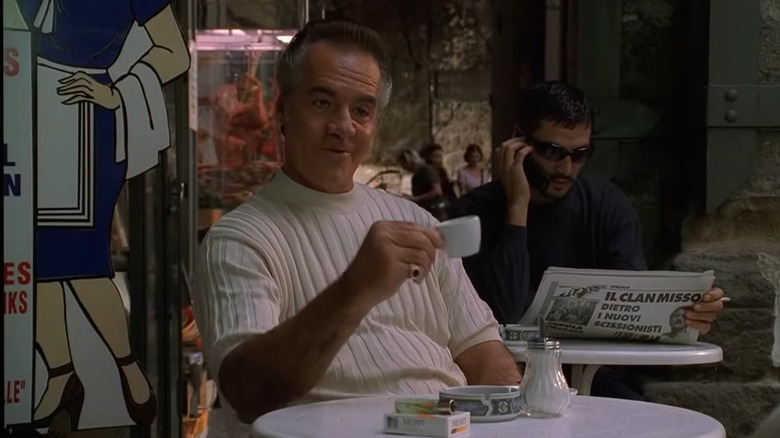
Tony Sirico portrayed Paul Gualtieri, aka Paulie Walnuts, across 74 episodes of "The Sopranos." Following Sirico's death in 2022, David Chase, who created "The Sopranos," shared some memories of the actor with Vulture. Paulie can be intimidating, but Sirico didn't want viewers to mistake the character for something he wasn't. Chase recalled one time when Sirico stepped in to correct some language around how someone described Paulie.
"Tony was part of one of the greatest casts of all time ... but he was the only one who ever asked me to have a line changed," Chase said. "Another character was talking about Paulie, and they said he was a bully. Tony didn't like that. He asked me to take the word 'bully' out of there. And I did." Though Chase didn't remember exactly how he revised the dialogue, he seemed to think Sirico's request perhaps had less to do with a disagreement about Paulie's characterization and more to do with Sirico's personal history with the word. Chase continued, "The important thing is, he didn't like that word. He didn't like it at all."
Patrick Warburton Called Out Family Guy
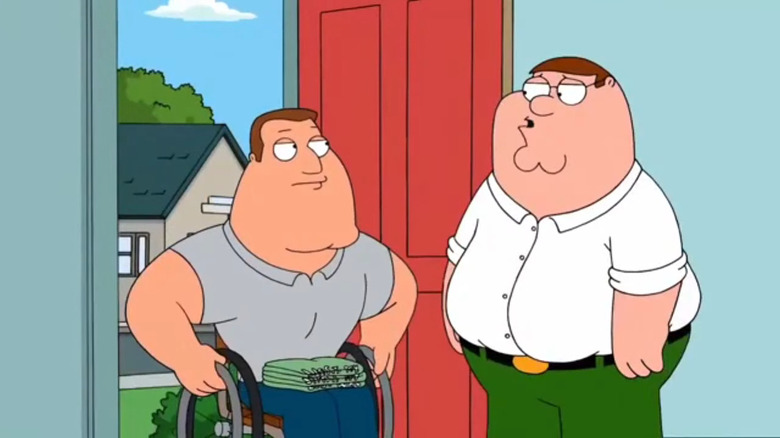
Patrick Warburton voices Joe Swanson on "Family Guy," a gig he's had since 1999, spanning over 20 seasons and nearly 300 episodes. While "Family Guy" certainly isn't family-friendly (that's kind of its whole deal), one time, Warburton felt the material went too far.
Warburton told Digital Spy in 2019 that a proposed joke about Jesus on the cross was "so, so horribly offensive" that it would offend "any Christian." Despite the specific line not being spoken by his character, Warburton didn't want to be part of the episode if it remained in the script. "I know what I signed up for," Warburton said. "I signed up for a really offensive show and it is satire and there are different rules that govern satire — there are, because of what they've gotten away with." The crew didn't expect standards and practices to approve the line, so they removed it.
While Warburton didn't elaborate on the specific line, he stressed it was the only time in two decades that he flat-out refused a "Family Guy" script. As the voice actor pointed out, considering some of the other material in the show — which he must have been ok with, to a degree, even if he was potentially uncomfortable — the line had to have been pretty bad.
Without Patricia Richardson, Tim Allen Called It Quits On Home Improvement
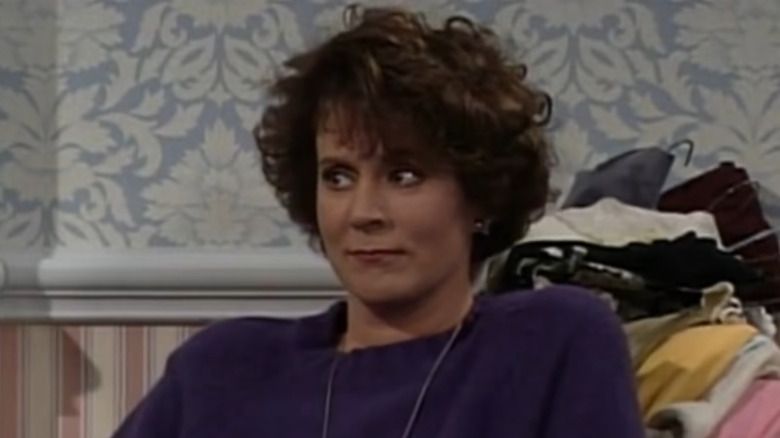
After eight seasons and over 200 episodes, Patricia Richardson was ready to depart "Home Improvement." She played Jill Taylor opposite Tim Allen on the hit '90s sitcom. Eight years is an impressive run, but ABC wanted more. The network considered keeping the series going without Richardson, as she told Entertainment Weekly in 2020.
Once Richardson informed ABC that she didn't plan to renew her contract for a ninth season, "They went to Tim, and they said let's do it with dead Jill," Richardson explained. "Then Tim was like, 'I don't think we can do that.'" There was a precedent for continuing "Home Improvement" without a main character but under different circumstances. When Jonathan Taylor Thomas left the series after Season 7, the show's writers invented the in-universe excuse that Thomas' character left the United States to study in Costa Rica. A character leaving to travel is one thing. A character dying is something else, especially for a show with a lighthearted tone. Not to mention Richardson was still very much alive. Jill's death might have felt off-putting and in poor taste, and Allen made the right call in not choosing to go forward with the series.
Jenna Ortega Knew What Wednesday Would — And Wouldn't — Say
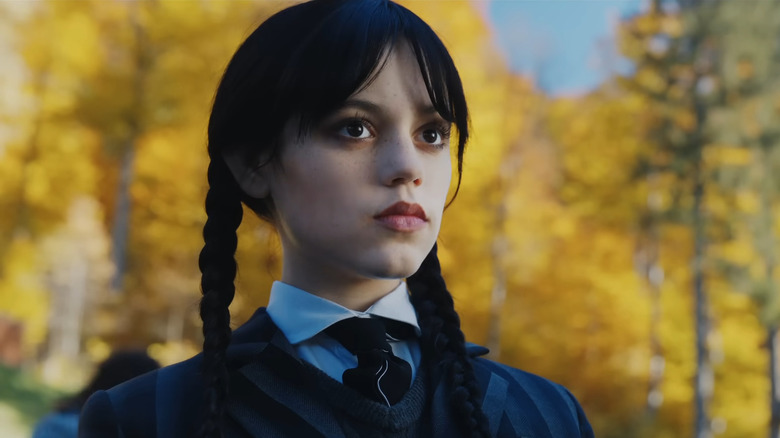
In adapting any well-known character for a new story or interpretation, creatives walk a delicate line. Which traits should they keep the same to retain the essence of why the character is beloved in the first place? Should they change any qualities of the character with a modern audience in mind? In these questions, another chorus of opinions enters the dialogue. Because of the established relationship that the audience has with the character, sometimes lasting generations, viewers know what the character would and wouldn't say as well as the writers and actors. This makes it all the more important to treat adaptation with care.
Such was the case when Netflix created "Wednesday," bringing Wednesday Addams from "The Addams Family" center stage in a series all her own. In stewarding the character's legacy, writers didn't always get things right on the first try. Jenna Ortega, who plays Wednesday, felt that Wednesday's self-conscious dialogue about her appearance in one scene was out of character. "I remember there's a line where I'm talking about a dress, and she was supposed to say, 'Oh, my God, I'm freaking out over a dress. I literally hate myself,'" Ortega shared in a Q&A (via dannyraeee on TikTok). "I was blown away because that sounded like I — it was just a bunch of little things like that."
Read this next: The Best And Worst TV Couples Of 2022
The post Moments In Hit TV Shows That Actors Refused To Film appeared first on /Film.
The 15 Best Gary Oldman Performances Ranked
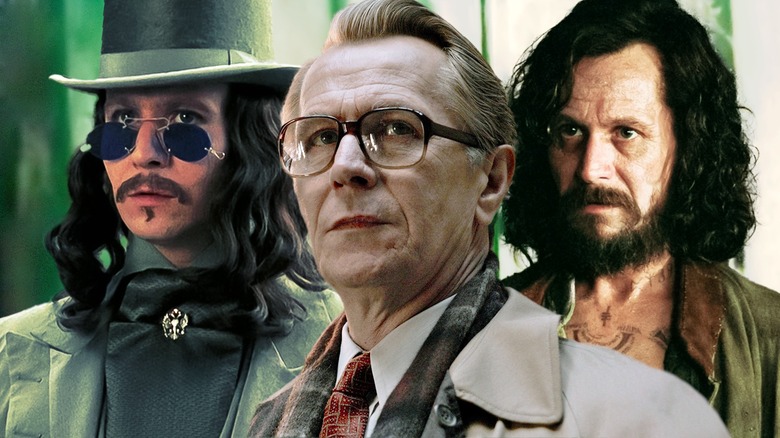
Gary Oldman is one of the greatest film actors of all time. His versatility is so established now that there are internet memes about his uncanny ability to just simply vanish into a role. No other actor could convincingly play real-life figures as diverse as Lee Harvey Oswald and Winston Churchill, let alone such contrasting literary characters as Dracula and George Smiley. It's this versatility that has led to his success and longevity as an actor; he can play the hero, the villain, a supporting role, or a mere cameo, and never gives a part anything less than his all, whether he's playing Beethoven or a CGI peacock.
It's true that he displayed a propensity for playing villains in outlandish science fiction romps like "The Fifth Element," popcorn actioners like "Air Force One," or serial killer thrillers like "Hannibal." However, more recently he has received long overdue recognition for his talents with some much more distinguished film roles, receiving three Oscar nominations and one win (for "Darkest Hour). Below are 15 of the best Gary Oldman performances from film and television that demonstrate his versatility in full effect. His is an enviable filmography, so apologies if your personal favorite didn't make the cut.
Sid Vicious - Sid And Nancy
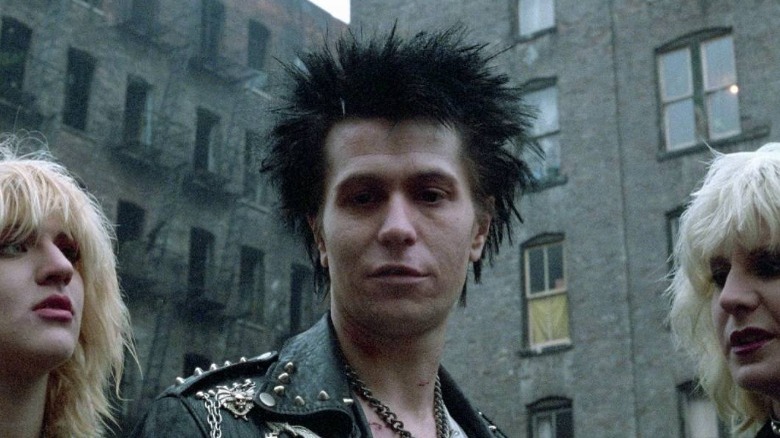
One of the most notable aspects of Gary Oldman's career has been his ability to shine in films that are otherwise not particularly remarkable. In both "Chattahoochee" and "Romeo Is Bleeding" he delivers powerful, virtuoso performances, even while the films themselves leave much to be desired.
"Sid and Nancy" is perhaps the best example of this, a haphazard, meandering film kept afloat by the two central performances from Chloe Webb and Oldman as the titular couple. Oldman in particular gives a towering performance, playing the Sex Pistols bassist with a pathos and a romanticism that wasn't always apparent in the real-life version. Losing a scary amount of weight for the role, he certainly looks the part too, even though Oldman himself was admittedly not a fan of the Sex Pistols or punk in general, he shared in an interview.
It proved to be the role that put Oldman on the map, though, and there are some sensational moments, including the scene where he walks through a glass door, and his anarchic rendition of "My Way." However, what sticks with you long after the film has ended is how Oldman and Webb capture the often-overlooked tragedy of the pair.
Rosencrantz - Rosencrantz & Guildenstern Are Dead
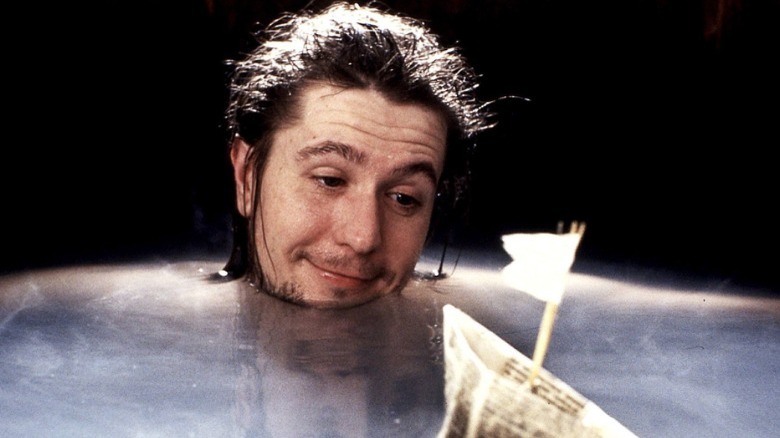
Tom Stoppard's adaptation of his first play reunites Gary Oldman and Tim Roth after working together on Mike Leigh's "Meantime." The actors star as two hapless minor characters from "Hamlet," wandering aimlessly through the Danish play, trying to make sense of their own roles, waxing lyrical on existentialism, chance, fate, and petty disagreements.
Oldman and Roth do an endearing double act, and it's a shame they haven't made more films together. They have a natural, dry comic chemistry, and it's nice to see them play roles so different from their previous on-screen pairing. In Stoppard's film, Roth is the level-headed one and Oldman is the mild-mannered idiot, albeit a bit of a savant (throughout the film he notices natural phenomena, such as Archimedes' water displacement and Newton's cradle, but fails to grasp the concepts thoroughly, invariably messing them up when trying to show Roth).
As with the play, the film's success depends entirely on the central performances, and both actors prove adept comic performers. They underplay the jokes beautifully, and despite the wonderfully absurd script, the laughs mainly come from the central dynamic, be it Roth's exasperation at his partner's stupidity or Oldman's blithe naivety and confusion over whether he is Rosencrantz or Guildenstern.
Ludwig Van Beethoven - Immortal Beloved
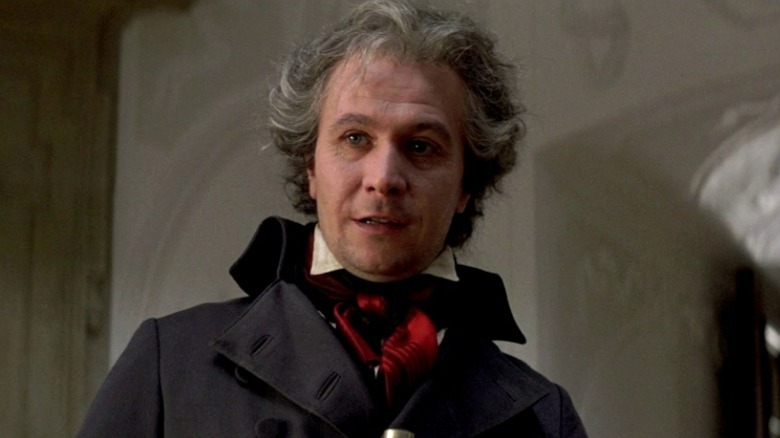
It takes 20 minutes for Gary Oldman to utter a single word in Bernard Rose's biopic of Beethoven, but he is captivating from his very first appearance. Told almost entirely in flashback after his death, it's a profoundly moving story that follows Beethoven's assistant (Jeroen Krabbé) as he hunts for the mysterious "Immortal Beloved" of the composer's letters.
It almost goes without saying that Oldman absolutely nails the broader aspects of Beethoven's character; the fits of pique, the bombastic Austrian pomposity. Even more impressive, though, is the way he captures the quieter moments. The climactic moment during the performance of "Ode to Joy" where he stands up and the sound completely drops from the soundtrack is breathtaking, and though we see the flashback illustrating his thoughts at that moment, the most affecting element is simply the expression on Oldman's face.
It's a film that suffers from comparisons with "Amadeus," and in truth, it can't compare with Milos Forman's movie in terms of production value or story, but it manages the difficult feat of combining Oldman's over-the-top acting tendencies with a nuance that was sadly overlooked at the time. You also can't fault Oldman's commitment to the role, sharing in an interview that he practiced the piano for six hours a day in preparation for the film.
Sirius Black - The Harry Potter Franchise
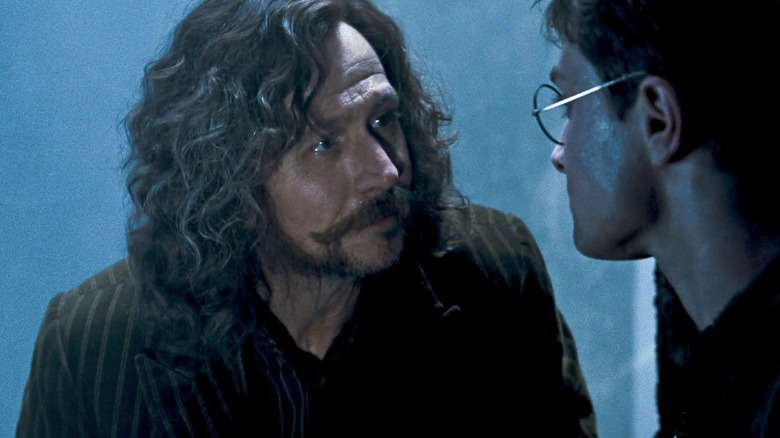
As canny as ever, Gary Oldman entered the "Harry Potter" films in the best installment ("The Prisoner of Azkaban") and left just before it went a little off the rails. Cast very much into type as the enigmatic Sirius Black, he is quickly revealed to be more complex than he first appears. With limited screen time, Oldman gives a remarkably lived-in, intense performance, instantly capturing the ambiguity of his character. In "The Order of the Phoenix," he builds up our empathy for Black while showing his growing frustration at being cooped up in his hideout.
More than anything, Oldman perfectly captures the impulsive Black's frantic restlessness. He so clearly wants to be taking a more active role in the war against Voldemort (Ralph Fiennes), and when he is let loose in the climactic battle with the Death Eaters, his exhilaration is palpable. He is finally in his element, fighting alongside Harry, making the film's ending all the more tragic.
While other characters are accused of infantilizing Harry (Daniel Radcliffe), Sirius' problem is that he treats Harry as a friend. He sees so much of Harry's father in him that in their final scene together he mistakenly calls Harry by his father's name. It's a subtle character beat but Oldman nails it.
Herman Mankiewicz - Mank
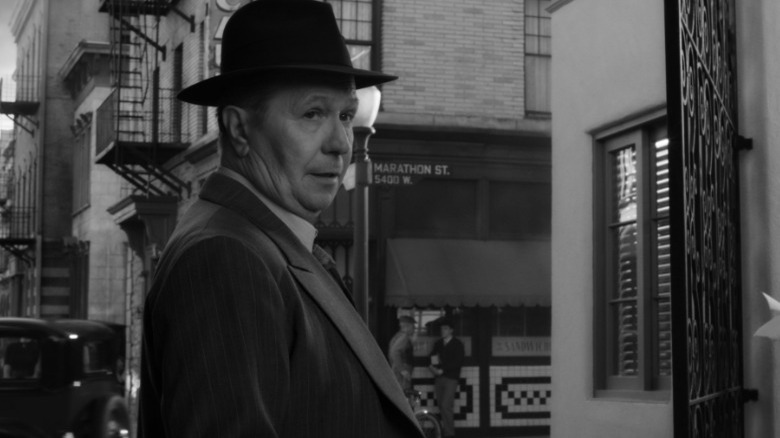
In a huge departure from the prosthetics required for his Oscar-winning turn as Winston Churchill, in "Mank," director David Fincher told Gary Oldman he wanted "no veil between [Oldman] and the audience," the actor shared with IndieWire. There is little attempt to make Oldman look like the real Herman Mankiewicz, and the result is one of his most natural, authentic, playful performances, and one that would result in his third Oscar nomination.
Playing one of Hollywood's most acerbic writing talents, Oldman has a whale of a time dishing out barbed insults to those in positions of authority, including William Randolph Hearst (Charles Dance). While others bristle at Mank's impertinence, Hearst praises Mank as "wonderfully contrary," and a curative to the crowd of toadies he surrounds himself with. Essentially serving as a court jester to the tycoon, the position rankles Mank pretty soon, and his increasingly belligerent comments set him against Hearst. This is all told in flashbacks as Mank works on a new screenplay, a thinly veiled assault on Hearst, named "Citizen Kane."
In an interview, Oldman described Mank as "an egomaniac with low self-esteem" while Orson Welles is said to have called him "the perfect monument to self-destruction," both of which are evident in his frankly incredible performance. Mank is a performer, clearly relishing being the single dissenting voice in a choir of yes-men, and speaking with no fear of recriminations. Still, there is a vulnerability to his character, too, and a clear warmth in the interactions with his long-suffering wife, cruelly nicknamed "poor Sara" (Tuppence Middleton).
Drexl Spivey - True Romance
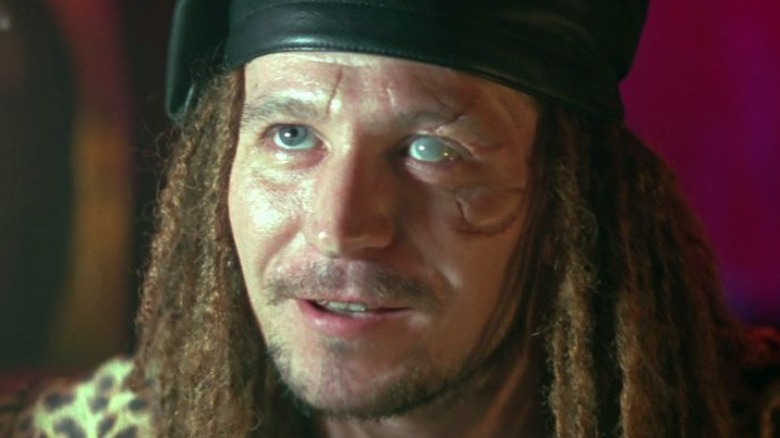
"True Romance" is a film absolutely crammed with colorful performances from acting heavyweights — including Christopher Walken, Dennis Hopper, and James Gandolfini — and yet Gary Oldman manages to stand out as the flamboyant pimp, Drexl Spivey, making an indelible impression with a little under 10 minutes of screen-time.
According to Flickering Myth, Tony Scott pitched the role to Oldman as "a pimp who's white but thinks he's black" and Oldman immediately agreed to the part. He created the character's look himself, insisting on the dreadlocks, the gold teeth, the facial scar, and the glazed-over pupil, resulting in one of the most distinctive villains in film history.
Both a comic character and a viable threat, Drexl is a monstrous creation. It's a testament to Oldman's versatility that he never comes across as a joke, and instead might be the most terrifying character he has ever played. He is endlessly compelling and full of little tics that make him effortlessly memorable. Even with all the plot twists and Quentin Tarantino's exquisite dialogue, it's Oldman who sticks in the memory long after the film has ended.
Jackie Flannery - State Of Grace
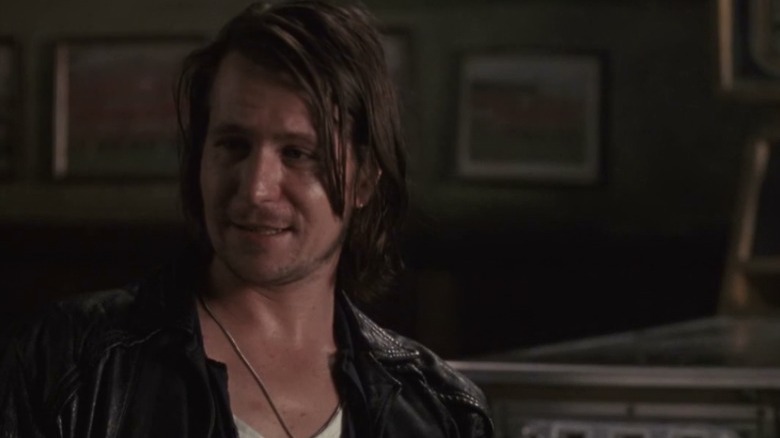
An emerging theme in Gary Oldman's career choices is his decision to play characters whose actions are abhorrent, but whose virtues make them if not likable, then at least relatable. In Phil Joanou's overlooked gangster film, Jackie Flannery is a psychotic, impulsive character, but his childlike loyalty and affection for his family make it impossible to condemn him out of hand, especially when compared to his ruthless brother Frankie (Ed Harris). His friendship with undercover cop Terry (Sean Penn) is his redeeming character trait, and their early scenes together are where the film really sparkles. The moment where he hysterically laughs while showing Terry a pair of severed hands he keeps in a freezer is the perfect distillation of his character. He's a psychopath but an endlessly watchable one.
When his friends begin getting killed off by the rival Italian gang, it's Jackie who feels it the most, breaking down and immediately seeking retribution. Oldman's visceral reactions make Jackie a much more complicated, multi-layered character than the endless cold-hearted psychopaths churned out by Hollywood. An interview with Oldman confirmed this "haunted quality" proved instrumental in him getting cast as Lee Harvey Oswald in "JFK," and many actors have singled out his performance in "State of Grace" as an inspiration, with Leonardo DiCaprio saying that it "influenced an entire generation of actors."
Jackson Lamb - Slow Horses
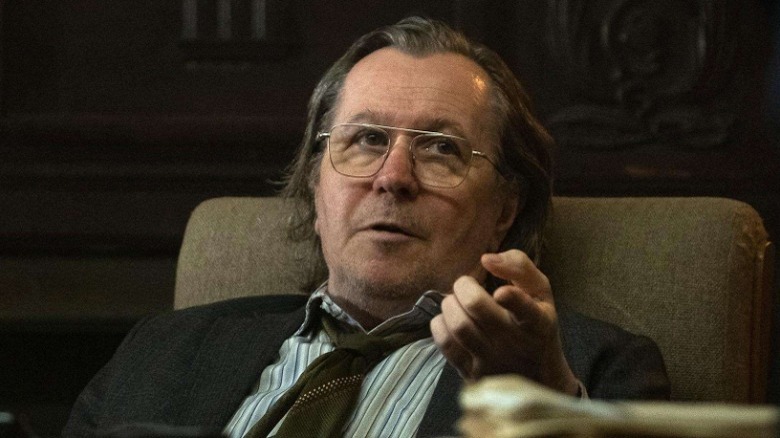
Based on Mick Herron's series of spy novels, this spy comedy drama sends up both "Spooks" and the more low-key espionage of "Tinker Tailor Soldier Spy." Playing off his performance as the refined, softly-spoken George Smiley and his newly acquired status as an Oscar-winning actor, Gary Oldman lights up every scene in which he appears, and clearly relishes the opportunity to sink his teeth into a real character.
Introduced sleeping on the sofa in his office, wearing socks with holes, and waking himself up by breaking wind, Jackson Lamb is not your typical spymaster. There is more to his character than first appears, though, and while he would never admit it, it's clear he has an affection for his team, screw-ups though they might be.
Jack Lowden's River Cartwright is the ostensible lead of the show, but every time the series looks like it's heading down a conventional route Oldman simply walks into the room and upends everything. Whether giving a withering look or dropping acerbic lines like "Getting you up to speed is like describing Norway to a dog," his crumpled spy is one of the funniest performances of his career. Oldman has stated that he'd be happy to retire once his role on "Slow Horses" comes to a close. Thankfully, there have been two more seasons commissioned, and with eight novels in the series, we won't be bidding him farewell any time soon!
Joe Orton - Prick Up Your Ears
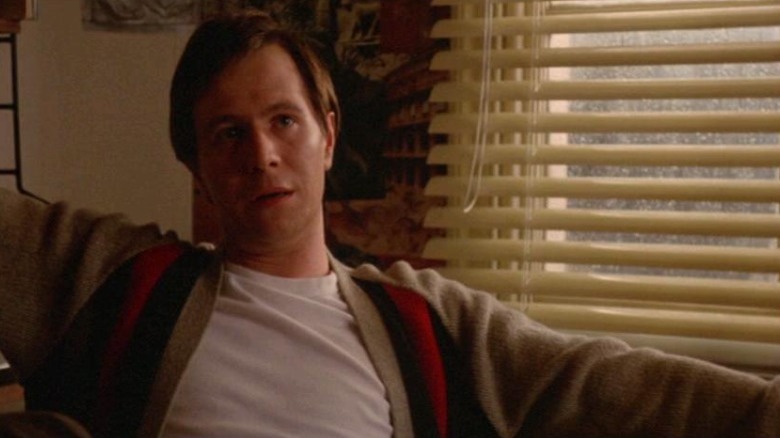
Gary Oldman has a number of real-life people in his repertoire, but none of them are as affecting as his portrayal of controversial playwright Joe Orton and his tragic death at the hands of his lover Kenneth Halliwell (Alfred Molina). Both actors give incredibly poignant performances, bringing to life a witty script by Alan Bennett that sheds some light on the inner dynamic of their relationship, providing some context for their deaths.
It's clear from early interactions that the young Orton was nurtured by Halliwell as a writer, and he quickly gains confidence thanks to his lover's support. But at the same time, Orton's rapid success clearly takes a toll on the overly sensitive Halliwell, which makes the tragic ending unfold with a dreadful inevitability.
Only three years after playing the blunt instrument that was Sid Vicious, Oldman plays Orton with a playful recklessness and a sharp, outrageous sense of humor, without ever making him a caricature. Most impressive is how he captures Orton's vulnerable side; his insecurities that lead him to stay with Halliwell despite their growing unsuitability, and the affection he feels for him that manifests itself as a callous disregard.
Shelly Runyon - The Contender
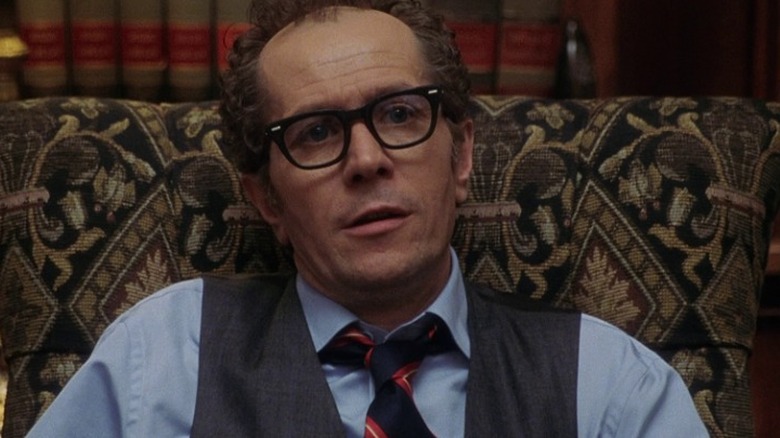
By rights "The Contender" should have been Gary Oldman's first Oscar nomination. He gives a nuanced, subtle performance as Sheldon Runyon, the Republican congressman intent on preventing the appointment of Laine Hanson (Joan Allen) as Vice President. With thinning, curly hair, and glasses that magnify his eyes (making him look like a turtle), Oldman is virtually unrecognizable.
Runyon is the ostensible villain of the film — his use of smear tactics and insidious use of rhetoric makes him a clear antagonist — but his actions come from a place of personal principle rather than outright villainy. In Oldman's own words to GQ, he viewed Runyon as the film's only "true patriot," using dishonest means maybe, but for what he truly believes is best for his country.
In any case, his performance ranks among his strongest work on film, and any behind-the-scenes conflict serves the character brilliantly. It's always more compelling to watch a villain who thinks he's a hero; instead of a black-and-white story of good vs. evil, it becomes a story of canny political maneuvering. The best scenes are those in the confirmation hearing, where Runyon pointedly leaves some questions unasked, ostensibly for the sake of propriety, but really allowing the watching reporters to fill in the blanks themselves.
Jim Gordon - The Dark Knight Trilogy
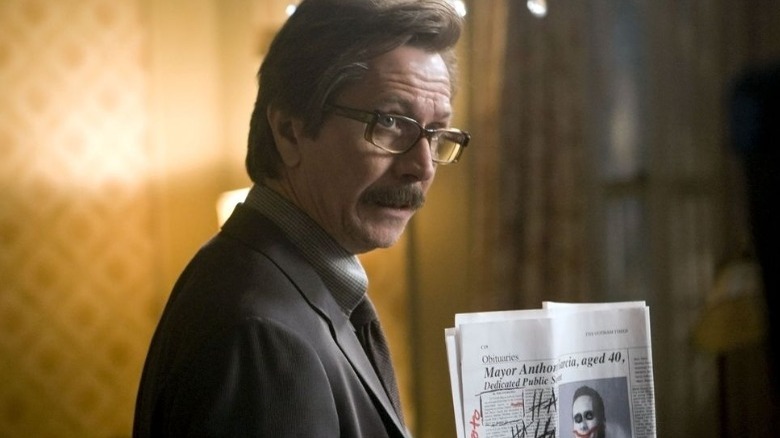
In previous film versions of "Batman," Commissioner Gordon is a fairly thankless role, a stern authoritarian character who is a grudging ally of Batman. Gary Oldman's version of the character is the first time he feels like a fully fleshed-out character, and a likable one at that.
In Peter Traver's review for Rolling Stone (one Oldman quotes regularly), he says that Oldman "makes virtue exciting." And it's true; Gordon is essentially the white hat of Nolan's trilogy, the dogged sheriff having to deal with criminals as well as a masked vigilante, and yet in Oldman's hands he never becomes dull, or a third wheel. He's incorruptible but fallible in his judgment and with his own blind spots.
Crucial to the performance is the basic decency that emanates from Oldman in the role. One tiny gesture of kindness marks him as one of the few decent, truly good men in Gotham, and worthy of Batman's trust. Most impressive of all, he makes the straitlaced Gordon a plausible pick for the favorite character in a series filled with colorful heroes and supervillains. It would be unthinkable if you just know the character from the Tim Burton/Joel Schumacher films or the animated series.
Count Dracula - Bram Stoker's Dracula
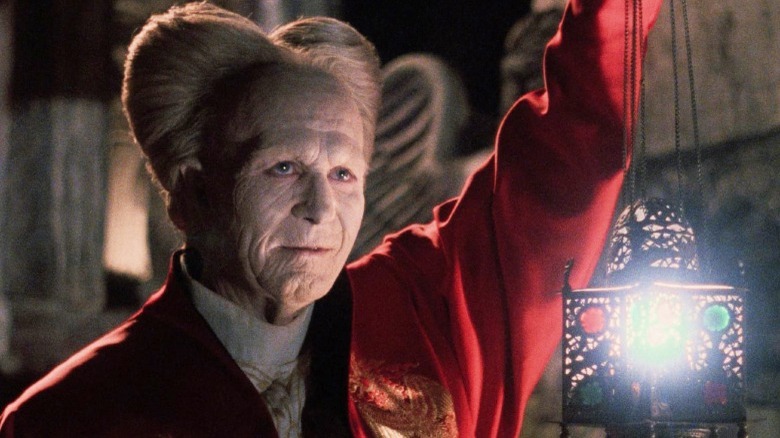
Described by Roger Ebert as "an exercise in feverish excess," Francis Ford Coppola's opulent adaptation of Dracula might have a claim to the greatest disparity between the best and worst performances in any film. On one extreme is Keanu Reeves' infamously wooden turn as the ostensible hero, and on the other Gary Oldman gives a remarkably nuanced portrayal of Count Dracula.
More than any other depiction, Oldman captures the unearthly qualities of Dracula. He is utterly other-worldly in his actions and movements (an element emphasized through Coppola's use of in-camera effects, such as making his shadow move independently). He is a ruthless monster, killing Lucy Westenra (Sadie Frost), and has no compunction about feeding babies to his Transylvanian brides. Oldman plays every iteration of his character with the same intensity, whether a decrepit old man, a dashing young count, a werewolf, or a gigantic bat.
Bearing more resemblance to Klaus Kinski's version of the character than the iconic Bela Lugosi portrayal, Oldman makes Dracula a tragic figure who is driven by a deep love, and yet he makes no concessions to make him more sympathetic or human. Like Kinski, Oldman depicts him as a feral creature, but one motivated by an overwhelming heartache that makes him an endlessly fascinating character.
George Smiley - Tinker Tailor Soldier Spy
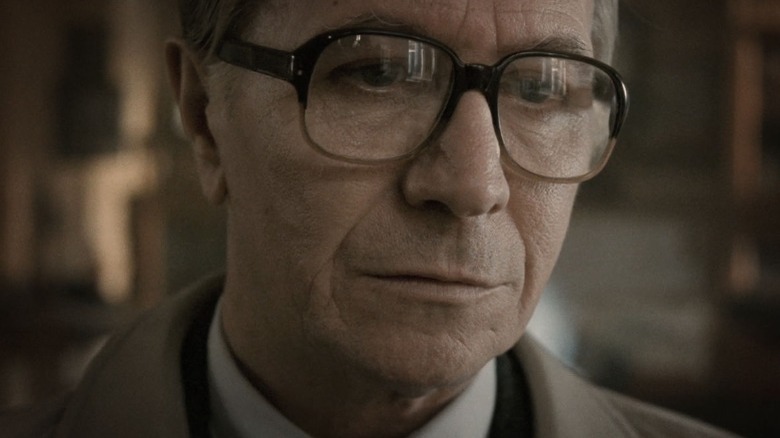
By his own admission, Gary Oldman has been guilty of overacting in the past. It's part of his charm, the shouting, booming voice is one of his trademarks along with his chameleon-like ability to disappear into his roles. As such, the part of George Smiley is a real departure for the actor.
Oldman plays John LeCarre's spymaster with a stillness that is quite unlike anything the actor had done before. In contrast to his more emotive performances, his Smiley is softly-spoken and slow-moving. He appears cold and detached but he also makes Smiley strangely vulnerable with a few beautiful touches. He raises his voice once in the entire film, and it's more in exasperation than anything else. When the mole is finally caught and arrogantly complains that he's not an office boy, Smiley roars back "What are you then?" It's the culmination of the betrayal and indignation the character feels and is so much more powerful when contrasted with his otherwise muted performance.
It remains a shame that Oldman didn't win the best actor Oscar for this uncharacteristically subdued performance, which remains one of the most beautifully observed of his career. It's quite telling that after this snub, he followed this up with a much broader, more award-friendly performance as Winston Churchill in "Darkest Hour." His turn as Smiley was a much more deserving performance, demonstrating a more subtle sensibility than he had ever played on film before.
Clive Bex Bissell - The Firm
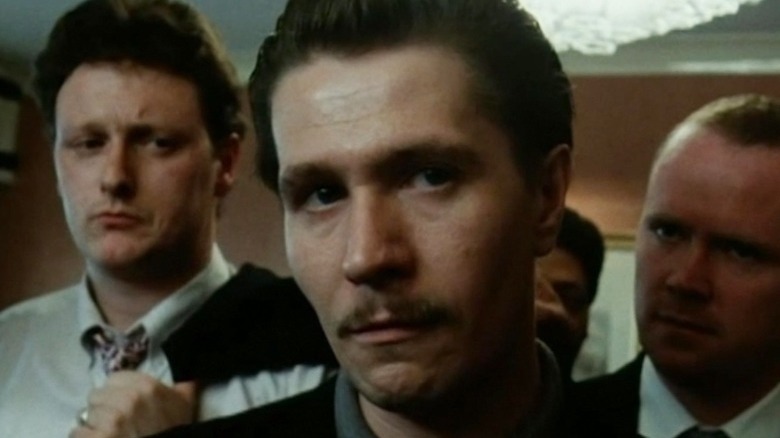
Described by the BFI as Gary Oldman's "Greatest Screen Performance," it's hard to disagree with this assessment. Alan Clarke's final film is also his best — an unflinching look at football hooliganism, that's really not about football at all. It's a film specific to the Thatcherite era and yet it's also about the universally relevant pervasiveness of violence.
Oldman's Bex is a very specific brand of monster, hiding behind the veneer of an estate agent's smile. It's an incredibly complex, fearless performance, full of self-loathing and a particularly toxic brand of masculinity. As he put it himself, Bex is "A British American Psycho – he had money and he was greedy but he was still angry."
Prior to appearing in "Tinker, Tailor, Soldier, Spy" Oldman would always say this was the film he was most proud to have appeared in. He never shies away from the darker side of his character; he's nervy and thin-skinned, bringing down violent retribution on anyone he believes has wronged him, and yet charismatic enough to galvanize his gang into action. At the same time though, at his core he's a twisted child, playing with his toys until he finds himself woefully out of his depth. The most illustrative scene shows him calmly walking upstairs to his room, decking himself out with his various weapons and impotently attacking his mattress until he's exhausted.
Norman Stansfield - Léon: The Professional
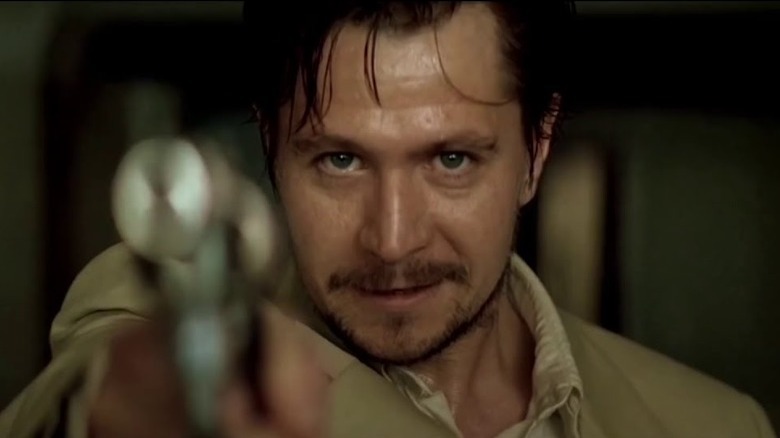
As a general acting rule, less is more. However, somewhere along the way Gary Oldman decided that actually, more is more, and in the case of "Léon: The Professional" he was proved absolutely right. Playing corrupt DEA agent Norman Stansfield, his character kicks off the film's plot when he murders the family of Mathilde (Natalie Portman) and inadvertently sends her into the arms of the childlike hitman, Léon (Jean Reno).
Introduced listening to Beethoven on his walkman, before literally sniffing out a lie from a duplicitous fence (Michael Badalucco), Stansfield is an unpredictable, volatile character, popping pills and gunning down innocent people without a care in the world.
Oldman has played a lot of villains over the course of his career, but Stansfield is the greatest of all and might be the best film performance of his career. He flits between broad comedy ("EVERYONE!") and sudden bursts of violence, while always projecting a palpable aura of menace. His performance might be larger-than-life, but it's the perfect counterbalance to Reno's subdued acting style. The moment when he finally confronts Mathilde with the line, "I take no pleasure in taking a life if it's from a person who doesn't care about it" is genuinely terrifying.
Read this next: The 14 Best Film Acting Debuts Of All Time
The post The 15 Best Gary Oldman Performances Ranked appeared first on /Film.
I thought a U.F.O. invasion of America would be much more dramatic [News]
The Dana Carvey Show Came Out Of Its Star's 'Horrible Movie Experiences'
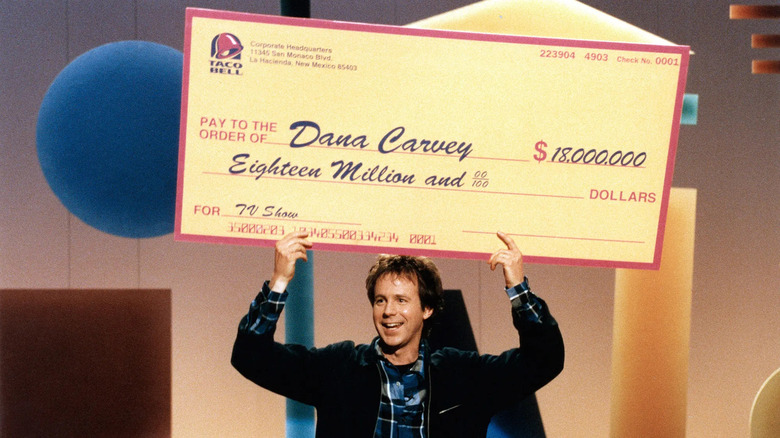
Can you imagine a world without "The Dana Carvey Show?" To be fair, you probably can, as the ABC series only lasted for a meager eight episodes during the spring of 1996. While the show itself has gained a cult status over the decades, the real legacy of the series isn't about the show's impact on pop culture, but rather its bringing together of talent that would soon go on to impact pop culture.
Consider this staggering list of names involved: Robert Smigel, Stephen Colbert, Steve Carell, Spike Feresten (writer for David Letterman and "Seinfeld"), Robert Carlock (future showrunner of "30 Rock"), Dino Stamatopoulos (future writer of "Community" and Starburns himself) and Charlie Kaufman were all among the people helping Carvey bring his surreal sketch comedy show to the small screen.
Yet the series may not have happened at all had Carvey not been smarting after a short-lived career as a leading man on the big screen. Despite the quality of his work in these films, his on set experiences and the films' poor critical and commercial reputation led Carvey back to sketch, paving the way for the future careers that followed.
The Dana Carvey Show Was Almost A Talk Show
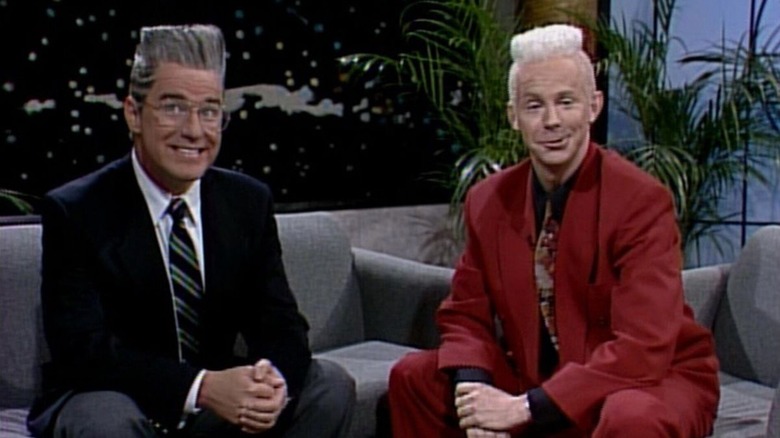
Before Carvey and his cohorts hit upon the idea of a boundary-pushing primetime sketch show, however, the star was briefly seduced by the opportunity to host his own talk show. The late night boom of the early '90s was heralded by the stepping down of longtime "The Tonight Show" host Johnny Carson, resulting in not only many comedians vying for a gig on that program, but joining forces with other networks as they sought to take talk show glory for themselves. That's how you get the disaster that was "The Chevy Chase Show," folks!
Carvey was a little more savvy than his fellow "Saturday Night Live" alum, though. Rather than pitching a new talk show, he found himself in the running to replace Carson's rival, David Letterman, back when that host was stepping away from NBC. As Robert Smigel recalled in an oral history of "The Dana Carvey Show" back in 2011:
"At one point Dana was talking about replacing Letterman. He had been offered that, and he wanted me and Conan [O'Brien, who eventually did take over for Letterman on NBC] to work for him on that show. He was red hot and had gotten a lot of offers after he left 'Saturday Night Live.' But he wasn't interested in the grind of a talk show, ultimately."
Carvey's 'Horrible Movie Experiences'
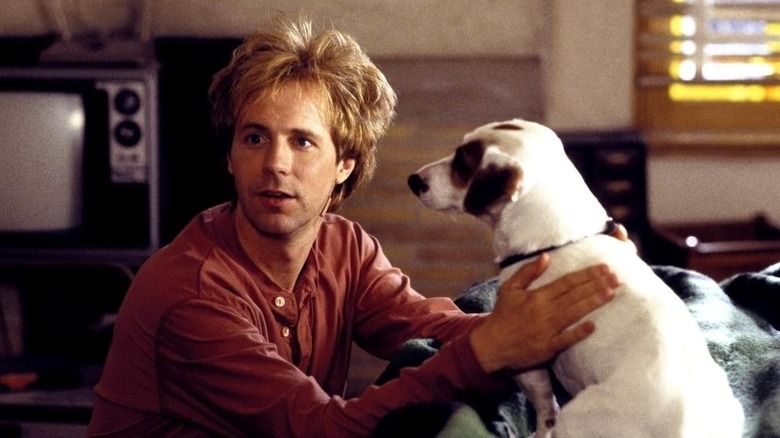
Upon clarifying that "The Letterman thing was a couple years earlier," Carvey described how the real impetus for the show came after his starring in several motion pictures:
"After being in these horrible movie experiences with directors who hated me, basically because they resented that the studio forced me on them, I said, 'Oh, man. I really would love to do something with Smigel who I enjoyed so much.' I said, 'Maybe we'll do a variety show somewhere.' That's kind of how it started."
While Carvey doesn't go on to mention which of his directors hated him, it's entirely possible that he's referring to people he worked with in 1994. He was featured in supporting roles in two movies that year made by George Gallo (writer of "Midnight Run") and Alan Parker (director of "Fame"). Both of those films — "Trapped in Paradise" and "The Road to Wellville," respectively — garnered heavily mixed reviews.
Yet it's Carvey's third film of '94, "Clean Slate," that may be the likeliest culprit. Directed by Mick Jackson as his follow-up to the smash hit "The Bodyguard," the original star of the film was to have been Robert Redford, who is a decidedly different style of actor than the broader, goofier Carvey. While this writer believes "Clean Slate" and Carvey's performance in it is highly underrated, there's no denying that it was poorly received upon release, sending the "Wayne's World" star back to television.
A Show Slightly Ahead Of Its Time
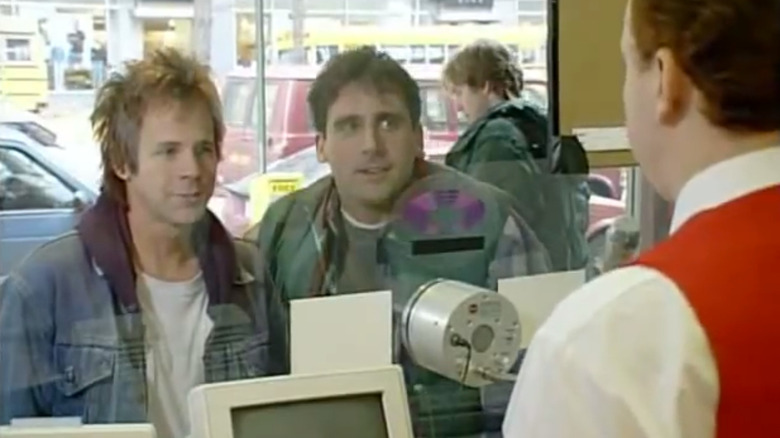
Unfortunately for Carvey, television wouldn't turn out to be much of a refuge. "The Dana Carvey Show" was canceled nearly as soon as it had begun, and its bevy of future talent scattered to other projects. Just as his movie career had been prematurely stalled, Carvey's return to TV was more a result of bad timing than anything else. As fan of the show Jon Hamm said, just a few years after the show's cancelation, there existed a subculture of comedy programming like, "Cartoon Network and Comedy Central and FX and a million better venues for it to be viewed and appreciated."
Still, Carvey's career wasn't over (even if his leading man career, well, was), as the comedian went on to continue to perform live as well as guest star in a number of TV episodes and feature films. In terms of making the actual show, Carvey had no regrets. As he explained:
"When you put Steve Carell, Smigel, Colbert, Louis C.K., and Charlie Kaufman together and doing what we wanted — it does make sense that it was just in the wrong spot. But I'm still really proud of it."
Read this next: The 10 Best Comedies Of The Last 10 Years
The post The Dana Carvey Show Came Out of Its Star's 'Horrible Movie Experiences' appeared first on /Film.
[News] INDIANA JONES AND THE DIAL OF DESTINY TV Spot Dropped!
![[News] INDIANA JONES AND THE DIAL OF DESTINY TV Spot Dropped!](https://i0.wp.com/www.nightmarishconjurings.com/wp-content/uploads/2022/12/IJ5_Teaser_Printed_1-Sht_v4_lg.jpg?resize=640%2C947&ssl=1)
Starring along with Ford are Phoebe Waller-Bridge (“Fleabag”), Antonio Banderas (Pain and Glory), John Rhys-Davies (Raiders of the Lost Ark), Shaunette Renee Wilson (Black Panther), Thomas Kretschmann (“Das Boot”), Toby Jones (Jurassic World: Fallen Kingdom), Boyd Holbrook (“The Sandman“), Oliver Richters (Black Widow), Ethann Isidore (“Mortel”) and Mads Mikkelsen (Fantastic Beasts: The Secrets of Dumbledore).
Directed by James Mangold, the film is produced by Kathleen Kennedy, Frank Marshall and Simon Emanuel, with Steven Spielberg and George Lucas serving as executive producers.
John Williams, who has scored each Indy adventure since the original Raiders of the Lost Ark in 1981, is once again composing the score.
INDIANA JONES AND THE DIAL OF DESTINY will open in theaters on June 30, 2023.
About Lucasfilm
Founded by visionary filmmaker George Lucas in 1971, Lucasfilm has established itself as a “rebel base” of sorts in San Francisco’s Bay Area, a place the filmmaker chose to “shake up the status quo…of how movies were made and what they were about.” It was a defiant departure from the Hollywood mainstream and a more conducive atmosphere to cultivate his independent spirit of filmmaking.
The post [News] INDIANA JONES AND THE DIAL OF DESTINY TV Spot Dropped! appeared first on Nightmarish Conjurings.
Employee Retention Strategies for Growing Companies
• Offer competitive salary and benefits packages to ensure employees feel valued and appreciated.
• Foster open communication between management and staff to create an environment where everyone feels heard and respected.
• Show recognition for hard work and dedication through public praise or private rewards to reinforce positive behavior and increase productivity.
• Provide career development opportunities to help employees advance their skillset while working towards their career goals within the company.
• Invest in employee wellness initiatives to reduce stress and encourage engagement.
Retaining your best employees is an essential part of any successful business. Not only is it important to maintain a steady workforce, but a happy and engaged workforce can also boost morale and productivity. Here are essential employee retention strategies that all growing companies should consider.
Offer competitive salary and benefits packages
It’s no secret that money matters when it comes to keeping your best employees around. A competitive salary and benefits package can go a long way in motivating employees to stay with your company for the long haul. A good salary and benefits package should include the following:
Competitive base salary
A salary that is competitive in the market should be a priority for any growing company. This will help ensure that your employees feel valued and appreciated, which can lead to increased employee satisfaction and productivity.
Health insurance
Many employees today are looking for a comprehensive health insurance plan that covers both medical and dental care. Offering such benefits can be beneficial to your employees and will make them feel more secure in their job.
401(k) plan
A 401(k) plan can be a great way to offer your employees retirement security. Employees will appreciate the ability to save for retirement and will feel more invested in their long-term careers with your company. Partner with a professional 401k provider. They can help you design the plan that works best for your company and its employees. They can also provide you with the necessary paperwork and guidance to ensure compliance with relevant rules and regulations.
Incentives and bonuses
Incentives and bonuses can be an effective way to motivate employees to stay with your company. Consider offering performance-based rewards in addition to salary and benefits packages, such as annual bonuses or additional vacation days.
By offering competitive salary and benefits packages, you can demonstrate your commitment to your employees. This can help create a positive environment and foster loyalty amongst your team members, which will ultimately benefit your company in the long run.
Foster open communication between management and staff

If you want your employees to feel valued, make sure they know their opinions matter. Open communication between management and staff helps foster trust, understanding, and respect while creating an environment where everyone feels heard. This will help create a positive work culture where employees feel comfortable enough to bring ideas forward without fear of judgment or criticism.
Show recognition for hard work and dedication
Everyone likes to be acknowledged for their hard work, so don’t forget to show appreciation for your team’s efforts! Whether it’s through public praise or private rewards, recognition goes a long way in showing appreciation for their efforts and reinforcing positive behavior that leads to increased productivity in the workplace.
Provide career development opportunities for growth
Offering career development opportunities allow employees to advance their skillset while working towards career goals within the company. This could include providing additional training or mentorship programs, encouraging cross-training among departments, or even offering tuition reimbursement so employees can attend classes related to their field of interest outside of work hours! Investing in your staff’s growth shows personal investment. It keeps them feeling challenged and motivated on the job day after day!
Invest in employee wellness initiatives

Taking care of yourself is just as important as taking care of business! Investing in employee well-being initiatives such as providing onsite health services like gym memberships or yoga classes can help relieve stress while increasing employee engagement at work! Additionally, having regular social events helps build strong relationships among colleagues, strengthening teamwork among co-workers and leading to more efficient outputs.
Investing in employee retention is essential for any business looking to grow and stay competitive. By offering a competitive salary and benefits package, fostering open communication between management and staff, showing recognition for hard work, providing career development opportunities for growth, and investing in employee wellness initiatives – you can create an environment where employees feel valued, appreciated, and motivated to remain with your company. With these strategies in place, you’ll be well on your way toward creating a successful organization!
The post Employee Retention Strategies for Growing Companies appeared first on Joe Martin.
Electric Vehicles Could Match Gas-Powered Cars on Price This Year
Read more of this story at Slashdot.
US Military Shoots Down Fourth Flying Object Near Michigan
Read more of this story at Slashdot.
Star Trek: The Motion Picture Isn't Boring – You're Just Not Watching It Correctly
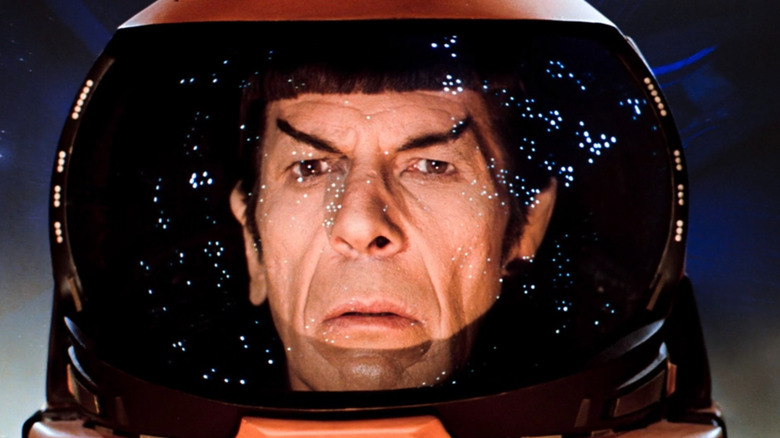
Historically speaking, sci-fi geeks have long held certain truths to be self-evident. Specifically, all the even-numbered "Star Trek" movies are the good ones, and all the odd-numbered "Star Trek" movies stink out loud.
Looking back, it sure seems that way at a glance. "Star Trek II: The Wrath of Khan" was the badass adventure with all the death and destruction and villainy. "Star Trek IV: The Voyage Home" was the funny one with the fish out of water story and the whales, um, in water. "Star Trek IV: The Undiscovered Country" is a thrilling Tom Clancy novel in outer space. "Star Trek: First Contact" is the one with all those cool cyborgs in it.
The tried-and-truism falls apart when you get to the relatively stinky "Star Trek: Nemesis," but for nine movies, every other "Star Trek" film was largely written off as a mistake of one kind or another. And that all began with "Star Trek: The Motion Picture," a gigantic blockbuster production that was measured, even ponderous, and almost completely devoid of the kind of laser battles and blood oaths and wacky jokes that mainstream audiences seemed to crave.
But what if I told you that "Star Trek: The Motion Picture" isn't boring at all? What if I told you it's actually riveting if you just watch it through the proper lens?
Well, you don't have to speculate about that because it's exactly what I'm telling you. "Star Trek: The Motion Picture" isn't just good, actually, it's exciting and interesting cinema, and a fascinating adaptation of all the "Star Trek" that came before.
The Motionless Picture
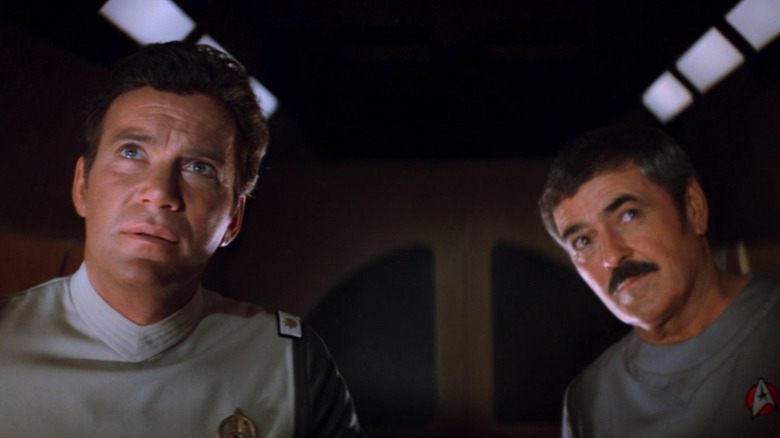
What we now call "Star Trek: The Original Series" (formerly just "Star Trek") ran for 79 episodes across three seasons, briefly becoming a cultural phenomenon, and attracting a legion of die-hard fans, before — like so many beloved genre shows — it struggled to keep its ratings up, and eventually got canceled, arguably too soon.
But here's the thing: There were plenty of successful multi-season television shows in the 1960s that never became a blockbuster franchise, unless there's a "The Many Loves of Dobie Gillis" extended universe that somehow flew under our collective radars. (Okay, okay, there was a 1988 TV movie called "Bring Me the Head of Dobie Gillis," but are you really happy now?)
Gene Roddenberry's "Star Trek" survived and thrived in second-run syndication. It may have been canceled but it never went away, and audiences continued to watch and explore the universe with the crew of the Enterprise for over a decade before "Star Trek: The Motion Picture" finally came out.
The story of how "Star Trek: The Motion Picture" arrived on the big screen is long and convoluted and involves several abandoned projects (one of them was about fighting Jesus), a failed attempt to create a sequel series, and even a feature film that was allegedly put on ice because "Star Wars" was coming out, and surely audiences wouldn't be interested in more than one sci-fi/fantasy franchise, right?
Anyway, when it finally did premiere in 1979, "Star Trek: The Motion Picture" found itself struggling with a world that suddenly had a very different idea of what a space opera should look like. Instead of dashing adventures with sexy young stars, wacky robots, and laser swords, Robert Wise's film was a mature, serious science fiction drama about middle-aged men mulling over the ineffability of the universe and their tiny place within it.
And that wasn't necessarily what everyone was in the mood for.
Star Wars, This Ain't
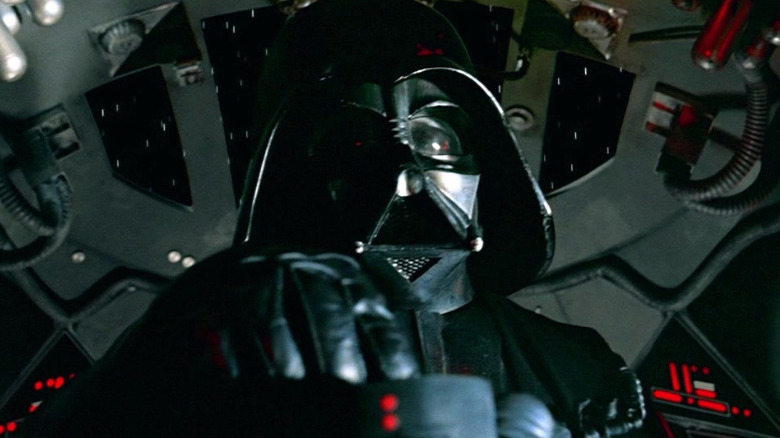
"Star Trek: The Motion Picture" picks up years after the conclusion of the television series when the aging crew of the U.S.S. Enterprise is called back into action after an unthinkably gigantic artificial life form called V'ger starts making its way towards Earth, consuming everything in its path. Instead of waging war on the vessel, Spock (Leonard Nimoy) attempts to communicate with V'ger by venturing inside its nearly infinite space and joining minds with the strange life form.
The film features eye-popping visual effects and a sense of fantastical scale rarely achieved by other motion pictures, even the ones that are more beloved for their CGI enormity. Robert Wise, who had previously directed classics like "The Sound of Music" and "The Day the Earth Stood Still," uses that vastness to explore mankind's — or any sentient species' — place in the universe. It is a film about serious science-fiction considerations, regarding the nature of consciousness and existence itself, and thanks to the film's final twist, the strange butterfly effect that even we in the present day may have on events in the distant future.
So yeah, an audience that equates sci-fi filmmaking to space wizards fighting space nazis isn't necessarily going to glom onto that right away. And although the first "Star Trek" movie made quite a bit of money, it performed below Paramount's expectations, so much so that the sequel, "The Wrath of Khan," was given a much lower budget and a whole new, action-centric tone. It worked, and the film was a major success and is still considered one of the best films in the "Star Trek" franchise (even-numbered or otherwise). Whether you're comparing "Star Trek: The Motion Picture" to "Star Wars" or "The Wrath of Khan," the film is undeniably slower-paced and less eventful.
That's why you shouldn't do that.
Eyes On The Enterprise

The first "Star Trek" movie may take place in outer space, but unlike other hit sci-fi films like "2001: A Space Odyssey" and (at the time) "Star Wars," for audiences, it did not exist in a vacuum. It was a continuation of an ongoing story with characters who had already been introduced, defined, and tested. And unless you watch the film with that context in mind, you just might miss what's so incredibly wonderful about it.
For over a decade "Star Trek" fans had been watching the television series, with all its good episodes and (frankly) bad episodes, on their cathode ray tube television sets. It was a low-budget series and by modern standards, audiences could only have watched it on low-budget formats. The Enterprise was a spaceship, sure, but it was also clearly a model, and its interiors were clearly sparse soundstages held together by duct tape and a dream.
When "Star Trek: The Motion Picture" finally came out, the money was finally available to make it look real, for the very first time. One of the most frequently mocked sequences in Wise's film is an incredibly long montage of shots of the Enterprise itself, as the camera lovingly glides over it, the music swelling in the background, for about five minutes. That's interminable if you just want to get on with the story, but if you're seeing the Enterprise in all of its glory for the very first time, as though it was real and you could fly around it, taking in all of its splendor, it's practically a religious experience.
This, at last, was "Star Trek" writ large — in more ways than one.
Where NOMAD Has Gone Before
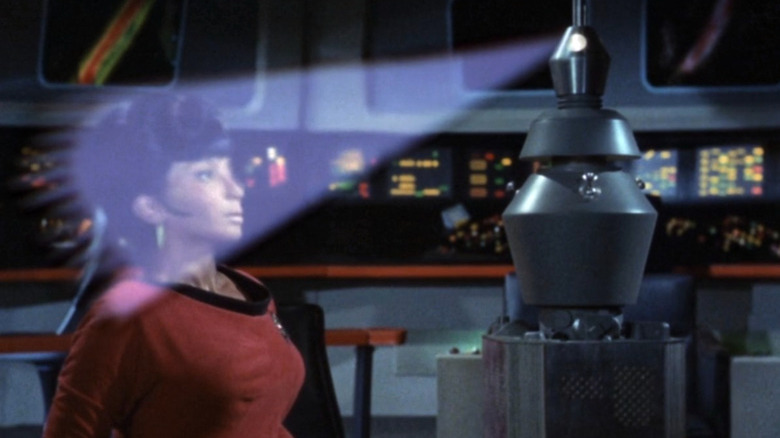
One of the criticisms lobbed at "Star Trek: The Motion Picture" is that the film borrows elements from previous installments of the series. The vast destructive power of V'ger seems to stem from the episode "The Doomsday Machine," where the Enterprise encountered another gigantic juggernaut in space. When the crew finally meets "V'ger" as a character, it has a lot in common with the episode "The Changeling," where they ran afoul of a space probe from Earth called NOMAD, which had also gained sentience and threatened mankind.
Some might argue that this repetitiveness is a flaw, but that's not meeting the film on its own wavelength. Not only is "The Motion Picture" the first time fans saw the Enterprise in all its splendor, but it's also the first time fans saw what every episode of the show would have looked like this whole time if it actually had the budget to realize its ambitions.
Wise's film is the biggest "Star Trek" episode ever produced, and although Roddenberry's creation could encompass a variety of tones and genres — with great episodes incorporating action, humor, horror, philosophy, politics, and beyond — it seems that ur example of the series "The Motion Picture" wanted to recreate was an episode about space, the final frontier, and the place sentient beings have against the backdrop of infinity. Hard sci-fi, not escapist thrills.
The best way to watch "Star Trek: The Motion Picture" isn't in the middle of a marathon with the other movies, it's at the tail end of a marathon of the original series so that its visual wonders can provide the starkest of contrasts, and so all the "Star Trek" that came before it can be reconsidered. The show was always this epic in concept, but now it was epic for real.
Read this next: 12 Reasons Why The Original Series Is The Best Star Trek Show
The post Star Trek: The Motion Picture Isn't Boring – You're Just Not Watching It Correctly appeared first on /Film.
American Horror Movies That Are Banned In Other Countries
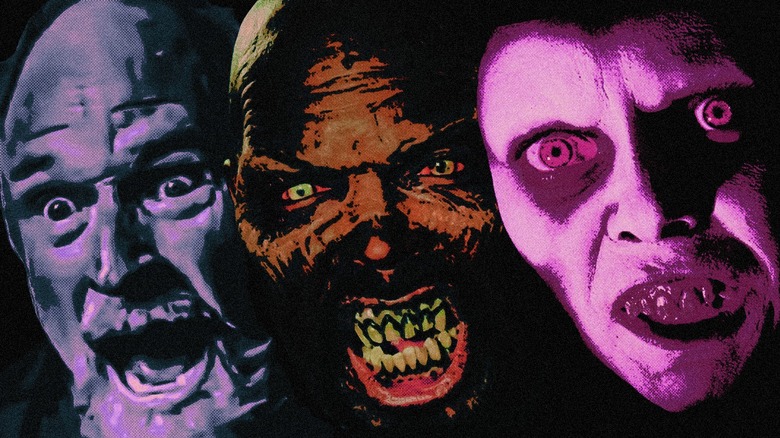
Horror has always been one of the most controversial film genres. From the silent frights of "Nosferatu" to Wes Craven's 1970s shockers, horror films are the harbingers of moral panic and audience debate. Though American horror films have spurred plenty of moral outrage on our shores, it's not common for films to be banned outright in the United States. However, that doesn't mean that American horror films receive the same reception in other counties.
Countries have specific rules regarding censorship and movie ratings, leading some to ban certain American horror films for violating federal guidelines. Horror movies tend to be the most censored genre because of their depiction of violence (as well as sex and nudity), making some horror films unsuitable for viewing due to their explicit depictions of depravity. Censorship like this comes from ethical debates about whether or not pop culture influences the masses: Can violent movies make people more violent?
Regardless of where you stand, film censorship is a fascinating illustration of how moral standards function globally. For you thrill seekers out there, hearing a film has been banned in other countries might make you even more inclined to seek it out. Whether you're interested in the cultural implications of censorship or want to read about the worst of the worst, this list is for you. It's time to explore which American horror movies didn't make the censorship cut!
World War Z (2013)
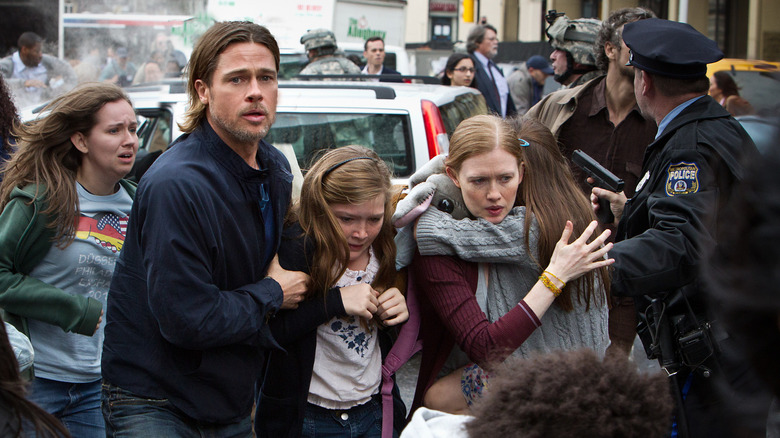
It might seem strange for "World War Z" to make this list, considering it's not generally notable for being shocking. But in this case, there might be other forces at play. "World War Z" stars Brad Pritt as Gerry Lane, a former U.N. investigator, stuck in traffic with his family. Gerry senses something is seriously amiss, and he's right. A virus of unknown origin has begun to spread through the populous, turning ordinary people into thoughtless killing machines. Gerry makes it his mission to find the virus' origin before it's too late.
China banned the film, a decision that limited its international box office numbers by a significant margin. The Wrap reported that Paramount submitted an alternate cut to China's censorship office, hoping it would give them a better chance. They removed a line in the film that questioned whether the virus originated in China. However, that line played during a Superbowl ad, which meant Chinese authorities had likely seen it. There's also the fact that Pritt previously starred in "Seven Years In Tibet," which depicted Tibet's struggle for autonomy from China. The book on which the film was based is also banned in China. Despite losing a significant international market, the film was still a commercial success -- bringing in $540 million on a $200 million budget.
Faces Of Death (1978)
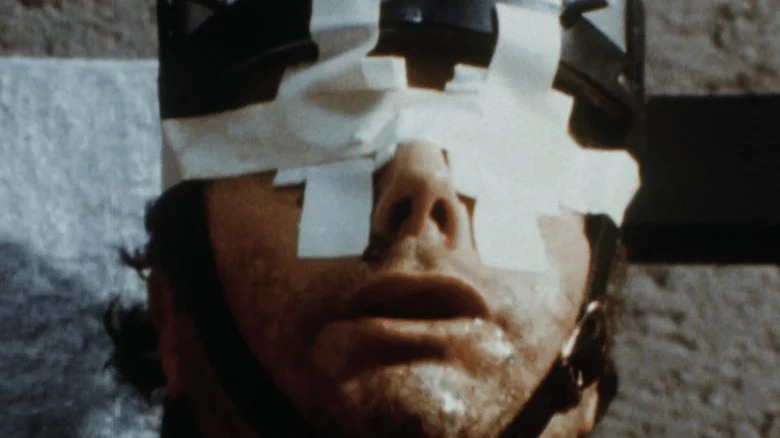
In some cases, internationally banning a film hurts a film's financial potential. Other times, censorship becomes a boon for its marketing. 1978's "Faces of Death" is one of the most disturbing films ever made, and that's exactly what the filmmakers wanted. "Faces of Death" is an exploitation film shot in a documentarian style. Narrated by Francis B. Gröss (Michael Carr), the film follows a pathologist fascinated by all the ways one can die. Its footage presents numerous grisly death scenes (of humans and animals): Some are fake, but many are real-life death sequences.
Despite the controversy surrounding it, the film became a cult classic. Likely, the controversy helped the film secure its status. The VHS cover of the film famously proclaimed "BANNED in 46 countries!" That number is probably fabricated, as there are only records of the film being banned in a few countries. The Guardian reports that the United Kingdom banned the film, as their laws about the distribution of "video nasties" – mainly horror or exploitation films – are fairly strict. Australia also banned it, citing that the violence in the film was "frequent, high, and gratuitous." "Faces of Death" did quite well in the U.S., especially following the invention of the VHS, though several states proposed legislation to keep it away from minors.
Traces Of Death (1993)
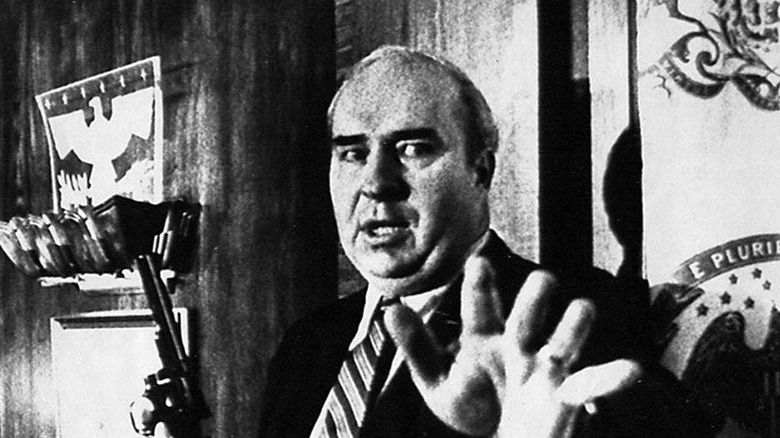
"Faces of Death" spawned several remakes, all of which purported to be more shocking than the last. In 1993, a new exploitation series called "Traces of Death" debuted. Unlike "Faces of Death," "Traces of Death" purported to show only real-life death sequences, with the tagline on its poster reading: "It doesn't get any deader than this." Damon Fox narrates the film. Much of the footage depicted famous events, including the Iranian Embassy siege, Evel Knievel's stunt crashes, notable racing accidents, and the live TV suicide of Budd Dwyer.
Unsurprisingly, "Traces of Death" became banned in the same locations as its predecessor. The British Board of Film Certification called the film sensationalist and dangerous, noting that "the work invites the viewer to take sadistic pleasure in death, injury, mutilation, and pain and encourages callousness towards victims." They were also particularly worried about the effect it might have on adolescents. In Australia, the film wasn't outright banned but customs seized a copy of it. In the United States, a woman living in Pennsylvania rented the film at a video store and found it so shocking that she refused to return it so no one else could see it. She called several animal rights groups and got in contact with the Attorney General, though no ban went into effect.
The Exorcist (1973)
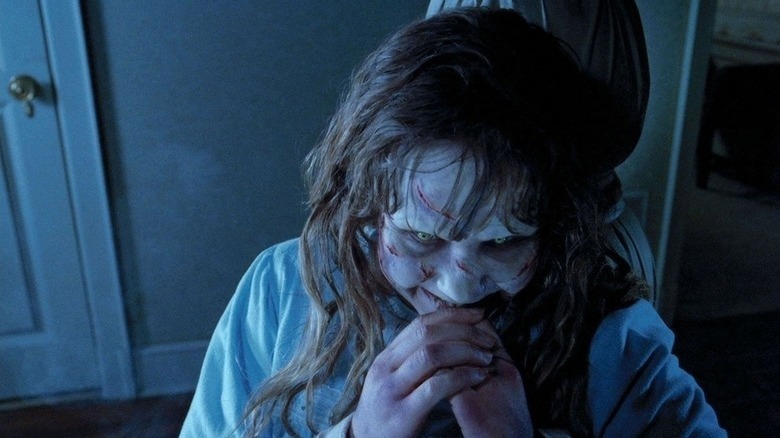
The 1970s is one of the most influential decades in American horror filmmaking. Many of the genre's classics were made in that era and caused a significant amount of controversy. One of the most renowned films of the decade is "The Exorcist," which, perhaps unsurprisingly, provoked a lot of outrage due to its religious themes. The film centers on Regan (Linda Blair), a young girl who starts behaving very strangely. Her mother (Ellen Burstyn) is at a loss, but Father Karras (Jason Miller) becomes convinced the devil possessed her.
In the United Kingdom, the film was not banned. But it was given an "X" rating (meaning suitable for an 18+ crowd) and released without cuts. Nonetheless, several local regions banned the film from cinemas. When the film was released on video in 1981, there were no regulations in place regarding classifications from the BBFC. However, the Video Recordings Act of 1984 added regulations, which meant the film needed to be recertified for a video release.
The board finally made a decision in 1988, concluding that the film should not be accessible to the public in video stores, not even with an X rating. For 11 years, "The Exorcist" was banned in the UK. The ban was lifted in 1999 when the film celebrated its 25th anniversary and distributors re-submitted it for approval.
The Texas Chain Saw Massacre (1974)
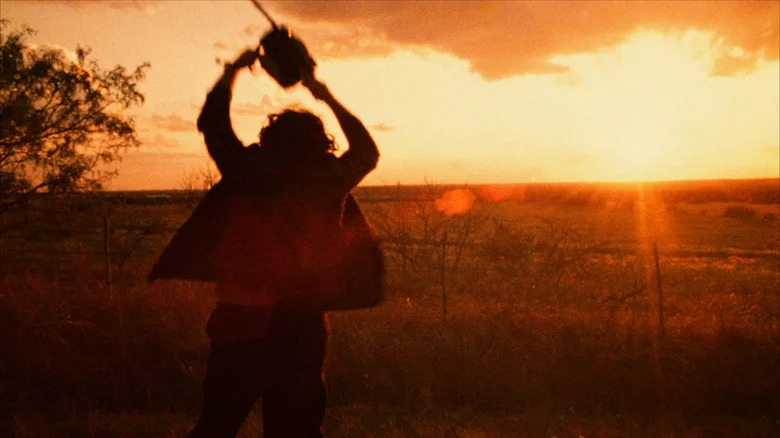
"The Texas Chain Saw Massacre" premiered one year after "The Exorcist," and it saw similar controversy. Tobe Hooper's horror masterpiece follows a group of friends in rural Texas stumbling upon a family of deranged cannibals. The most fearsome member of the family, Leatherface (Gunnar Hansen), wields a chainsaw and makes it his mission to make sure no one gets out alive.
Several countries banned the film, including the UK -- though it subsequently received an 18+ certificate in the late 1990s. According to the Banned Library, Brazil, France, Germany, Finland, Norway, Sweden, Singapore, and Iceland banned the film. Like the UK, they rescinded these bans at a later date.
"The Texas Chain Saw Massacre" is a famously terrifying film: It still shocks to this day. Hooper wanted the film to be watched by audiences of all ages. He made the film to have a PG rating, which was why he limited the amount of fake blood in the film. Of course, the film was given an R-rating in the United States -- though it still did amazingly well at the domestic box office.
The Last House On The Left (1972)
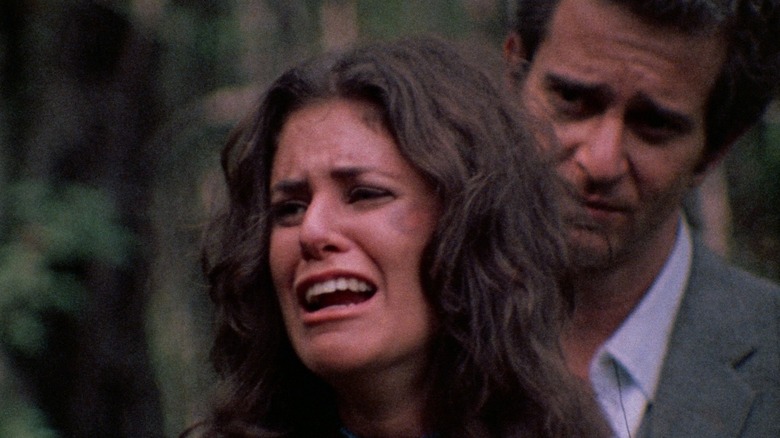
In 1972, horror legend Wes Craven's first film debuted in the United States. "The Last House on the Left" follows two teenagers, Mari (Sandra Cassel) and Phyllis (Lucy Grantham), being tortured and killed by a group of violent fugitives. The killers attempt to seek refuge in a nearby home, not realizing they've just been taken in by Mari's parents.
Aware that the British Board of Film Certification might take issue with the film, "The Last House on the Left" came with a note to the BBFC. The letter read: "Before submitting the film to you we have already made considerable cuts, thereby eliminating much of the goriness that was in the full-length version...It is not my intention to exploit the film." Despite that heartfelt plea, the film was ultimately rejected by the board: They did not see it as fit to release for public consumption. "If we are to go into this area of sexual violence, it will have to be for a film in which we detect greater merit than this," wrote BBFC Secretary Stephen Murphy.
The distributor then wrote back to Murphy, pleading for the decision to be reversed. Still, they upheld the ban. Though it was available for a brief period on VHS, shortly thereafter the film was again deemed obscene and was seized as a "video nasty." Until 2008, the uncut version of "The Last House on the Left" was not made available to the British public.
Land Of The Dead (2005)
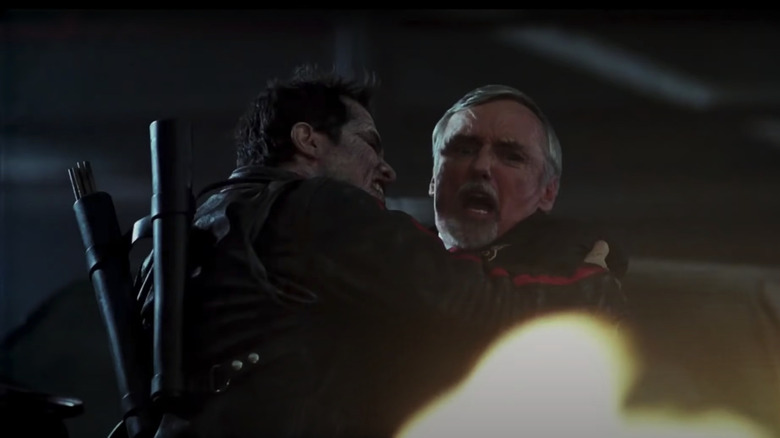
While some horror films are banned because of high levels of violence or gore, others are because of distinct cultural issues. 2005's "The Land of the Dead" was banned in Ukraine, though not for the reasons you might think. Directed by George A. Romero, often known as the father of the zombie film, the movie takes place in a world where most of the population are zombies. The uninfected have built a series of feudal-like states across America. The leader (Dennis Hopper) an enclave in Pittsburgh rules with an iron fist, but some of his citizens have started to fight back.
Ukraine's Culture Ministry banned the film, calling it "not just another zombie film" (via Variety). Maksym Rostotsky, a member of the commission, told the press that the famine of 1933 – which provoked instances of cannibalism – "is still fresh in our society." He suggested that the film hits a little too close to home for Ukrainians. "A movie with scenes of people being eaten alive should not be given the go-ahead," he added. Distributors in Ukraine could have faced criminal prosecution had they screened the film.
Maniac (2012)
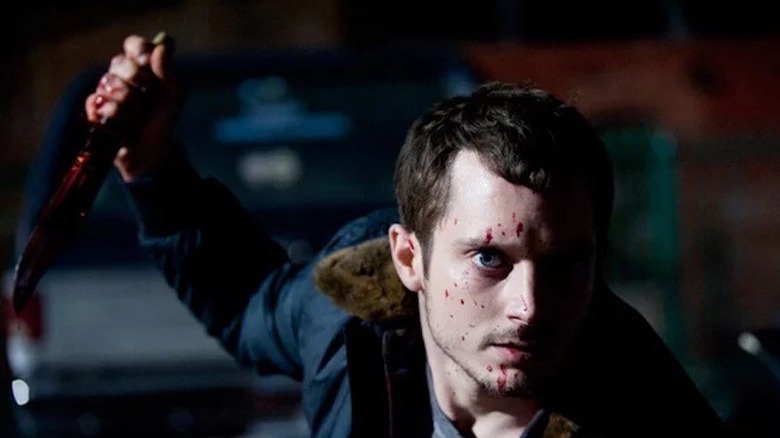
In the filmmaking industry, New Zealand may be best known for being the shooting location of the "Lord of the Rings" series -- a real-life counterpart of The Shire. However, that didn't stop the country from banning a film starring a famous hobbit. New Zealand banned the Elijah Wood-starring film "Maniac." Outside of film festivals and DVDs sold, it couldn't be shown to the public.
The film is a remake of the 1980 William Lustig film of the same name, which follows Frank Zito (Wood), a young man with schizophrenia who works in his family's mannequin restoration shop. Frank had a traumatic childhood and has become a prolific serial killer. He scalps women and attaches their hair to mannequins. The film is shot entirely from Frank's perspective, which is precisely why the Office of Film and Literature Classification felt it should be banned.
Ant Timpson, a programmer at the New Zealand International Film Festival, explained the decision of the OFLC. He claimed, "The POV nature of the film mixed with the psychopathic behavior of actor Elijah Wood is more than disturbing, it's potentially dangerous in the hands of the wrong person — that is, a non-festivalgoer." Neil Foley, the head of the distribution company distributing the film in Australia, stated that "banning the film beyond festival screenings is an insult to the intelligence of the adult population of New Zealand and does little more than to serve as an open invitation to illegally pirate the film."
Saw VI (2009) And Saw 3D (2010)
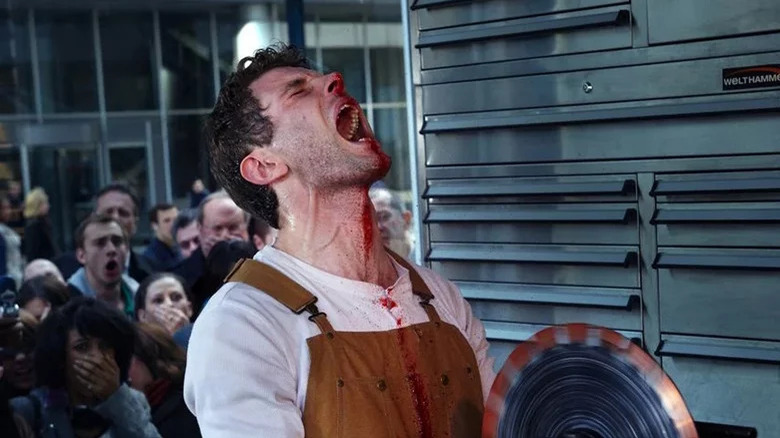
The "Saw" films are well-known for being some of the goriest and most brutal horror films, so it's not too surprising they wouldn't be accepted with open arms on a global scale. In fact, at least two different Saw films were banned internationally. "Saw VI" faced a ban in Trinidad and Tobago as well as Thailand (via CBS news). The sixth in the series continues to depict the effects of Jigsaw's game, while also focusing on the evolution of his predecessor, Hoffman (Costas Mandylor).
Germany banned "Saw 3D," ruling that the film should be confiscated nationwide for violating §131 StGB, which concerns the "glorification of violence." Among other things, "Saw 3D" follows a self-help guru (Sean Patrick Flanery) who has become famous after falsely claiming to be a survivor. "Saw 3D" is the first in the franchise to be banned in Germany, though a censored version labeled "no youth release" is available for sale in the country.
Though "Saw 3D" was not banned in the United Kingdom, it did stir up some controversy there. The film's trailer was banned in the UK after a 10-year-old saw it on television and complained that it was "distressing." The trailer had already been cleared to be shown only after 7:30 p.m. -- the child saw the ad at 8:30 p.m. -- but The Advertising Standards Authority concluded that was "not sufficient." They ruled that the ad could only be played after 9:00 p.m. after the complaint.
The Bunny Game (2010)
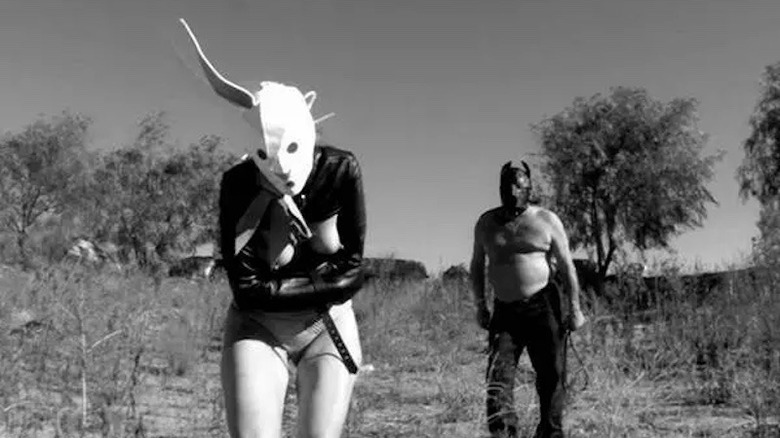
Coming in at number 37 on Complex's list of The Most Disturbing Movies of All Time is "The Bunny Game," a low-budget horror film created by Rodleen Getsic and Adam Rehmeier. The film centers on a sex worker, Bunny (Getsic), being kidnapped by a deranged truck driver and subjected to horrific torture. Conceding that it's ultimately a well-made film, Bloody Disgusting's David Harley argued, "The Bunny Game is captivating, but ultimately not an experience worth having."
Unsurprisingly, the UK banned the film. The BBFC has strict guidelines regarding sexual violence, stating: "Any association of sex with non-consensual restraint, pain or humiliation may be cut." The explanation for the BBFC ban was due to how the film's nudity "eroticize[s] what is shown." They also suggested that the narrative and the way it was shot might lead some viewers to empathize with the killer. Over the course of 100 years, the BBFC has rejected around 1,000 films. In recent years, they average one to two rejections per year.
If you or anyone you know has been a victim of sexual assault, help is available. Visit the Rape, Abuse & Incest National Network website or contact RAINN's National Helpline at 1-800-656-HOPE (4673).
Mikey (1992)
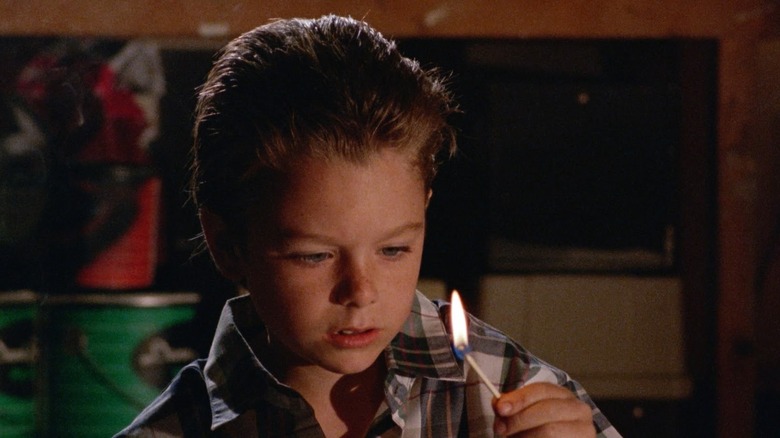
The 1992 film "Mikey" depicts one of the most disturbing horror narratives possible: a murderous child. The film's titular character (Brian Bonsall) is a nine-year-old boy living with a foster family. When his family members are mysteriously killed, he's placed with another family, who will soon discover Mikey's true nature. The film includes images of children being killed and a child killing.
The film was submitted to the BBFC for classification at the end of 1992, at which point it was classified as suitable for those over the age of 18. Later they reassessed the decision, following the murder of two-year-old James Bulger in February of 1993 by two ten-year-old boys. The board spent years deliberating about the case, and things only became more complicated with the 1994 amendment to the 1984 Video Recordings Act, which took into consideration underage viewing of home videos.
Finally, after four years of deliberating, the BBFC came to a decision, declaring that they would not classify the film for a home video release. The BBFC noted that the film was likely to cause harm "to and by a small but significant proportion of potential viewers whose behavior might be dangerously influenced by it." Though the film's distributor could have tried for a theatrical release at this time -- four years after it was initially released in America -- they chose not to do so.
Read this next: Horror Movies That Even Horror Fans Could Hardly Finish
The post American Horror Movies That Are Banned In Other Countries appeared first on /Film.
Akira Kurosawa's Seven Samurai Should Have Been 'Impossible' To Make In Japan
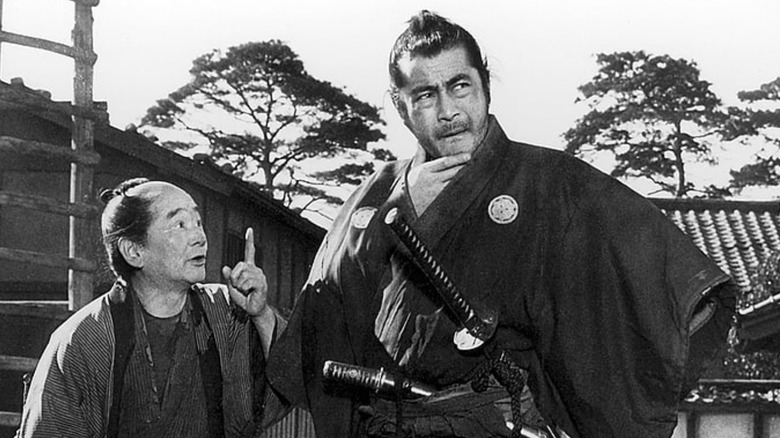
The global appeal of Akira Kurosawa's "Seven Samurai," which is a fusion of the chambara (swordplay) and jidaigeki (period drama) genres, cannot be overstated. Set during the Sengoku period, "Seven Samurai" hones in on a village pillaged by marauding bandits, which prompts the inhabitants to seek protection from a group of rōnin. Apart from amalgamating narrative tropes to form an almost sublime, engrossing drama about the cycles of shame and violence, Kurosawa uses emotionally-resonant internal conflicts to heighten dramatic stakes, elevating the film beyond the scope of a garden-variety period piece. No wonder "Seven Samurai" still has an overwhelming impact on contemporary action subgenres. Scores of filmmakers owe a lot to the film for cementing the popularity of genre tropes, including heroes assembling to serve a mission and a heroic wild card acting as the catalyst for dramatic revelations to further the plot.
The shadow of influence cast by Kurosawa's most acclaimed samurai film becomes doubly impressive when one considers the practical obstacles that the director faced to bring his vision to life. For starters, "Seven Samurai" was extremely expensive to make, as Kurosawa was obsessively dedicated to creating larger-than-life sets and props that would lend authenticity to the historical era depicted in the tale. Kurosawa's decision to work with a meticulously built set on the remote Izu Peninsula — as opposed to a cheaper, Toho-backed — studio drastically increased production costs, which snowballed into attempts by the studio to rein in the director. All attempts to do so were met with steady defiance.
Considering budgetary constraints alone, "Seven Samurai" should have been impossible to make in Japan at the time, but Kurosawa managed to accomplish the impossible. Here's what he had to say about the difficulties of making a riveting drama that demanded sets that were as realistic as possible.
A Richer, More Vivid Samurai Drama
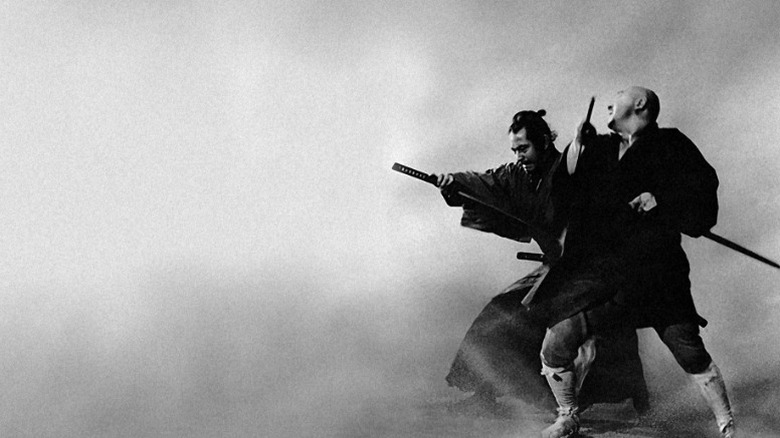
In an interview where Akira Kurosawa details his thought process behind "Seven Samurai," the director remarks that most Japanese films at the time were inclined towards being simple but wholesome, akin to a comfort meal at home. With the intent of doing something different, Kurosawa edged toward making "richer films," which would be enthralling from start to finish. However, this kind of endeavor meant pushing the limits of filmmaking norms and standards in Japan, which meant that the project faced several obstacles during its making:
"Something always comes up. We didn't have enough horses; it rained all the time. It was just the kind of picture that is impossible to make in this country ... It was difficult making that film. But it was wonderful work too. My own staff, those people who always work with me ... well, there are no better people in the world to work with. Even if I didn't tell them how to do a single thing, they would know just what I wanted. It is due to people like this that I have been able to make films such as this one."
Kurosawa's labor of love, which ended up being "too long" (3 hours and 17 minutes), was screened at various lengths for different audiences. While the original uncut version was released in Japan for a brief amount of time in choice locations, a shortened version premiered at the Venice Film Festival, a variation of which was majorly favored by global critics. However, one did not have to necessarily sit through the uncut version to appreciate the aesthetic and technical genius of the film; the action sequences alone vouched for its visual rarity, along with the fact that "Seven Samurai" was a landmark achievement, especially within the context of 1950s Japanese cinema.
Why Seven Samurai Is Still Influential
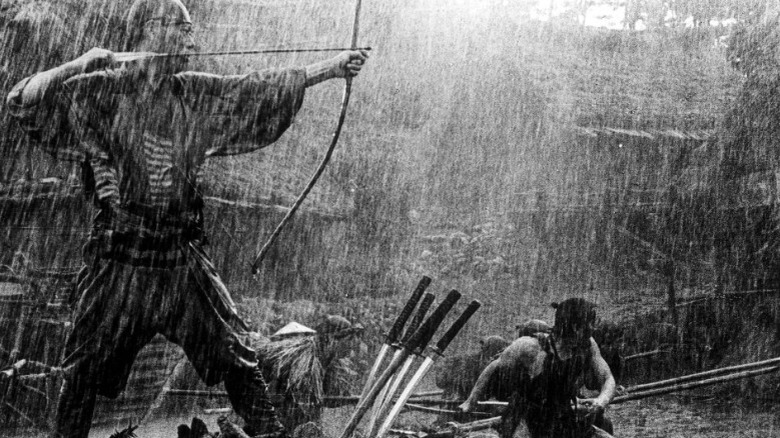
There are a string of factors that contribute to the brilliance of "Seven Samurai." First and foremost, Kurosawa established an impressively cool visual language for the film, which understandably led to several Hollywood westerns directly influenced by the visual flair of the original. The impeccable usage of slow-motion to emphasize a character's stance, along with fluid camera movements to demonstrate the badassery of the rōnin, reinvigorates what might have been a straightforward tale about cyclical conflict. Moreover, such visual badassery is layered with nuanced commentary about class and (flawed) codes of honor via the character of Kikuchiyo (Toshiro Mifune), who desperately aspires to shed off the confines of his origins and find acceptance among a group of warriors.
This examination of human conflict requires a closer inspection of groupthink tendencies colored by shared experiences, and Kurosawa excels in portraying this aspect by pitting the ruthless samurai against the suspecting farmers. Both parties have reasons to regard the other with disdain, but the truth of the matter emerges as more multifaceted than it initially seems. This simple, yet essential truth serves as a template for convincing stories that can be told in varying settings and contexts, without running the risk of being repetitive or reductive.
Granted, there have been countless homages to Kurosawa's original that boast merits of their own, but "Seven Samurai" still remains the prime example of a simple tale told succinctly and effectively. The film manages to inspire deep introspection without sacrificing its entertainment value; a combination that is quite difficult to nail, especially under limiting circumstances.
Read this next: The 15 Most Influential VFX Artists In Movie History
The post Akira Kurosawa's Seven Samurai Should Have Been 'Impossible' To Make In Japan appeared first on /Film.
'Clearest Evidence Yet' of Ancient Lake on Mars Found by NASA's Curiosity Rover
Read more of this story at Slashdot.
43 Best Christmas Gifts and Ideas for Every Price Range
Rebel FM Episode 570 - 02/10/2023
How Anyone Can Retire Early In 10 Years (Or Less!)
Anyone Can Retire Early, But Few Succeed. Here's Why…
Key Ideas
- The simple math that makes it possible for anyone to retire early and achieve financial independence.
- Why you don't have to be a brilliant investor or possess any unusual skill to retire in 10 years or less.
- The key action steps you must take today.
Surprisingly, early retirement is not that hard.
Hitting the lottery or inheriting a windfall from ol' Aunt Myrtle isn't required.
Similarly, you don't have to become a brilliant investor or possess any unusual skill to retire early.
The strategies that work are repeatable and predictable science—not random luck.
In fact, the science supporting early retirement is so simple, literally anyone can do it.
However, almost nobody is willing to do it…and therein lies the rub.
Let's start by proving the theory with mathematics, talk a bit about why so few people succeed, and then explore the steps you must take to ensure the strategy can work for you.
Get This Article Sent to Your Inbox as a PDF…
Send Me This Article!
How the Math of Early Retirement Works
Let's play with some simple equations to illustrate the point.
We'll assume $48,000 per year earned income to keep the taxes low and the math easy. Alternatively, you could just assume $48K after taxes and eliminate the tax complication from the equation. That works out to $4K per month spendable.
(By the way — the actual income level is irrelevant to the calculation, as you will see below, so use whatever income works for you. The key is the percentage of income that is dedicated to savings.)
Using one of my handy retirement calculators, we'll determine how long it takes to save your way to financial independence applying industry standard numbers like 8% for investment return, and 3% spendable retirement income to support living expenses. Another invaluable tool is the retirement planner available with a free Personal Capital account; when you link your existing investment accounts and enter assumptions about how much you'll spend and save, Personal Capital can show you exactly how soon you'll be able to retire based upon projections of your specific investments. Learn more about Personal Capital in our review.
If you saved 70% of your income, or $2,800 per month, at 8% return, you would have $515,000 at the end of 10 years.
Related: Why you need a wealth plan, not a financial plan.
Yes, I know that leaves you with only $14,400 per year to live on (I'll address this issue later), but the fact is, you'll be financially independent in 10 years because 3% of $515K is $15,450 in spendable income. This would be $1,000 per year greater than what you had been living on.
(If that math went by a little too fast and you want more detail, read this book: How Much Money Do I Need To Retire. It explains everything in step-by-step detail… plus a whole lot more.)
If you're really in a hurry to tell your boss what he can do with your job, and don't mind extreme frugality, then try saving 80%. You could be financially independent in less than 7 years, because $3,200 per month at 8% results in a $361,000 savings balance, providing $10,830 of annual spendable income at 3%. This is greater than the $9,600 ($800 per month) you would be living on for this scenario.
Quieting the Early Retirement Naysayers
The first and most obvious comment nearly every reader will have to these two examples is something like, “Cute idea, Todd, but I can't even get by on 100% of my income. The idea of living on 20-30% is a pathetic joke! Your article is complete rubbish!”
(Come on… own up to it. The little voice in your head was saying something like that. Right?)
Here's the rub. That's only true for the people making those lifestyle choices. It's not “the truth”.
There are many people who have committed to extreme frugality as a lifestyle choice because they don't want to spend any more of their life than absolutely necessary working for money. They would sooner live without the luxuries that others have claimed are necessities than pay the price of working to have all that stuff.
It's an expression of personal values.
There are people who choose to live in motorhomes, use public transportation or their bicycle, shop only at thrift stores, grow their own food, and so on to keep expenses to a bare minimum.
It can be done. It's possible if that's your choice.
Alternatively, living on 20-30% of your income doesn't have to equate to extreme frugality. Try running the same numbers with $250K or $300K in income.
It leaves plenty of spending money for lifestyle today. Sure, it's far less than you could afford at that income level, but again, it's a choice.
In fact, I initially built my wealth following this exact formula. It totally works.
I just raised my income to a very high level, paid my house off, and never got frivolous, but never suffered. I chose my spending consciously based on my values (personal growth, reading, research, outdoor sports, adventure, and recreation), and never needed to spend much of the fat income.
The bulk went to savings with little effort or discipline. Presto! Instant financial freedom.
So anyway, it does work, and it's do-able. People do it every day.
Others might attack the 3% spending rule or the 8% return on investment. My answer is save your breath.
3% spending is easy to support in perpetuity because a portfolio of quality dividend stocks would pay that (and likely more) while growing to adjust for inflation, and without ever touching principal. It's easily do-able.
Similarly, 8% growth during the 10 years in this example is supportable using investment strategies designed to safely support growth that I teach my coaching clients and students in my courses, including Expectancy Wealth Planning.
Related: 5 Financial Planning Mistakes That Cost You Big-Time (and what to do instead!) Explained in 5 Free Video Lessons
However, even if you disagree with me on this point, the argument is moot because the compound return represents very little of the asset accumulation over this short time period. The math is dependent on the percentage savings rate – not the growth rate. It helps, but it isn't critical.
The time is just too short to make a big difference. Don't waste your energy arguing details – it all boils down to the savings rate.
Also, notice that I didn't include Social Security, pensions, or anything else. This is simple, stripped down math to make a minimalist point that is unarguably clear.
Anyone can retire early and live with financial independence (but not freedom) in 10 years or less. It's absolutely, 100% do-able.
I've done it, lots of other people have done it, and there are many entire web communities of people trying to walk the talk like the one run by Jacob at EarlyRetirementExtreme.com.
If you're a naysayer, then just be honest with yourself and realize your negativity is all about a lifestyle choice – not the viability of the strategy.
With that said, the reality is very few people will ever succeed with this approach. Let's look at why.
Why So Few People Will Actually Retire Early
You probably already guessed why so few people are able to follow this plan…
It takes the self-discipline of a celibate monk living in a brothel to survive on 20-30% of what most people earn in our current culture. I did it easily because my income was substantial while living the simple life as a single male.
It would have been much harder if I was married with kids on an average income.
Does that mean you can discount this article and throw the idea away? No!
The math is the math. I'm teaching you how saving your way to financial independence works.
Related: How to be a pro at growing your wealth
This is one of three paths to financial independence. (The other two are real estate and owning your own business). The rules are inviolable. They are scripture in stone.
You can't argue with them. It's just math.
You can reduce the savings rate and lengthen the time, but you can't change the math.
- Staying with the example above, a 25% savings rate ($1,000 per month) compounds to roughly $1,149,000 in 27 years where it will finally replace the 75% of your earned income you're spending. This example isn't as rock-solid because the time period is much longer, meaning you have to start including inflation and other complicating factors to make it realistic; however, the principle demonstrated is consistent.
- A 10% savings rate in our simplified example requires a traditional career duration of 40-45 years to make sense of the numbers. It's the classic retirement savings formula most people are taught to follow – save 10-15% throughout a normal career duration to replace 80-90% of earned income – but few actually ever do it.
There are a couple of key principles you want to understand with this strategy…
- The critical factor to success is the percentage saved from earnings. Every 10% increase in spending adds a little more than 3+ years to the process, because it not only decreases how much you save, but it increases the threshold of spending your assets must overcome as well. It's a double-edged sword.
- Investment return and inflation have very little effect when the time period is short (high savings rate). However, investment return and inflation have a huge compounded effect when the time period is long (low or traditional savings rate). You must plan accordingly.
- Almost nobody is motivated enough by financial independence to persist with a frugality discipline for 10 years and then survive on the same level of income for a lifetime. That's why so few people ever achieve financial independence following this path.
Frankly, I question if early retirement is even a worthwhile goal as stated in this post here.
Questioning the Goal of Early Retirement
All of this begs the question, “Is your goal financial freedom or financial independence?”
Surprisingly, they aren't the same thing.
You can be financially independent on $15,000 per year in 10 years or less with the above example, but you'll have to give up some freedom to achieve it.
Living low on the economic scale limits what you can buy and do with your life. These limitations are antithetical to freedom and cause what I call a “poverty mentality.”
Every corner must be cut, every dime squeezed for maximum blood. It creates an obsession with spending and money that doesn't equate to happiness for most people.
Unless your values are inherently extremely frugal, you'll constantly make concessions to save money as decisions are based on the right side of the menu of life (prices). Rather than work for money, you'll spend a comparable amount of life energy working to save money through all the frugality strategies required to make ends meet.
This is not a right/wrong question – it's just reality. It takes effort to figure out how to spend less and survive on less.
Money buys convenience, but that convenience comes at a price because you have to give your life energy in the form of work to earn it in the first place. Everything is a trade-off. There's no perfect answer.
For example, extreme frugality would limit my ability to take my family to France for a month (like I did last year), which honors my values for adventure and life experience. I wouldn't be able to honor my values on education by paying for quality, private schools for my kids.
I wouldn't be able to honor my health values by paying for professional services like sports training, physical therapy, or expensive organic food. All these things would be luxuries in a world dominated by frugality thinking.
These would all be limitations to my freedom and would dishonor my values. In my personal experience, that's antithetical to true wealth and personal freedom. Others would disagree, but that doesn't make them wrong.
It's all a question of values.
Integrate Your Plan to Retire Early with Your Values
Extreme frugality is not everyone's cup of tea. It works fabulously for some people, and it's a recipe for misery for others.
The key is to integrate your plan for financial freedom with your values. The two must be congruent because the goal isn't just financial independence – the goal is true wealth and personal freedom.
For example, the spending level that honors my values as a 50 year-old, middle class, head-household, family of four, is much higher than when I was a single male straight out of college. It's probably higher than it will be 10 years from now when my kids are grown.
You must design a financial plan to reflect whatever reality is true for you. That's always the starting point when I begin working with coaching clients.
We co-design a wealth plan for financial freedom that integrates every aspect of their life: values, spending, life habits, skills, resources, interests and abilities.
Related: Here’s a scientific system to build your wealth now
We define their leverage points and competitive advantage into a plan specific to their needs.
Some clients save their way to wealth using the formulas discussed here. Others choose real estate and/or building a business to better leverage their passions and interests (this employs entirely different equations beyond the scope of this article).
Most use some combination of these three paths to wealth (I usually encourage two of the three paths).
One size does not fit all. Your wealth plan must fit you like a favorite pair of jeans in order for you to succeed with it. It must comfortably wrap every curve and unique attribute of your being, or it won't feel right and you won't stick with it long enough to succeed.
Getting your plan right is the first step to financial freedom on which all subsequent decisions and actions are built.
One of Only Four Paths to Wealth
In summary, the purpose of this article was to illustrate how the rules of frugality and saving your way to wealth can be applied within your wealth plan to help you retire early. It's one of four potential paths to wealth.
- Some people wing it and get lucky (for example, they win lotteries, inherit millions, or are in the right place at the right time when their employer goes public.)
- Others use the traditional saving strategies described above and try things until they get it right.
- A large number of people hire financial advisors to do the work for them. This can work, but it's extremely expensive and often much slower than option 4 (or even option 2).
- Smart people realize there is no one-size-fits all solution, and they must use proven strategies to design their own individual wealth plan.
To do this, traditional savings strategies are usually the primary choice (coupled with real estate) for W2 employees who lack entrepreneurial dreams. Entrepreneurs will typically build wealth through their business, and park that wealth in paper assets or real estate.
Let me reiterate: There is no such thing as one-size-fits-all when it comes to wealth planning. It's a very personal choice.
How fast you want to achieve your wealth goals through savings (7 years? 40 years?) is purely a lifestyle choice and a statement of your personal values and priorities. The paths you choose to realize your financial dreams should reflect your life situation.
The thing to note about paper asset savings plans is they're governed by specific mathematical rules and limitations. If you want to break out of those mathematical rules and get more creative, then you must include the other two asset categories—real estate and business.
…which is why they will be subjects of future articles, so stay tuned.
Finally, if you have any questions about what it takes to retire early, everything is explained in great detail and made fully actionable in this step-by-step course showing you how to design your life to create financial independence.
Let me know how I can help.
Anybody can learn to build a secure retirement -- and you don't need a financial advisor.
My course, Expectancy Wealth Planning, has been called "the best financial education on the internet" and provides all the knowledge you'll ever need to build the life -- and retirement -- of your dreams.
The Child Clicker's Audition Tape For The Last Of Us Was Pure Nightmare Fuel
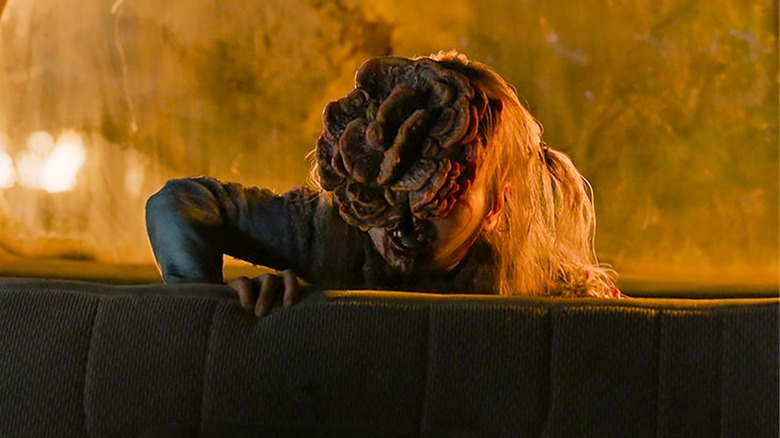
This post contains spoilers for episode 5 of "The Last of Us."
Plenty of awful things happen in episode 5 of "The Last Of Us": impossible decisions are made, lives are unfairly lost and hopeful futures are stolen. Also, a new, terrifying creature enters the horror pantheon by showing us that yes, the mushroom zombies are capable of being even scarier than we originally thought.
Believe it or not, the monstrous MVP of the episode is not the big boy Bloater who literally rips a man's head off — it's so much worse than that. It's a child clicker who crawls through a window, scares the hell out of Ellie, and later, saves her life by mauling a woman to death. This little girl, with her flowered head and adorable "Blue's Clues" shirt, is absolutely haunting. In the official companion podcast for "The Last of Us," series co-creators Craig Mazin and Neil Druckmann admitted that this was entirely by design.
For reasons beyond explanation, the duo decided that a horde of runners, clickers, and even a bloater erupting from the ground was not enough. They wanted something so scary that it would be seared into our brains. That's how they came to hire nine-year-old contortionist, Skye Cowton.
Clickers: The Gift That Keeps On Giving
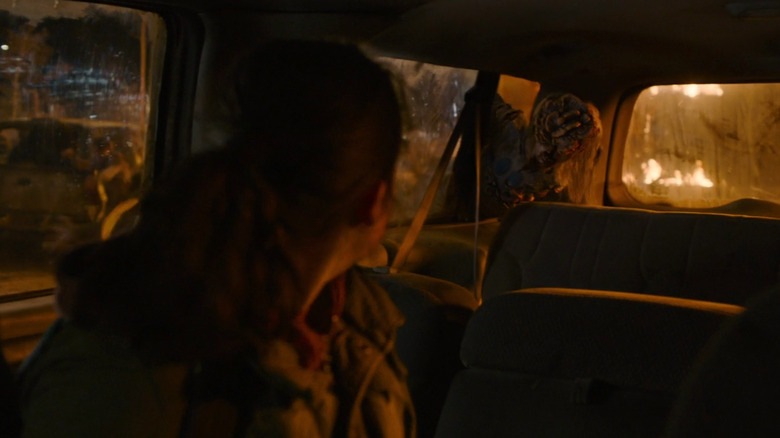
First, Mazin and Druckmann requested the help of the Naughty Dog artist who designed the original clickers, Hyoung Nam. As the source of the OG horror, Nam had no trouble whipping up a new design for the adaptation: a child clicker, who would play a pivotal role in "Endure and Survive." He provided the illustration, solidifying the concept and leaving the creators with the unenviable task of finding the perfect actress.
Plenty of audition tapes were received, featuring lots of highly-skilled contortionist kids. But according to Mazin, "[Cowton] was the most terrifying." It was so creepy that they had no choice but to hire her. Once they married her natural skill with the magic of post-production, poor Kathleen (the Melanie Lynskey character who the clicker eventually feasts on) didn't stand a chance. Mazin said:
"She's this beautiful little girl, but [...] it's so creepy how she can move her body like that. And so, it was a combination of her performance, and then Wētā kind of creating, taking, drafting off of what Barrie Gower had created with prosthetics, and then making this little girl. And I insisted that our child clicker wear a 'Blue's Clues' shirt because I'm really sick, and I just loved the contrast of innocence and horror."
How exactly does one audition to be a child fungus zombie? "Please show me how you would bite into Kathleen's flesh?" Or maybe, "Slide into this car window but make sure to give me nightmares while doing it."
All Hail The Clicker Child
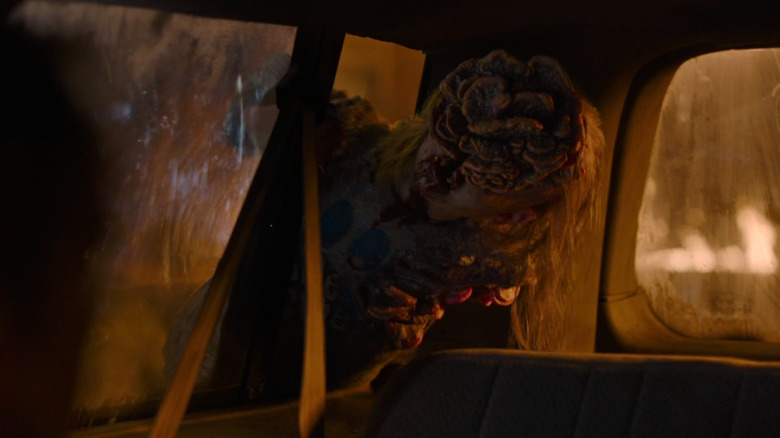
Mazin was obviously onto something with that "Blue's Clues" detail. Creepy undead children are a staple of the zombie genre for a reason. I'm still haunted by the little white walker girl who kicks off the "Game of Thrones" pilot and frankly, remains much scarier than the guy at the head of the ice zombie army. Fungus girl is no different! She puts all the other infected to shame, because not only does she share their vicious intent, creepy fungal growths, and rabid movements — she's got the dexterity of a gymnast. The girl moves like a spider in her pursuit of Ellie, which no doubt traumatizes the poor preteen.
Cowton, a rhythmic gymnast who was nine at the time of filming, pulls off enough creepy contortions to rival M3GAN. If not for the whole 'mind and body being taken over by fungus' thing, I bet her character would get along great with the dancing robot villain! At the very least, they both understand that murder deserves an artistic flourish or two.
Read this next: 12 Things We'd Like To See In HBO's The Last Of Us
The post The Child Clicker's Audition Tape For The Last Of Us Was Pure Nightmare Fuel appeared first on /Film.
Michael Douglas Would Return For Ant-Man 4 Under One Condition
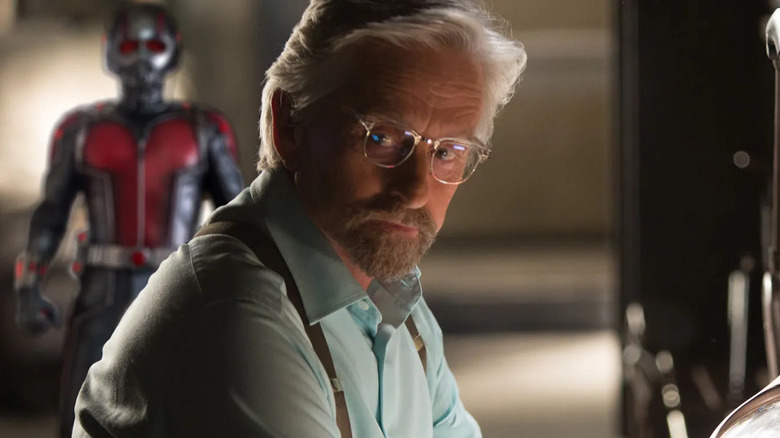
Michael Douglas remains a remarkable get for Marvel. He's an Old Hollywood Grade A Bonafide Movie Star™ and his mere presence elevates one of the goofier superheroes in their catalog. He's an inspired pick for a mentor to the new Ant-Man, Scott Lang, who can also slap back with his own brand of sass whenever Paul Rudd gets ornery.
And to his credit, Douglas never seems to look down on being in a giant superhero franchise. He's been folded into "Avengers" movies and has been de-aged multiple times for flashbacks, which again carries some baggage for movie geeks, because when we see "Wall Street"-era Michael Douglas, we get all warm and tingly inside as the nostalgia floods our brains.
There may be signs that he's ready to hang up Hank Pym's particles, though. When he spoke with The Hollywood Reporter at the red carpet premiere of "Ant-Man and The Wasp: Quantumania" he was asked if he'd come back for "Ant-Man 4" and his response was very ... Harrison Ford-ish. That's right, Douglas wants Hank Pym dead.
#AntManAndTheWaspQuantumania's Michael Douglas talks about his experience with returning back to the franchise pic.twitter.com/GO4Ztc5Tda
— The Hollywood Reporter (@THR) February 7, 2023
Douglas is, of course, a professional (he has been in the business for well over 50 years at this point), and makes sure to feign some excitement for taking part in these movies, but it's pretty clear right up front when he's asked how excited he was to return to "Ant-Man" that he's really reaching for something authentic and nice to say. He does seem to genuinely love his cast and director, speaking very highly of Peyton Reed, but there is a tiredness to his voice that is unmistakable.
Even If He Gets His Wish, Death Is Rarely The End At Marvel
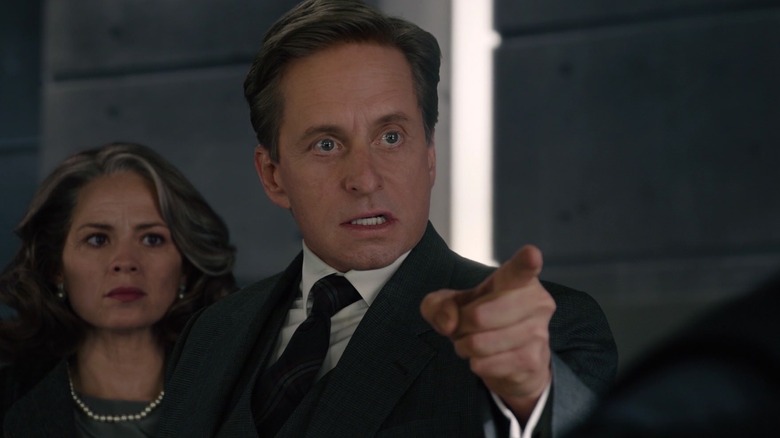
Let's also not forget that death isn't always the end, especially in Marvel movies. Even if they stick to their guns and don't pull soap opera-dramatic "he was alive all along" reveals, Marvel does love to jump around in time and play with their fancy de-aging software, something they've already done a couple of times with Douglas. We've seen 1980s Michael Douglas and 1970s Michael Douglas so far.
So much of Marvel's storytelling is about how the past impacts the present. That's a theme integral to Captain America's character, for instance, and further solidified with "Avengers: Endgame" being all about important moments in the past.
The entirety of Phase 4 has been about the characters and the world reacting to the big events of the last two "Avengers" movies. They love to look back and have so far done so in a way that hasn't cheapened any of the sacrifices the characters have made along the way.
Even if Hank Pym has a noble sacrifice in "Ant-Man 4," they could still call him back for some good flashback stuff, especially since most of Hank Pym's adventures as the first "Ant-Man" have gone untold. And don't get me started on the multiverse possibilities. All we need is Dr. Strange to open up a sparkly window into another dimension if we want to get a nice little glimpse of our favorite grumpy old Ant-Man.
Let Pym Die?
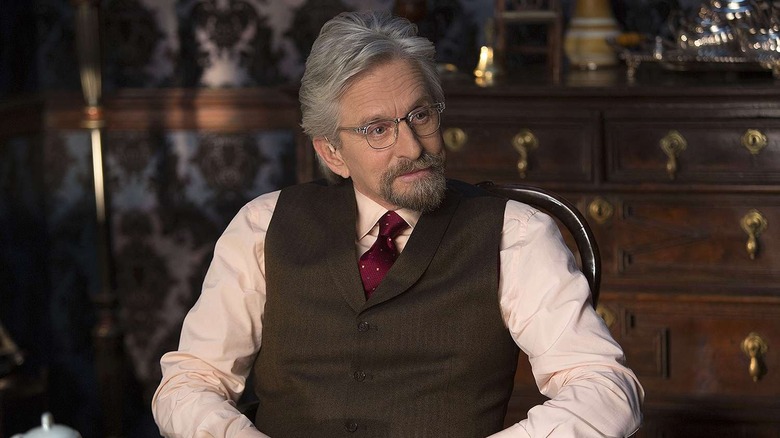
Basically, what I'm saying is if they do kill off Hank Pym, I'm sure it'll be a highly emotional moment, and a highlight of the MCU -- but it also might not be the last time Douglas appears in Marvel movies. They could definitely have their cake and eat it, too, without cheapening his character's death.
Scott Lang and Hope Pym have been very dependent on Hank up to this point. His brains, his tech, his sweet outfits... Going forward, if Marvel really wants to challenge their title characters, then it makes dramatic sense for Hank to be taken out of the picture.
Don't forget, Douglas has been a leading man for many decades, but he's also been a powerful producer in his own right (he produced "One Flew Over the Cuckoo's Nest," which won him his first Oscar in 1975). He knows story, so that could very well be on the front of his mind when he throws out an off-handed red carpet comment like that. Hank Pym being gone will dramatically raise the stakes for Scott and Hope.
Or maybe Douglas is dead serious and just wants to retire and enjoy his twilight years without having to be contractually obligated to show up in like, five more superhero movies. My mans is pushing 80, so I wouldn't begrudge him a little rest and relaxation. He's certainly earned it. Plus, he's already given us the best possible "Ant-Man" promotion moment ever, so if he wants Hank Pym dead, then maybe we should give it to him.
"Ant-Man and the Wasp: Quantumania" opens in theaters on February 17, 2023.
Read this next: R-Rated MCU Scenes We Never Got To See In The Original Cut
The post Michael Douglas Would Return For Ant-Man 4 Under One Condition appeared first on /Film.
Claire Danes Never Wanted Homeland's Depiction Of Bipolar Disorder To Be A Gimmick
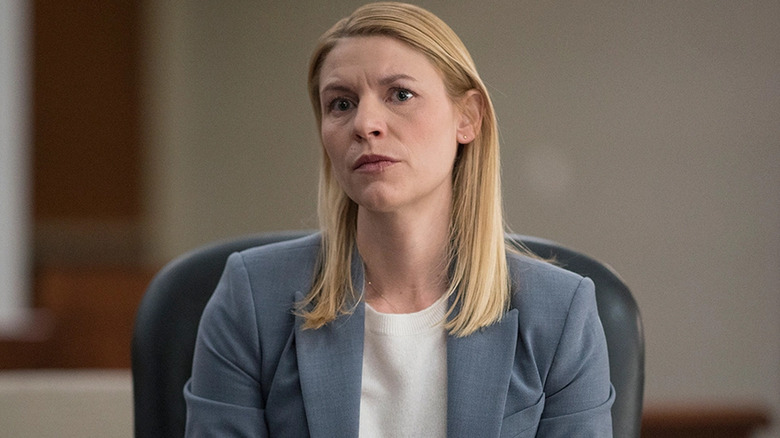
Ever since its inception, "Homeland" has been a complicated show to digest. Not necessarily in terms of story structure, but the thematic elements that accompany it. "Homeland" followed Claire Danes as Carrie Mathison, a CIA officer that often found herself at the center of a national conspiracy and/or in the midst of international espionage. Carrie was a gifted government agent whose intelligence and quick wits usually outsmarted anyone in her path. However, Carrie struggled with bipolar disorder and had been medicated since a young age. To that point, her mental condition served as a point of contention in debates surrounding "Homeland."
While some debated the legitimacy of Danes, who is not bipolar in real life, representing the disorder in the fictitious scenario, "Homeland" did not take the opportunity for granted. Carrie's personal story always contended with her bipolar condition, whether it destabilized her life or otherwise. Of course, I can't personally speak to the accuracy of her performance, as I am not a bipolar person. However, the actress made sure to do her homework and not treat it as a gimmick. Danes was always keen on using bipolar disorder as a vital part of the character, and not a strictly narrative device used to create drama.
Not A Gimmick
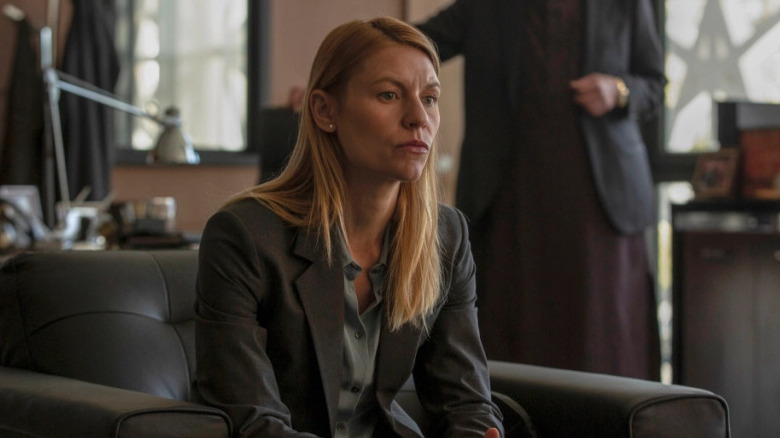
In an interview with the Guardian, "Homeland" star Claire Danes discussed bringing bipolar disorder to the drama series without using it as a gimmick:
"They've been mostly appreciative, which I feel great relief about and gratitude for. That condition is not dramatised all that often so I think any conversation that's stimulated by it is welcome. I never wanted her being bipolar to be a gimmick or just a convenient plot device, and I tried to be as specific and informed as possible. It's a really fascinating human condition. I developed such respect for people who work as diligently as they do to just make it through a day."
For the better part of the Showtime series, Carrie was shown dealing with her bipolar disorder as she conducted her professional business. In fact, Carrie would at times stop taking the medication prescribed to her because she thought the condition made her mind even sharper. But her bipolar disorder spread into other aspects of her life as well. Carrie struggled to become a mother to her child Frannie, which she had with her deceased lover Nicholas Brody (Damian Lewis).
Those closely associated with the aforementioned mental illness have every right to critique its representation in "Homeland." That said, Danes went knee-deep researching the symptoms of bipolar disorder before playing the role.
'I Found Great Material'
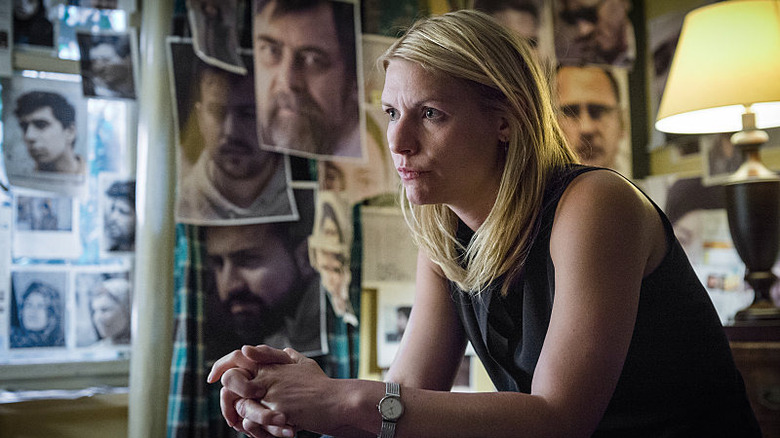
During a discussion with NPR before the second season, Danes revealed she went to YouTube to find and watch copious amounts of bipolar videos:
"I had to do a lot of research for this role. And actually, I found great material on YouTube. There was a lot of footage of people who recorded themselves when they were in manic states. I think they were probably up in the middle of the night and lonely and, you know, needed to talk. So they talked to the camera. So I gorged on sort of manic confessionals on YouTube."
There is a discussion to be had in regard to looking to imitate the symptoms of a bipolar person after watching video footage. Of course, no matter what Danes researched, she could not have felt exactly what a bipolar person felt during those manic states in "Homeland." That said, putting in the work, and understanding the gravity of the role, allowed Danes to take into account the character's unique experience as a bipolar person.
For instance, during the first season, Danes utilized the full spectrum of emotions when outside forces began to discredit her investigative abilities. The season 1 finale scene is memorable because of her harrowing performance and astounding camera work, which never attempted to glorify the bipolar condition. The overall end result — eight seasons in length — can certainly be up for debate. However, it is hard not to admire the moments in "Homeland" that did not try to pass off bipolar disorder as some sort of superpower or portray Carrie as an infallible hero.
Read this next: The 15 Best Horror TV Shows Of All Time
The post Claire Danes Never Wanted Homeland's Depiction Of Bipolar Disorder To Be A Gimmick appeared first on /Film.
Put Skyrim mods aside as Oblivion and Morrowind collide in new project
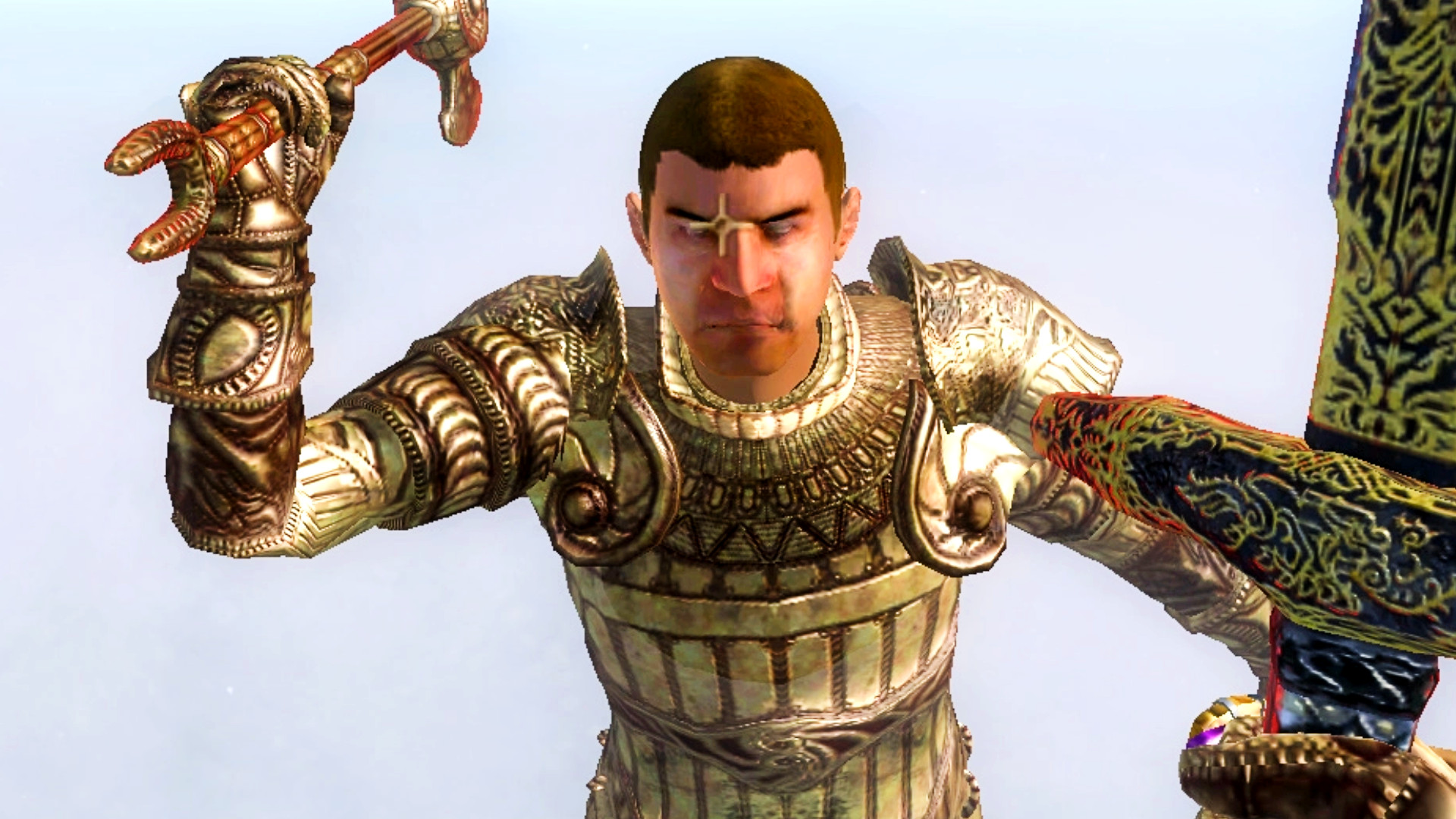
There’s plenty of new Skyrim mods to help fantasy fans pass the time until the next Bethesda games arrive, but the wait for Starfield and The Elder Scrolls 6 release date just got easier thanks to a crossover mod featuring two older entries in the series. Both Morrowind and Oblivion are worthy of their place among the best RPG games of all time, and a new Elder Scrolls mod brings them together in spectacular fashion.
MORE FROM PCGAMESN: Best RPG games, Best games like Skyrim, Elder Scrolls 6 release dateCutting Calories May Slow Aging In Humans, Study Suggests
Read more of this story at Slashdot.
Double Fine's new documentary about making Psychonauts 2 is a must-watch

I like a lot of Double Fine's games, but none as much as I like the documentary which charted the development of Broken Age. I can't get enough of watching funny, smart, creative people work, and Double Fine Adventure offered a one-of-a-kind, candid and thorough glimpse of game development.
It was one-of-a-kind until yesterday, when Double Fine released PsychOdyssey, a 32-episode documentary series charting the creation of Psychonauts 2. Each episode is typically between 20 minutes and an hour long, and I've had a great time watching the first three so far.
Keith David Had To Be Sent To The Hospital On His First Of Day Shooting The Thing
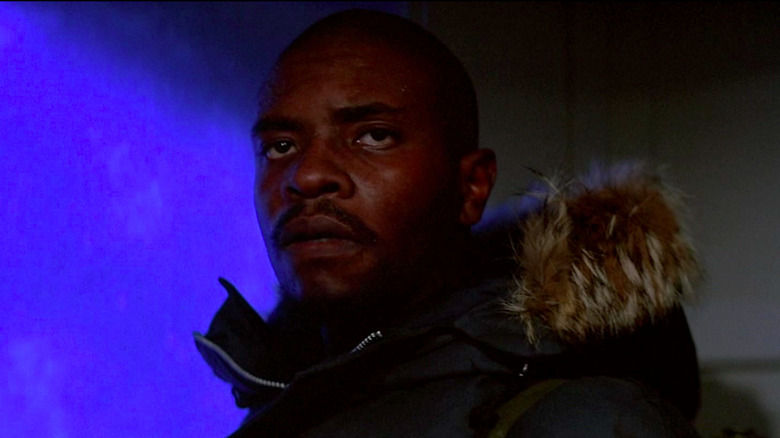
If you're unlucky enough to find yourself stationed at U.S. Outpost 31, there's a good chance you won't make it home in the same body you arrived there in. There's also a good chance you won't make it home at all. That's because U.S. Outpost 31 is home to the creepy, body-stealing alien that terrorized a group of American researchers in John Carpenter's 1982 "The Thing." The film — which is a remake of the 1951 movie "The Thing from Another World" and based on the 1938 novella "Who Goes There?" — initially bombed in theaters, but has gone on to become a beloved sci-fi horror classic, now largely praised for its paranoid atmosphere, awesome special effects, and character-driven plot.
At the start of the movie, there are 12 men living at the Antarctic research station, but by the end, only two remain: R.J. MacReady (Kurt Russell) and Childs who is played by Keith David. It's fitting that these two would be the last left alive at the film's heavily debated ending though, since Childs exists as the natural opposition to MacReady's manic-but-thorough self-proposed leader of the group. Contrary to MacReady, he boasts a stoic demeanor, and though he is a man of few words, that doesn't mean he's lacking in presence. Even when MacReady threatens him at gunpoint during the extremely tense blood testing scene, Childs still maintains his composure while staring down the barrel of the gun. But Childs' tranquility no doubt comes from David, as well, who, after getting into a car crash right before filming was supposed to start, decided to forgo going to the hospital in favor of showing up on set the next morning, ready to work.
Not In Much Shape To Do Anything About It
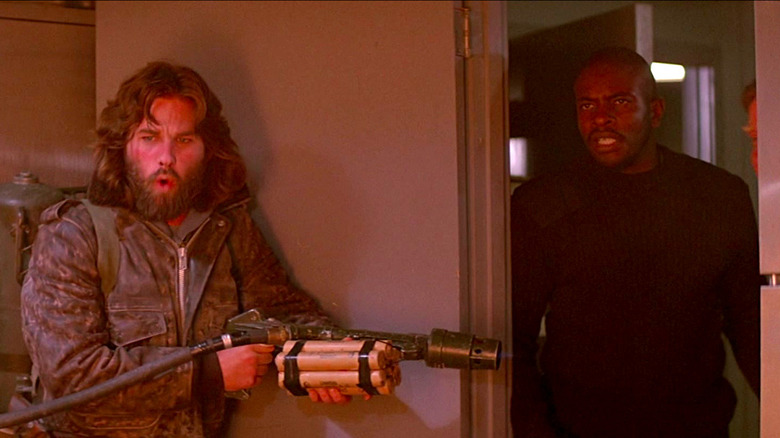
In a brief oral history about "The Thing" for LA Weekly, Keith David explained how the car crash complicated the initial filming. "I got into a car accident right before my first day of shooting, and I broke my hand," he explained. "By the time I had to be at work in the morning, my hand had swollen up to the size of a boxing glove." Obviously, Childs is not supposed to have a severely swollen hand while battling aliens at Outpost 31, so naturally, David was nervous about showing his real-life injury to director John Carpenter the next day. David said:
"I could see John Carpenter and [producer] Larry Franco on the set, so I tried to hide my hand behind my back. But I couldn't function because it hurt so bad. So, as I walked very slowly towards them, I let my hand drop to my side. Their eyes grew to the size of saucers when they saw my hand. "What happened to you?!" They immediately sent me to the hospital, where they put two pins in my hand."
The injury didn't prevent David from filming, but they did have to come up with clever ways of disguising his hand on set. "I put on a surgical glove to cover my stitches, and put on a black glove over it that was painted to match my skin." David also said that because of his broken hand, "you never see [his] left hand in the first part of the movie." But just like how Childs disappears for a long time in the film's second half, if we're unable to keep an eye on his' left hand from the start, how can we be sure it hasn't been infected by ... the Thing?
Read this next: The 31 Scariest Movie Scenes Ever
The post Keith David Had To Be Sent To The Hospital On His First Of Day Shooting The Thing appeared first on /Film.
The Last Of Us Finally Shows Us How Evil FEDRA Can Be
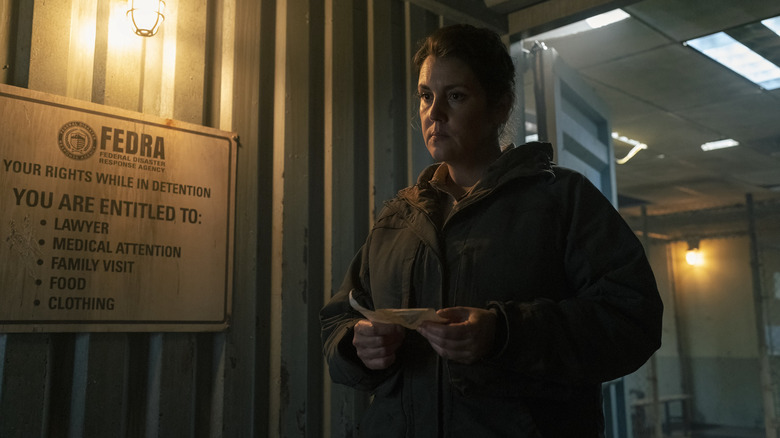
"The Last of Us" is a bit of a deceiving game. At first glance, there doesn't seem to be any immediate thing that separates this from, well, any of the other dozens of zombie shows and movies from the past few decades. This is no groundbreaking mix of genres like "Juan of the Dead," or "Shaun of the Dead," or even an inventive romp like the zombie musicals "Anna and the Apocalypse" and "The Happiness of the Katakuris." The game doesn't necessarily add something drastically new to the mythology of the zombie like the fast zombies in "28 Days Later" or giant mutant ones from "Resident Evil."
And yet, the games, and now the HBO adaptation, take what you know about the zombie genre and make small but significant changes that quickly add up to a very special and unique story. "The Last of Us" is more than a story about surviving the apocalypse, it is a story about connections, about what we do for and to each other, set in a rather bleak world ravaged by terrifying science-based zombies created by a very real infection.
The latest episode also brings back a seemingly small but significant change that makes "The Last of Us" different from other zombie stories — FEDRA. We had heard bits and pieces about FEDRA since the first episode, but kind of glossed over their role in making the post-apocalyptic world of the show suck so much. Now, it is made clear that they are the worst — though their successors are not perfect either.
Fight The Dead, Fear The Living
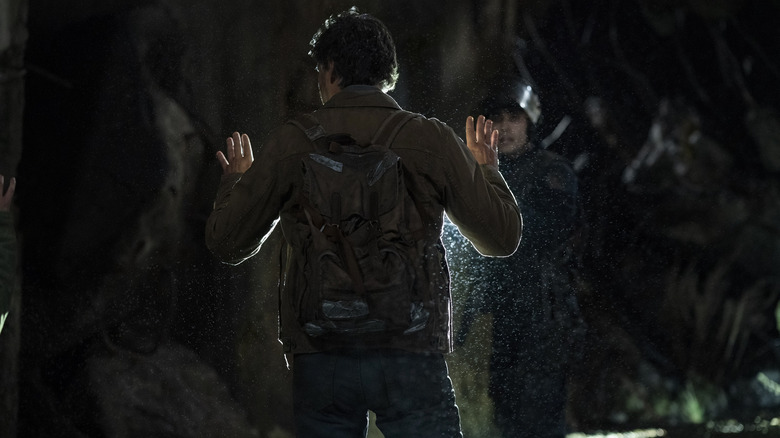
The Federal Disaster Response Agency, also known as FEDRA, is inspired b the real-life Federal Emergency Management Agency (FEMA), which coordinates the response to a disaster on U.S. soil. In the world of "The Last of Us," FEDRA coordinated the response to the Cordyceps brain infection, but it quickly organized a coup, took control of the government and the military, and declared martial law. As we learned in episode 3, FEDRA rounded up survivors across the country and relocated them to Quarantine Zones in the major cities, which they controlled like an authoritarian government.
FEDRA has been a kind of quiet and unseen villain throughout "The Last of Us" so far, with many of their horrors being mostly implied. There was Ellie complaining about poor education under FEDRA, or Bill joking about the government being all nazis. But then there's Joel telling how FEDRA would outright execute healthy civilians if there was no room for them at a QZ, or Ellie saying that she learned to shoot a gun from FEDRA schools.
Episode 5 makes things worse. We learn from Henry and Kathleen that FEDRA used to just kill and rape people for decades in Kansas City. They had citizens inform on their neighbors and loved ones, leading to their executions. After 20 years of hell, no wonder a resistance rose up, with Kathleen leading a militia that took FEDRA down.
And yet, the episode also makes it clear that replacing one dictatorship with another is not good. Kathleen executes all collaborators, and even wants to kill 8-year-old Sam, because of the sins of his brother. This hits at a major theme from the games about abuse of power, and how all types of post-apocalyptic governments inevitably fall to violence and oppression.
A Different Kind Of Apocalypse
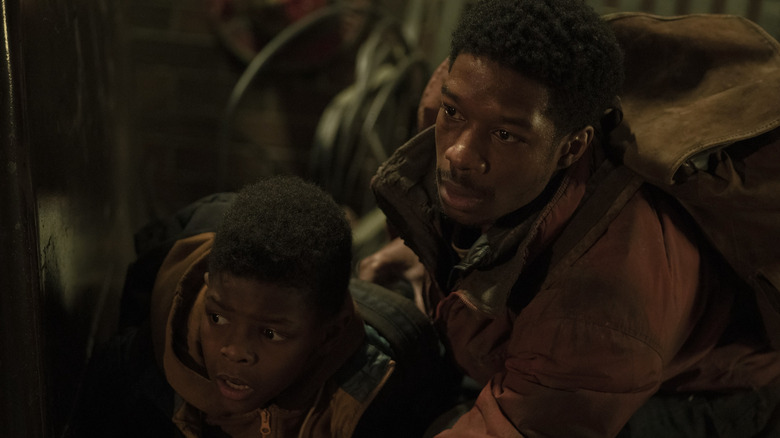
The idea of FEDRA being in charge is one of the many small things that makes "The Last of Us" a different kind of zombie experience. Most zombie movies and shows rarely show the actual government, and when they do, they're very much improvised and makeshift.
More often than not, we see post-apocalyptic settlements led by militias or organized survivors, with movies like "Land of the Dead," and "28 Weeks Later" portraying impromptu governments led by military commanders, with their governments taking unsurprising turns to violence and oppression. In "The Last of Us," however, it is an actual government entity that takes control and quickly falls apart. Granted, by the time we meet them FEDRA is still a military dictatorship, but the idea that it was originally a part of the federal government, not the army, is what makes it stand out.
There's also the idea that, as Joel tells Henry, each city has different levels of FEDRA-led horrors, with Kansas City being a particularly bad place for some reason. This brings to mind the post-apocalyptic world of the "Fallout" games, in which people went underground to avoid the nuclear apocalypse and lived in massive vaults. Soon, it becomes clear that these vaults were not a safe haven, but were instead the home of various sadistic experiments which completely failed and killed most people inside them.
There are many horrors in the world of "The Last of Us," from raiders to the infected, but with FEDRA the show also presents a bigger kind of evil: institutions of power. At least the zombies can't lie to your face and stab you in the back.
Read this next: The Last Of Us Trailer Breakdown: Fireflies, Clickers, And Melanie Lynskey
The post The Last Of Us Finally Shows Us How Evil FEDRA Can Be appeared first on /Film.
